Shipping and Climate Change Part 2
• December 17, 2021: Maritime technology company ZeroNorth has launched its interconnected Carbon Intensity Indicator (CII) analysis and optimisation solution within Optimise. 113)
- The new functionality’s analytics tools will enable users to access real-time monitoring of CII-related performance and simulate a vessel’s future CII rating. Meanwhile, the optimisation solution will enable operators to access recommended voyage routing options to improve or maintain a vessel’s CII rating.
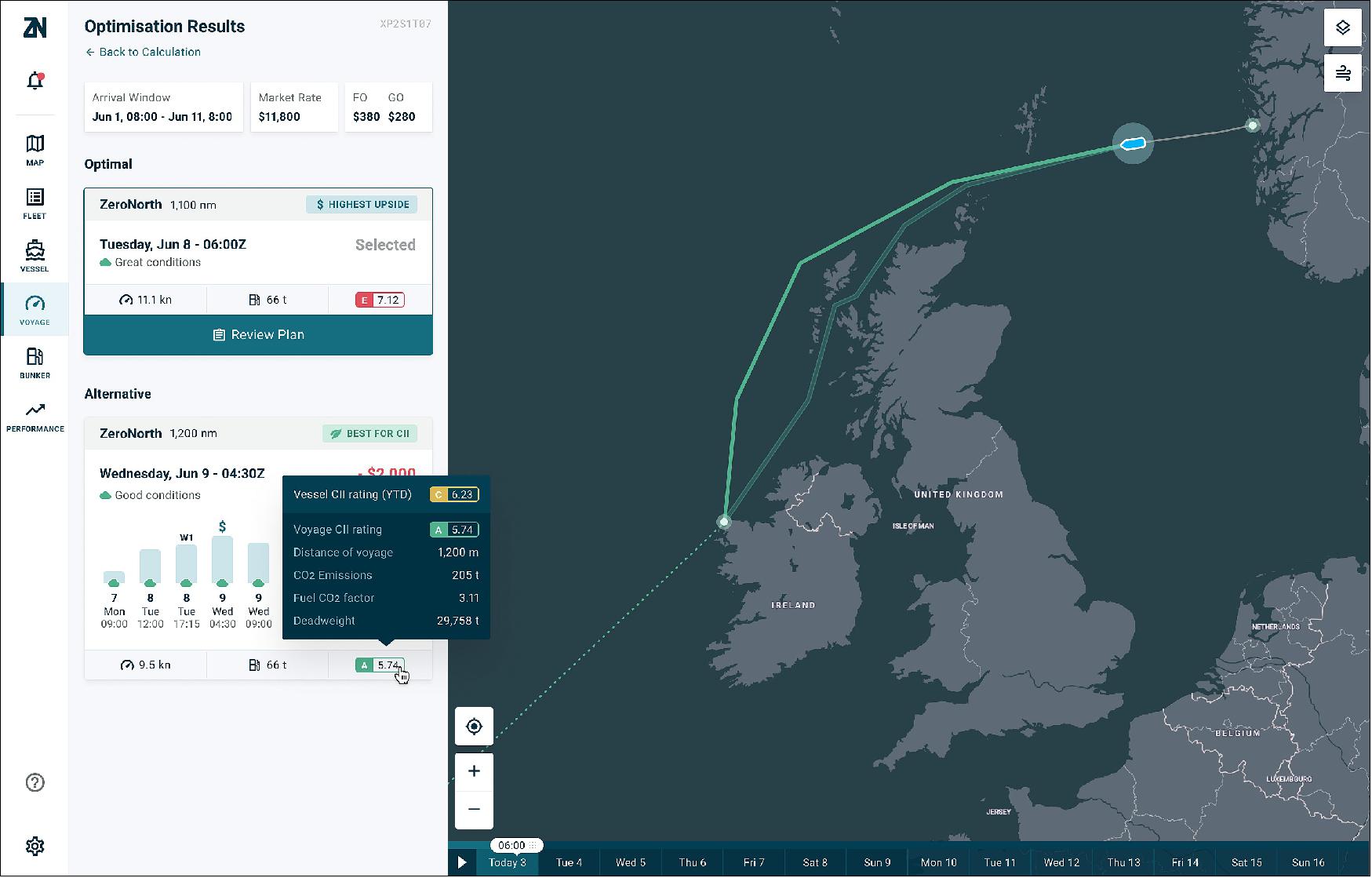
- Because the functionality is integrated with real-time weather route optimisation and voyage optimisation, CII recommendations will be made alongside options that reduce emissions and improve revenue, ensuring that owners and operators maximise their competitive advantage.
- The service will be the most comprehensive CII offering on the market to date. It will consider necessary vessel factors, such as type and deadweight tonnage, to provide a CII rating for the year-to-date, as well as year-by-year performance, monitoring and alerts for when a vessel is at risk of becoming non-compliant.
- By combining in-depth analysis of all the factors affecting voyage and vessel performance with sophisticated algorithms and human expertise, owners and operators will be provided with an informed decision-making platform to either sustain or improve their vessels’ CII ratings whilst maintaining a focus on commercial performance. The data will also be available for owners and operators to distribute via an API or in file format.
- The offering has been developed in line with the International Maritime Organization’s (IMO) rules on Carbon Intensity Indicator (CII) reporting. Introduced by the IMO at its 76th Marine Environment Protection Committee (MEP76), CII will be implemented in 2023 to support the IMO’s longer-term objective of reducing the carbon intensity of international shipping by at least 40 percent by 2030, compared with 2008 levels.
- A vessel’s CII rating will be derived from the Annual Efficiency Ratio (AER), which measures the carbon emissions of a ship’s operations over the course of a year and applies to vessels at 5000GT and above. The ranking is measured on an A – E scale, with the most operationally efficient vessels receiving an A rating. Ship owners and operators will be required to record their vessel data via a vessel’s Ship Energy Efficiency Management Plan (SEEMP). In the case that a vessel is rated D or E, a plan of action must be submitted on SEEMP outlining how the rating will be improved.
- Over time, ZeroNorth will iterate and update its CII analysis and optimisation solution proactively and in line with any amendments made by the IMO to CII legislation, to ensure the calculation continues to be accurate and considers all of the baseline factors that influence CII ratings.
- Søren Christian Meyer, CEO, ZeroNorth, said: “As shipping becomes increasingly influenced by charterers, shippers, institutions and consumers seeking to be more sustainable and meet decarbonisation targets, vessels with a low CII rating will cease to become commercially attractive. Ship owners and operators must therefore look to sustain or improve operational efficiency or risk their commerciality.
- “Through our new CII analysis and optimisation offering, we can help support owners and operators with managing the transition and enable them to proactively implement plans to help them improve revenue and reduce their emissions, so it’s good for both profit and the planet. Our offering is unique in its depth of analysis and comprehensive level of integration.”
- Pelle Sommansson, CPO, ZeroNorth, said: “We are proud to announce the launch of our new CII analysis and optimisation service, which will enable our users to intelligently route against USD, emissions, and now CII objectives. With the rating thresholds set to become increasingly stringent towards 2030, doing nothing is not an option if owners and operators want their vessels to remain commercially viable. By using ZeroNorth, you are preparing for a profitable and sustainable future.”
• December 17, 2021: The Maritime Technologies Forum (MTF) has unveiled a framework designed to empower decision-makers in shipping to holistically assess and compare decarbonisation technologies and low to zero-emission energy carriers. 114)
- The current phase sets out the areas for assessment and comparison and will be built on in the second phase to identify optimal assessment methodologies. The MTF believes this framework will be particularly beneficial when industry is researching new technologies for decarbonisation.
- The vision of the framework is to provide a shared agreement as to key assessment criteria, while also raising awareness of technologies and energy carriers as a result of assessment.
- The new framework takes wider sustainability aspects into account, also recognising that solving the issue of decarbonisation should not lead to unacceptable impacts on other areas such as safety, security and economic feasibility. In publishing this framework and in line with the collaborative approach to solving future challenges, MTF welcomes feedback from across the industry on this concept paper.
- Identifying the best solutions for long-term application in shipping with no detriment to the planet or society, in line with the UN Sustainable Development Goals, is a big challenge for the maritime industry. Getting this decision-making wrong could lead to non-compliance resulting in stranded assets down the line. The work of the MTF is looking beyond just alternative fuels, and also factors in all relevant decarbonisation technologies and solutions, as well as their production and disposal.
- The MTF framework takes into account all criteria relevant to achieving sustainable outcomes including technology status, environmental sustainability, safety, security, regulations, people, engineering and economic feasibility. It can be used for a singular assessment, or for comparison between multiple technologies or energy carriers. Assessments can also be carried out in a repeatable, consistent way, as well as to assess a complete system or sub-system.
- The framework adopts a Systems Engineering approach that embraces the full lifecycle of technologies and alternative energy carriers under assessment. A through-life assessment is crucial because a new technology or energy carrier may often have lifecycle factors that could inadvertently create other problems while solving the current one. As such, the framework will provide an enduring model that can be applied even beyond today’s focus on emissions, helping to ensure a fleet or vessel’s future competitiveness and compliance.
- A spokesperson for the MTF said: “This project is merely the beginning. The paper signals the strategic direction of the MTF’s work to help move towards a sustainable future for shipping. Evaluating and managing the risk posed by decarbonisation technologies is a big part of that effort. Our next priority will be to identify specific methodologies for assessment and comparison, and here we believe the MTF can bring real lasting value, in line with our mission to foster sustainable and environmentally friendly technologies in the maritime sector.”
• December 16, 2021: Emirates Shipping Line and Peter Döhle have partnered with Nautilus Labs to reduce their carbon footprint while increasing voyage profitability and operational efficiency. 115)
- Dubai headquartered Emirates Shipping Line was looking for a solution that would enable the company to increase voyage profitability and reduce CO2 emissions.
- Germany-based shipowner Peter Döhle was looking to optimise vessel performance and to enhance open exchange and analysis of vessel data accompanying the requirements of its customers.
- The companies identified Nautilus Labs as their solution to improve collaboration and transparency across teams and stakeholders and to technically advance the vessels’ data collection capabilities.
- The partnership began in June 2021 with the goal to reduce fuel consumption and emissions while improving voyage economics.
- Leveraging high-frequency sensor data, Nautilus Labs automates high-fidelity machine learning models to unpack precise vessel performance and provide a predictive decision support tool. Emirates Shipping Line and Peter Döhle implemented Nautilus’s Voyage Optimisation to act on optimal dynamic operating recommendations during a voyage to minimise greenhouse gas emissions and maximise economic returns.
- “For our teams at Emirates Shipping Line, it’s important to understand true vessel performance and work with a solution that delivers highly accurate models,” said Willem Bekooy, vice president of operations at Emirates Shipping Line. “In Nautilus, we found a provider that helps us strengthen the relationships with our partners — enabling both parties to access a centralised technology platform that allows us to monitor, track, and improve fleet performance and efficiency. By adopting a data driven partnership approach through Nautilus’s Voyage Optimisation, we are working towards increased sustainability and profitability.”
- Johann Diercks, director of ship management at Peter Döhle said: “Peter Döhle supports increased visibility across teams and stakeholders. Our masters receive operating recommendations and have access to Nautilus Platform and are able to review the vessel’s performance profile and make the best informed decisions, to optimise for fuel consumption while ensuring just on time arrival. Nautilus Platform supports us and our crews to meet the requirements of our customers to operate their vessels as cost and fuel efficient as possible and to reduce the emissions of our operated fleet. We’re looking forward to a continued partnership with Emirates Shipping Line and Nautilus Labs.”
- “At Nautilus, we strongly believe in data-driven collaboration to uncover better outcomes,” commented Matt Heider, CEO at Nautilus Labs. “We’re excited to work with Emirates Shipping Line and Peter Döhle, supporting the relationship between the two companies as the source of truth. Given upcoming regulations aimed at reducing carbon intensity it is essential for charterers, owners, and managers to work together in order to drive operational excellence and stay ahead of the competition.”
• December 15, 2021: French wind propulsion tech company Airseas has completed the first installation of its automated kite Seawing on a commercial vessel chartered by Airbus and operated by Louis Dreyfus Armateurs. 116)
- The Seawing system has been installed on the ro-ro vessel, the Ville de Bordeaux, which transports major aircraft components between France and the United States. The vessel will complete six months of sea trials and testing with the 500m2 Seawing from January 2022, ahead of its full operation.
- Airseas’ full-size Seawing is a 1000 m2 parafoil which flies at an altitude of 300 meters, capturing the strength of the wind to propel the vessel. Based on modelling and preliminary testing on land, Airseas estimates that the Seawing system will enable an average 20 percent reduction in fuel consumption and greenhouse gas emissions.
- Founded by former Airbus engineers, Airseas is unique in its integration of expertise from the aeronautical sector, including digital twin and automation technology, to the maritime industry. This means that the Seawing can be safely deployed, operated and stored at the push of a button, and can be retrofitted on a ship in two days.
- Airseas has received formal approval from Bureau Veritas to begin operations at sea, following three years of close collaboration on the development and early trials of the Seawing.
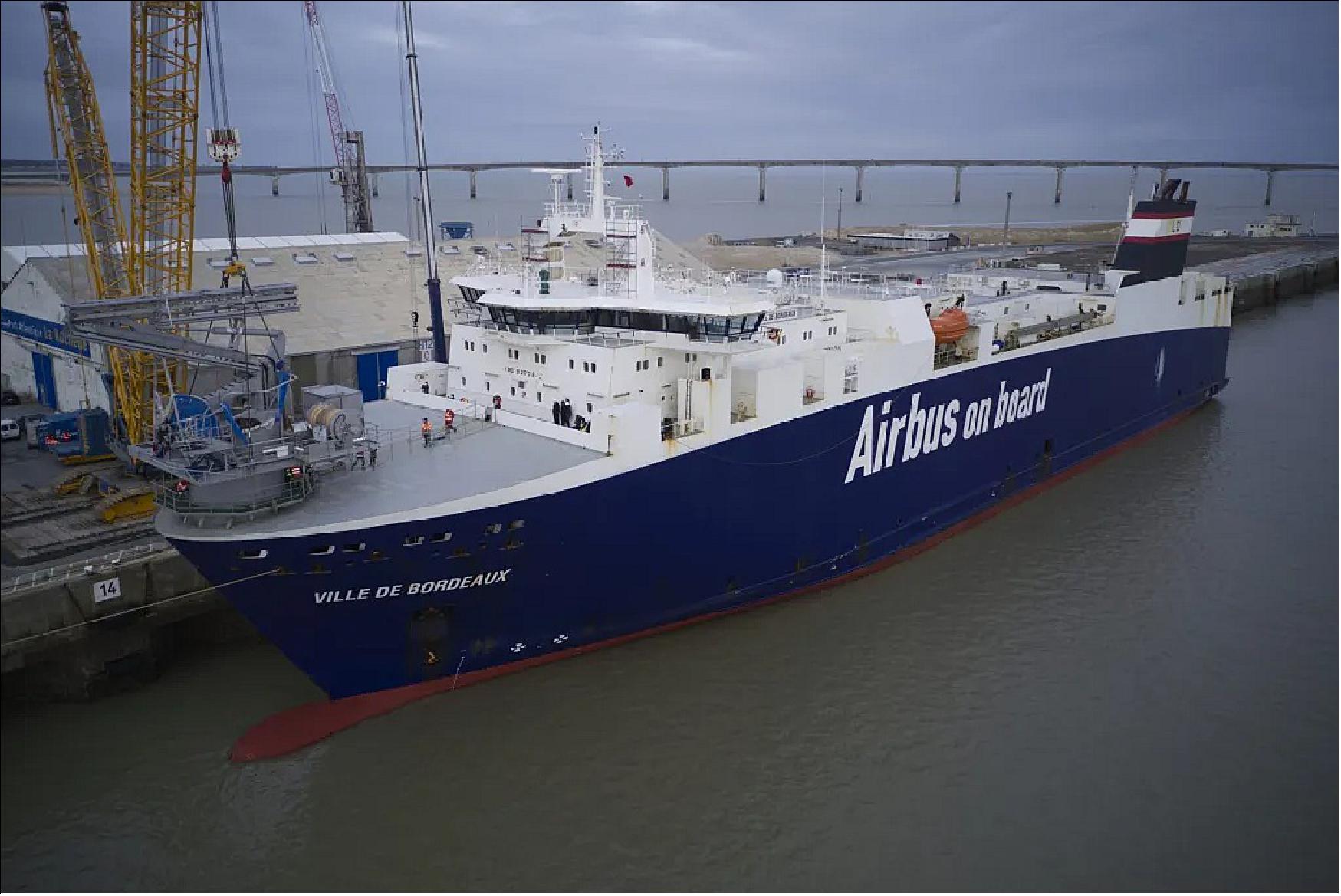
- Vincent Bernatets, CEO and co-founder of Airseas, said: “A decade ago, we embarked on the ambitious project of channelling our unique aviation expertise towards creating a cleaner and more sustainable shipping industry. Today, I am beyond proud to see that vision becoming reality, with our first Seawing ready to make a tangible difference for our planet. This first installation marks a significant milestone not only for Airseas but also for wind and other renewable propulsion technologies in general. Given the urgency of the climate crisis, the world needs to see a drastic reduction in carbon emissions now. In shipping, we can achieve this by using the full set of tools we have available to us today. Wind propulsion is one of these and will play an essential role in helping shipping achieve its much-needed decarbonisation transition.”
- Laurent Leblanc, senior vice president technical & operations at Bureau Veritas Marine & Offshore, said: “This important milestone follows three years of close and fruitful collaboration on the development and early trials of the Seawing, supporting Airseas’ safety-first approach and validating the reliability of the system. As a class society, Bureau Veritas has a key role to play to support safe innovation, and this is why we have developed comprehensive rules on wind propulsion systems earlier this year. At BV, we are dedicated to help the maritime sector navigate the challenges of the energy transition, and we fully believe that wind propulsion technology represents a key opportunity to start decarbonising the maritime sector immediately.”
• December 9, 2021: A new report by the University Maritime Advisory Services (UMAS) for the Environment Defense Fund Europe (EDF Europe) stresses the need to refine the design of the EU Emission Trading System’s (ETS) inclusion of shipping to effectively reduce greenhouse gas (GHG) emissions from maritime shipping and advance zero-carbon alternative fuels. 117)
- Reforms to its design such as an expanded scope, a sectoral emissions cap, and reinvesting revenues in shipping decarbonisation would all help build a stronger system able to generate meaningful emissions reductions in this decade.
- The new report, titled “Harnessing the EU ETS to reduce international shipping emissions”, assesses some of the economic impacts most pertinent for understanding the potential for the EU ETS to reduce international shipping emissions and stimulate investment in zero-emissions fuels. The EU ETS is the Union’s flagship cap-and-trade mechanism that has been in operation since 2005 to promote the reduction of GHGs across the EU.
- The EU’s proposal to include shipping in the EU ETS is a positive step to ensure that a portion of the global shipping industry is subject to a carbon price this decade — a key time period for the decarbonisation of shipping. However, the report finds that in its current proposed format, the EU ETS’ extension to global shipping may not contribute to significant emissions reductions or incentivise investment in Scalable Zero Emissions Fuels (SZEF). SZEF are a subset of fuels with the potential to produce zero emissions throughout their lifecycle and that have scalable production processes, capable of competitively supplying shipping’s expected future demand.
- In addition to fuel and infrastructure policies, a higher carbon price is needed to incentivise crucial efficiency improvements while making nascent zero-carbon fuels more attractive. The study found that the EU ETS carbon prices, even at the record levels of €67.75/tonne CO2 observed recently, would not make a significant impact to close the gap between fossil shipping fuels and zero-carbon fuels. Recent analysis by UMAS for the Getting to Zero Coalition shows that an average carbon price of just under US$200/tonne CO2 is required to fully decarbonise the shipping sector by 2050.
- The report also stresses the potential benefits of widening the scope of the scheme’s emissions coverage. The EU’s current proposal aims to cover maritime emissions from voyages within the European Economic Area (EEA) and half of the emissions from voyages into and out of the EEA from the rest of the world. Because vessels that trade internationally such as bulk carriers, containers, and tankers spend little time sailing within the EEA, the international or extra-EEA coverage is important to the success of the scheme. Further extending ETS scope from 50 to 100 percent of extra-EEA voyages could increase the emissions covered under the system by 70 percent.
- Even under the full scope, the EU ETS may not provide a sufficient price incentive to drive investments in energy efficiency measures or SZEF. This is because most EEA related emissions come from ships which spend a relatively short period of time on EEA-related voyages during the year. Considering this annual trading pattern of ships, the average ‘effective carbon price’ (in the 50 and 100 percent extra-EEA voyages) is well below the historical variability in bunker fuel prices, when averaged across all ship types. For example, under a $103/tonne-CO2 price scenario in 2030, the average effective global price reduces to $22/tonne-CO2 or about 20 percent of the ETS price level because the majority of EEA-related emissions come from ships which spend a relatively short period of time on EEA-related voyages during the year.
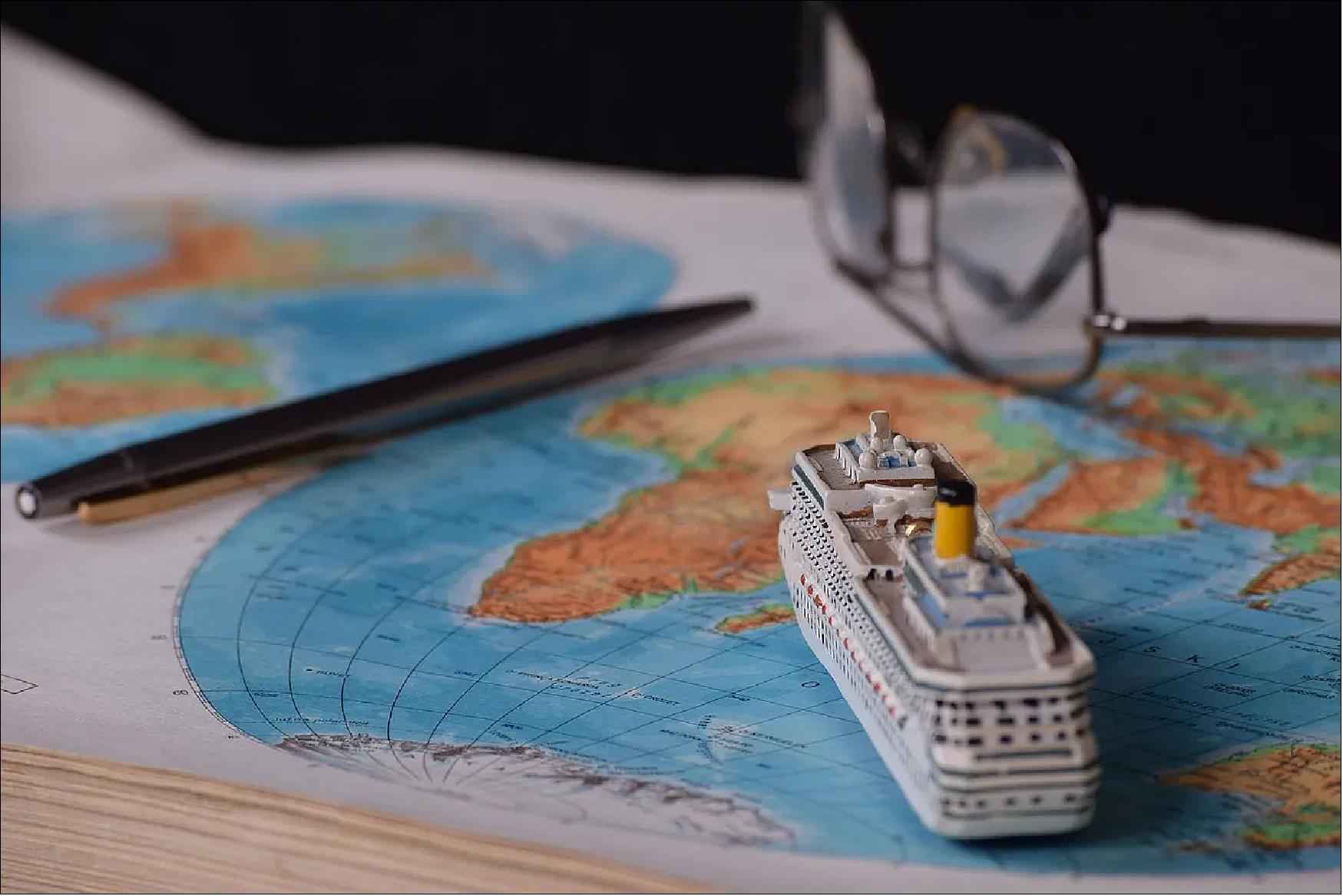
- In its current form, the low carbon price may lead to insufficient or unintentionally harmful outcomes. The price could incentivise purchase of allowances in the ETS market and potentially lead to some speed reduction on voyages with the EEA, which can help generate revenue and fuel savings but are not enough to drive significant emissions reductions. Additionally, the low-price level and the exemption of methane emissions from the EU ETS could incentivise the uptake of LNG-fuelled ships, which can lead to environmental and policy cost-effectiveness risks.
- A reform for consideration is the use of sector-specific caps on emissions. As a cap-and-trade system, the EU ETS has an overall emissions cap that applies to all sectors in the system combined rather than on individual sectors. It is this ‘hard cap’ that ensures that across the ETS sectors, emissions decline at a linear rate consistent with the EU’s climate targets. Implementing a sectoral cap on shipping emissions could support in-sector decarbonization more directly.
- Dr Sophie Parker, principal consultant at UMAS, lead author of the report said: “The shipping sector’s high abatement costs point to the need for an ETS which is tailored to support in-sector abatement. In the absence of a global carbon price, this could come from either a shipping ETS that places restrictions on the purchasing of out-of-sector allowances or coupling the EU ETS proposal with supply-side policies like subsidies which incentivise the uptake of scalable zero carbon fuels.”
• December 9, 2021: Berkeley Marine Robotics (BMR) has been awarded an innovation research grant (SBIR) by the National Science Foundation (NSF) to conduct R&D and field demonstration of an autonomous underwater swarm robotic system. The system will be able to perform rapid automated inspections under ships to assess hull biofouling and detect invasive species. 118)
- Rising water temperatures from climate change has exacerbated the extent of fouling. As modern ships need to maintain their speeds to reach destinations on tight schedules, the hull fouling leads to increased fuel consumption and thereby higher greenhouse gas emissions. Hull-fouling can also include marine invasive species that hurt coastal ecosystem near ports and cause negative economic impact in sensitive regions.
- BMR is working on an innovative system of autonomous swarm control and underwater wireless communication to enable fast, low-cost, and automated inspections of all ships coming into a port.
- The unmanned system will measure and track hull-fouling levels to optimise cleaning schedule and increase coating performance.
- Simultaneously, the system scan can flag invasive species to the ports and thereby reduce costly delays in manual spot checks. BMR’s objective is to enable shipping operators in reducing their fuel costs and to help them comply with International Maritime Organization’s (IMO) stipulated goal for carbon emission reduction.
- This project’s technical lead is BMR’s co-founder and CTO Alexandre Immas, a PhD in marine robotics from UC Berkeley with engineering degrees from École Polytechnique and experience in offshore deep-sea wind turbines. BMR is led by co-founder CEO Sushil Tyagi, a Wharton MBA in finance and strategic management, and previously a marine engineer at Exponent after degrees in naval architecture, marine physics, and ocean engineering from I.I.T. Delhi, RSMAS, and UC Berkeley.
- As grant awardee, BMR meets the NSF program’s objectives to support innovative technologies that show promise of socio-economic impact. Grant is awarded to businesses with scientific solutions that have potential for commercial success and undergo rigorous merit-based review process.
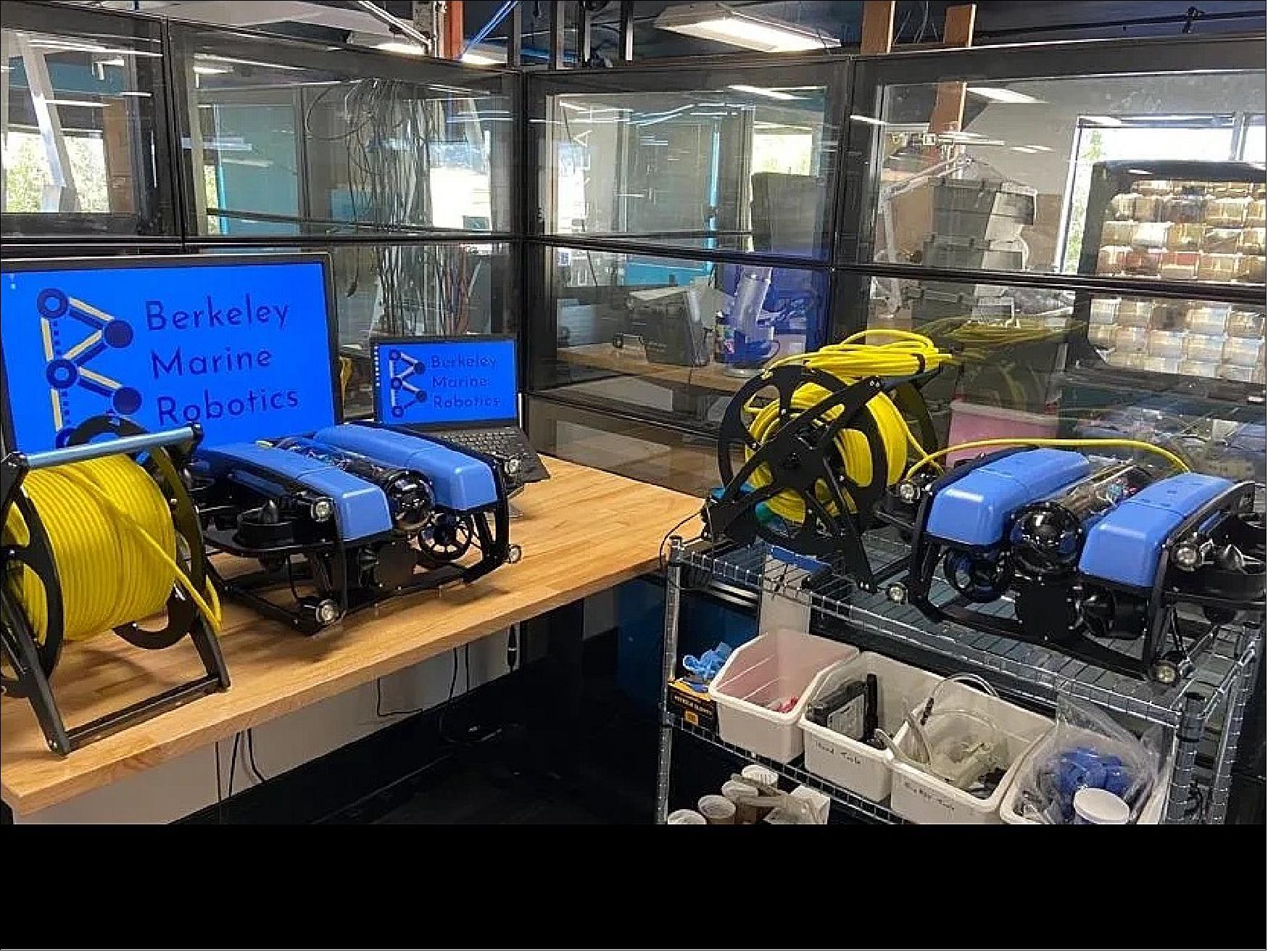
• December 9, 2021: A project that will decarbonise shipping by enabling key technology symbiosis on real vessel concept designs is making headway. The EU Horizon 2020-funded project known as Project CHEK, aims to achieve zero-emission shipping by reconfiguring the ways ships are designed and operated. 119)
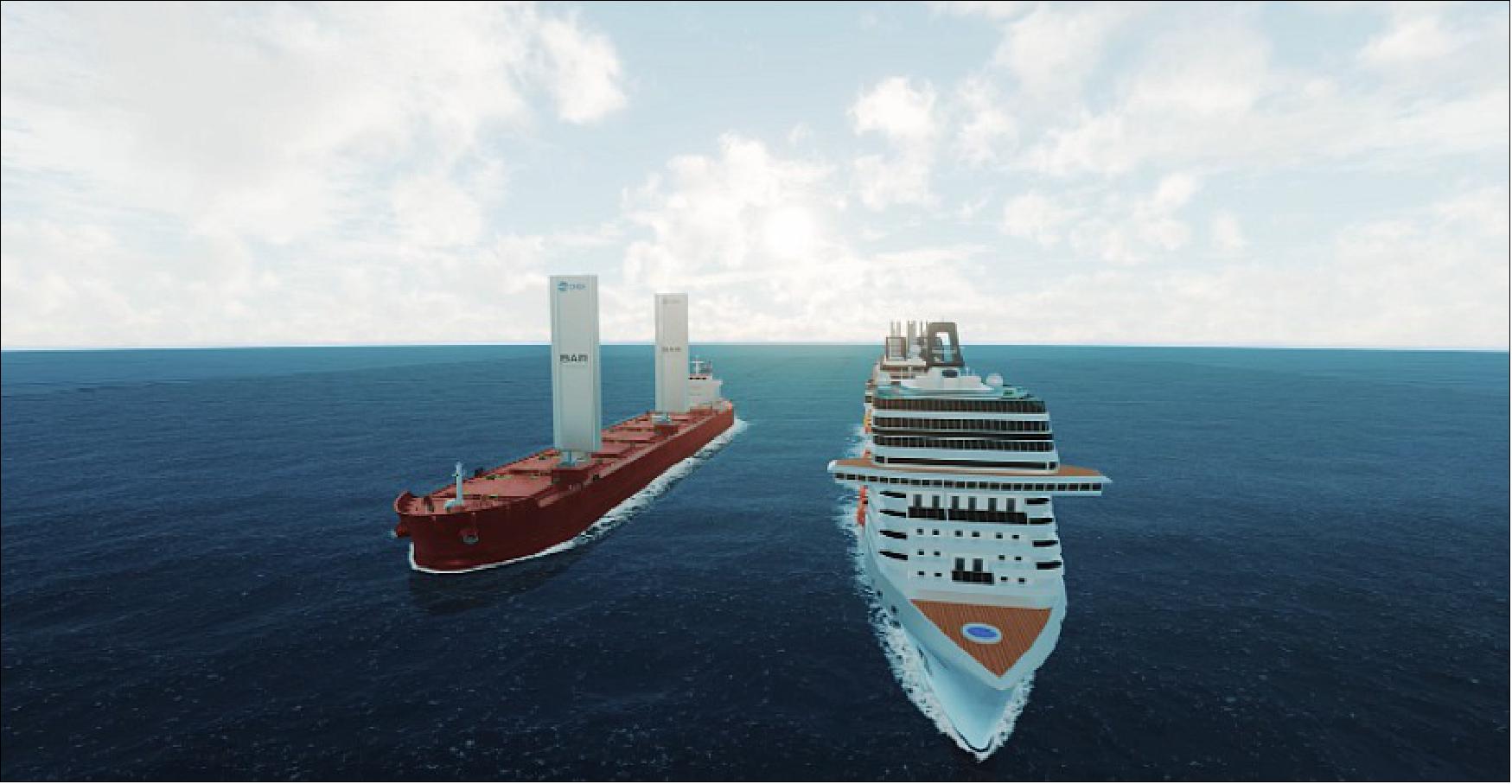
- The CHEK consortium is led by the University of Vaasa (Finland), and the other project partners include WMU, Wärtsilä, Cargill, MSC Cruises, Lloyds Register, Silverstream Technologies, Hasytec, Deltamarin, Climeon and BAR Technologies.
- The project focuses on bringing together design optimisation and a combination of innovative energy technologies that operate in symbiosis to reduce greenhouse gas emissions by 99 percent, achieve at least 50 percent energy savings and reduce black carbon emissions by over 95 percent.
- The key technologies include sail power, hydrogen propulsion, waste heat recovery, battery electric power, hull air lubrication, innovative anti-fouling technology and digital operational improvements. Some of the technologies will be demonstrated at full scale with two unprecedented vessel designs ‒ an energy-optimised bulk carrier and a hydrogen-powered cruise ship ‒ that are based on real operational profiles.
- Deltamarin plays a central role in the project, including the CHEK case vessel design and digital modelling. The case ship modelling and optimisation are performed in various generations from “digital prototypes” to “digital twins”, including realistic operational profiles, recorded from existing ships. The final outcome of the project will be a “future-proof ship design platform” that is suitable for all major ship types, not limited to the CHEK case vessels alone. The starting point for the technical development is Deltamarin’s digital modelling toolbox including DeltaSeas and DeltaKey, backed up by optimisation methodology developed in the past by both Deltamarin Poland and Deltamarin Finland. Examples of the recent optimisation work were reported in development project INTENS.
- In the coming months, CHEK will focus on preparing for its real vessel demonstrations. The two CHEK vessels will start sailing at the end of 2022 and will have completed their journeys by 2023. - Project CHEK is expected to be completed by June 2024.
• December 3, 2021: PROW Capital B.V. (Amsterdam) has announced the launch of the green shipping fund (GSF), a EUR 420 million debt fund that provides credit to shipowners for investments in new and existing vessels or retrofits that demonstrate measurable emissions reductions. 120)
- The funding of GSF has been structured and arranged in close cooperation with Banco Santander and supported by FPG AIM (FPG AIM is a global financial services company).
- The maritime industry needs significant investment to accelerate its transition to a zero emissions industry, on top of the investment needed to meet the increasing demand for seaborne transportation. PROW Capital’s ambition is to make zero emissions shipping a reality and become a viable long-term financing alternative for vessel owners that complements traditional bank financing in the maritime sector.
- To qualify for GSF financing, vessels must outperform relevant emissions regulations. With an average loan size of EUR 15 – 50 million and strict eligibility criteria, GSF provides competitively priced pre- and post-delivery senior secured debt financing to short- and deep-sea vessel owners located in Europe.
- For investors, GSF provides investments with impact, generating significant emissions savings, an appropriate risk adjusted financial return and supports investors’ corporate, social and environmental commitments. PROW Capital monitors vessel emissions data and transparently reports independently validated CO2, NOx, SOx and PM emissions reductions.
- PROW Capital was founded in 2020 by a team of maritime technology, finance and sustainability professionals. PROW is based in Amsterdam, the Netherlands, and is registered by The Dutch Authority for Financial Markets (AFM). PROW Capital is a member of the Getting to Zero coalition.
- We are driven by the scale of the impact we can make. Against a backdrop of worldwide deleveraging, retrenchment of sector banks and increasing international urgency to tackle climate change, we are providing a new approach to ship financing, working collaboratively to deliver green deals to meet the industry’s drive to reduce its impact on the planet,” said PROW’s Menno van Lacum.
- Royal Association of Netherlands Shipowners’ (KVNR) Annet Koster said: “Shipowners are increasing their sustainability efforts to reduce GHG emissions of their fleets, but they need more access to finance. Not only in the Netherlands, but across Europe. Alternative finance is needed to accelerate and reach climate goals. PROW Capital entering the market offers just that”.
• December 3, 2021: Kongsberg Maritime has celebrated a world first by testing and verifying a full-scale, full-size, zero-emissions drivetrain powered by hydrogen fuel cells designed for ships and ferries. 121)
- The project demonstrates that the technology is now mature for using hydrogen (H2) as an energy carrier.
- The program is the third and final part of the EU funded project “HySeas” which has been running since 2013 to prepare and demonstrate a scalable hydrogen system for ships and ferries. Kongsberg Maritime has been the technical lead of the project, which has involved participants from Scotland, Denmark, France, Germany, Sweden and England.
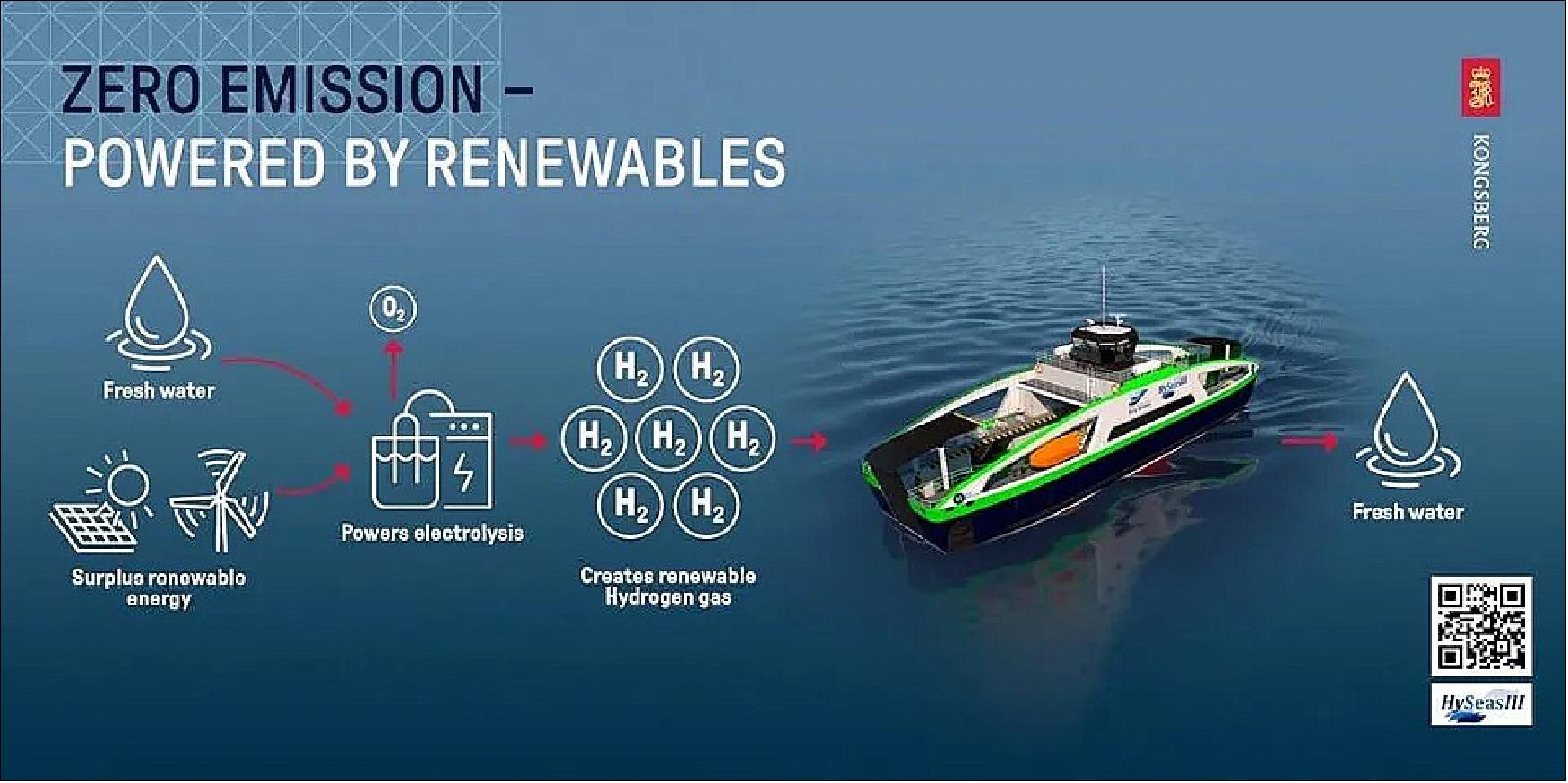
- The system will now undertake a 4-month testing program for validation purposes with the aim of verifying the final design for an H2-powered RoPax ferry. The drivetrain testing is intended to demonstrate the ease with which H2 fuel cells can be successfully integrated with a proven marine hybrid electric drive system.
- The testing mirrors the operational loads which would be experienced by a vessel on a route between Kirkwall and Shapinsay in Orkney. It will confirm safe operation and power and fuel capacity requirements, together with other valuable information to feed back to the vessel design team at Caledonian Maritime Assets (CMAL) in Scotland. CMAL plans to complete the design in March 2022. Hydrogen fuel will be generated through wind power at the ferry port.
- “If we are to succeed with hydrogen investment in Norway, both to reduce national emissions and create new, green and sustainable jobs, we are dependent on being able to show complete pilots on a full scale. This means that the next step will be to show the technology in operation, and then quickly put in place the surrounding infrastructure. Orkney will be the first practical usage of this technology while the Norwegian maritime cluster has the opportunity develop our own pilots and projects here in Norway”, said Egil Haugsdal, CEO of Kongsberg Maritime.
- The full scale HySeas III test was launched at the Kongsberg Maritime facility in Ågotnes, Norway on December 1st 2021.
• December 3, 2021: ABS, NYK (Nippon Yusen Kabushiki Kaisha)shipping and logistics company, the Monohakobi Technology Institute (MTI) and WinGD have launched a modelling and simulation project to evaluate the impact of new technologies on a pure car and truck carrier (PCTC) design. 122)
- The joint development project (JDP) will build a detailed digital model of the vessel’s hybrid propulsion and electrical generation and distribution system to allow high fidelity simulation of the potential for greenhouse gas (GHG) reduction and optimisation of the vessel’s propulsion and electrical plant. Understanding of the vessel’s real-world sea-keeping performance will be developed through simulations utilising meteorological data to recreate a range of conditions experienced at sea.
- The JDP will see NYK provide vessel data for MTI’s integrated model of hull hydrodynamics, propeller and machinery models. WinGD will provide a machinery model and ABS will provide technical expertise and guidance, including verification of the modelling and simulation in accordance with a framework to be developed by ABS.
- At ABS we can now use advanced simulation and modeling to assess new concepts in design, engineering and operations while a vessel is in its design stages, allowing ship owners and shipyards to make more informed decisions. We are proud to be able to support this important project with our industry-leading experience in this space,” said Patrick Ryan, ABS senior vice president, global engineering and technology.
- Further potential GHG reduction by the well-integrated combination of the two-stroke engine and battery is expected once a design for actual sea conditions is implemented. Virtual application of such new system prior to decision-making will accelerate advances in vessel energy efficiency, which is greatly needed for the transition to clean but low energy density fuel,” said Tetsuya Kakinuma, NYK ship planning team deputy manager.
- “As the complexity of ship systems increases, the importance of simulation in the early stage increases more and more. This JDP is a milestone project for us in that the user of such systems gets involved in the design stage and pursues higher energy efficiency by utilising integrated simulation technology,” said Ryo Kakuta, MTI simulation team manager.
- “While the two-stroke engine remains essential for deep-sea vessels, it now forms the center of a holistic energy system offering exceptional efficiency benefits which result in lower emissions. That is the ultimate goal across our industry and collaborations such as this, to prove what is possible when we combine expertise and a commitment to sustainability in shipping,” said Stefan Goranov, WinGD program portfolio manager – digital & hybrid.
• December 1, 2021: Alfa Laval and Wallenius have finalised the 50/50 joint venture that will take the Oceanbird wind power solutions from concept to reality. 123)
- Through the joint venture, formally named AlfaWall Oceanbird, the two companies will intensify the development of Oceanbird wind power technology. Conceived by Wallenius, the system for vessel propulsion uses wing sails that have more in common with modern planes than traditional sailing ships. Fully applied it can reduce emissions by 90 percent on the largest ocean-going vessels.
- “COP26 put the need for accessible technology in the spotlight,” said Niclas Dahl, managing director, Oceanbird, who assumed his position on 1 December. “Decarbonising shipping is imperative, and wind is a free source of power with a substantial role to play, and minimum need of infrastructure.”
- Oceanbird was among the winners of the Wind Propulsion Innovation Awards 2021, which was organised by the International Windship Association (IWSA) to promote wind-powered shipping during COP26. Selected by jury as a finalist, Oceanbird carried the Wind Propulsion Products Award category in open voting with 40,000 participants.
- “We’re proud of the recognition from our marine industry colleagues, which confirms that Oceanbird is on the right path,” said Dahl. “As the enthusiasm for wind power grows, we’re moving rapidly to build on what we’ve achieved. Our next wing sail prototype is on the horizon, and we’re on target to have a transatlantic car carrier fully propelled by Oceanbird technology in 2025.”
- Dahl expects further vessel designs and retrofit applications to follow, sooner rather than later. “Wind is an opportunity we must seize now,” he said. “There’s simply no time to waste in phasing out fossil fuels.”
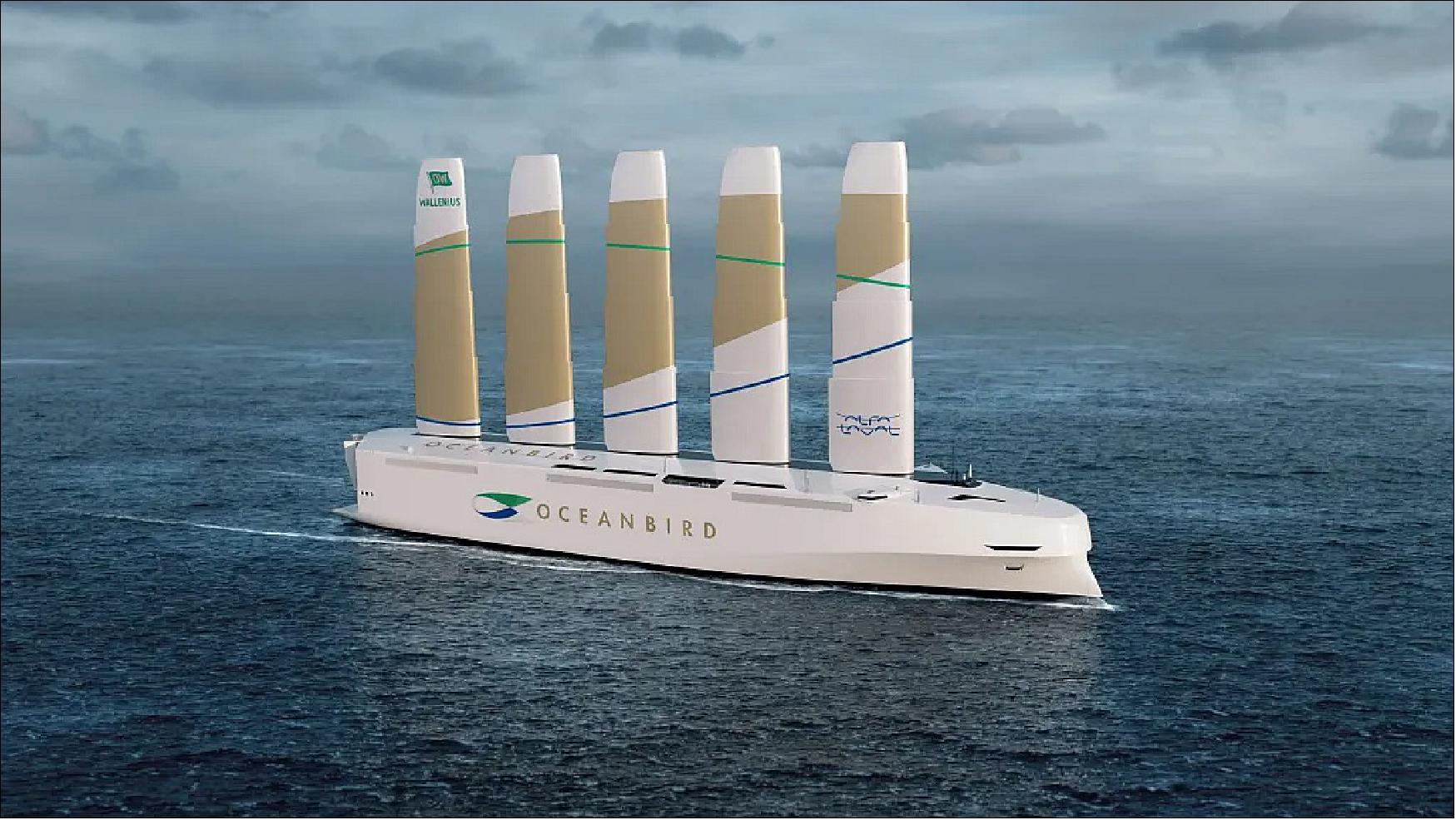
• November 25, 2021: METIS Cyberspace Technology has signed an agreement with data and analytics firm Spire Global. The agreement will see Spire’s weather-forecasting data and services added to METIS’ cloud-based platform to enhance weather-related functionality. 124)
- Through both terrestrial and satellite data, Spire provides insight into weather patterns at each layer of the Earth’s atmosphere and across its surface – even in remote parts of the ocean where the elements are difficult to predict.
- METIS will receive a 10-day forecast covering the entire global grid, with an update frequency of one to six hours. The data package will include atmospheric data such as temperature and wind speed; maritime data, meaning sea currents and basic wave heights; and wave-specific data comprising detailed insights on waves and swell.
- Based on this information, the Athens-based company will improve its weather-routing and speed-profiling capabilities as well as its ability to provide proactive weather alerts.
- Customers will benefit from safer and more efficient navigation – and, by optimising speed, can be assured of timely arrival in port while reducing fuel-oil consumption and emissions.
- Spire is the fourth weather provider to contribute to the METIS cloud-based platform.
- “A crucial part of our strategy is to establish an open platform on which our solutions interconnect with those of third-party providers to offer added value to customers,” said Andreas Symeonidis, marketing manager, METIS Cyberspace Technology. “As the latest example of this approach, our collaboration with Spire gives us full global coverage of weather conditions with no blind spots, allowing us to account for all eventualities and deliver our most precise weather-based services yet.”
- “The interaction between our platform and Spire’s is extremely fast and efficient, which means we can reduce the time it takes to complete each request and perform complex analyses involving multiple routes,” added Symeonidis. “This flexibility will enable us to finetune our existing services and – even more importantly – develop new and highly specialised ones.”
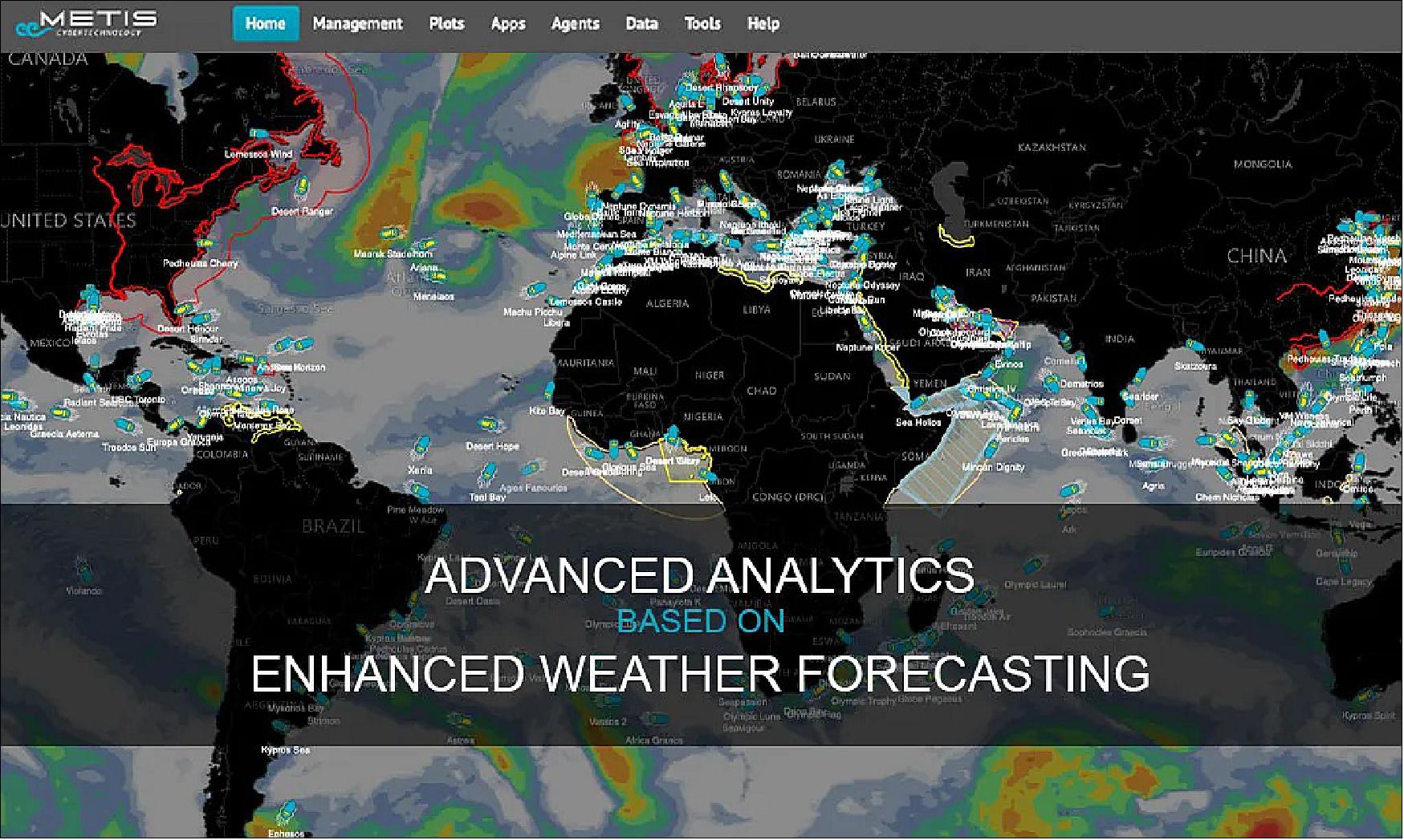
• November 25, 2021: Marseilles-based start-up Searoutes has announced a EUR 1.3 million financing round to help shipping companies reduce their greenhouse gas (GHG) emissions. 125)
- The round was led by WSB Beteiligungs, the venture capital firm founded by Wolf Scheder. In August this year, the start-up was awarded a grant of EUR 1.1m from the European Maritime and Fisheries Fund (EMFF), financed by the European Commission, bringing Searoutes’ total funding to EUR 2.4m.
- Created in 2019 by Dr. Pierre Garreau and Carsten Bullemer, Searoutes has designed its own, proprietary eco-calculator to compute the carbon footprint of a container along its journey. The start-up has been accelerated by ZEBOX, the international incubator and accelerator founded by the CMA CGM Group.
- Searoutes’ API and software-as-a-service (SaaS) platform uses its own data and proprietary algorithms to help shippers find ways to reduce their emissions. Searoutes’ technology can process and transform extensive datasets of freight information (historical ship positions, satellite data, engine specifications, schedule information, weather data, etc.) into meaningful information.
- The start-up helps shippers to not only report their carbon footprint but also identify opportunities to reduce and better manage their GHG emissions.
- According to Searoutes, a ship operator can reduce its GHG emissions by 30 percent when making purchasing decisions by choosing newer, larger and slower fleets, and by up to 60 percent by choosing the right combination of ports and mode of transport when planning a door-to-door route.
- Searoutes’ deal will fund the acceleration of the deployment of the solution to shippers and freight forwarders as well as other related technology platforms. Searoutes is also continuing to invest in research, in partnership with artificial intelligence (AI) laboratories, to optimise the door-to-door loading-unloading cycle.
- “Shippers have to deal with purchasing and managing logistics throughout the entire supply chain, not just the ocean piece. We need to help them shape better procurement strategies. For instance by choosing greener modes of transport, or more appropriate port of loading or discharge. Searoutes’ vision is to give more visibility to green carriers, and enable shippers to select them more proactively, » explained Dr. Pierre Garreau, founder and managing director of Searoutes.
- Wolf Scheder-Bieschin, leading the seed investment round through WSB Beteiligungs, added: “Searoutes is rapidly winning over international transport professionals with its innovative approach.
- “Searoutes services bridge the gap between current market solutions and a need to tackle climate change issues facing the supply chain and maritime industries. I’m impressed by the technology and R&D in place at Searoutes for developing powerful complex algorithms to analyse and process data. This offers a significant advantage for everyone involved in the industry.”
- OHB venture Capital , the venture capital arm of the OHB Group, Team ABC venture, CMA CGM, and a group of business angels, including Thomas Sørbø (Xeneta co-founder), with key expertise in logistics and freight transport are also participating in the financing round.
• November 24, 2021: Kongsberg Maritime (KM) has signed a memorandum of understanding (MoU) with Norsepower to add wind propulsion to KM’s integrated power and propulsion systems. 126)
- Under the MoU, shipowners and shipyards will be able to choose between fully integrated systems, or solutions incorporating stand-alone products. By teaming up with Norsepower, KM adds wind propulsion to its portfolio of strategies to facilitate greener operations, aided by its innovative controllable pitch propeller (CPP) solutions, which can easily manage the variable power delivered by Rotor Sail systems.
- The Norsepower Rotor Sail solution is the first third-party verified and commercially operational auxiliary wind propulsion technology for the global maritime industry. The solution is fully automated and detects whenever the wind is strong enough to deliver fuel and emission savings, at which point the Rotor Sails start automatically. Norsepower has completed six installations to date, including the latest installation of five tilting Rotor Sails on a bulker.
- “This co-operation with Norsepower is an additional step towards KM’s ambition to become the leading integrator of green shipping technology, such as auxiliary wind power, alternative fuels/energy sources and energy-saving devices,” said Oskar Levander, SVP business concepts, Kongsberg Maritime. “There is an increasing demand for the use of modern wind propulsion in shipping, and we are excited to work with Norsepower to deliver this. Together we will offer support to shipowners and shipyards looking for the most efficient and effective ways of applying Rotor Sail technology, and collaborate on new ship designs to integrate these technologies and improve energy efficiency overall.”
- “The shipping industry is under intensifying pressure to decarbonise,” said Tuomas Riski, CEO, Norsepower. “As the industry combines clean technology solutions to accelerate progress towards reaching net zero, it is important that the optimal design points are considered on installation for all systems. This partnership will help fast-track optimising operations for shipowners and yards developing complete solutions.
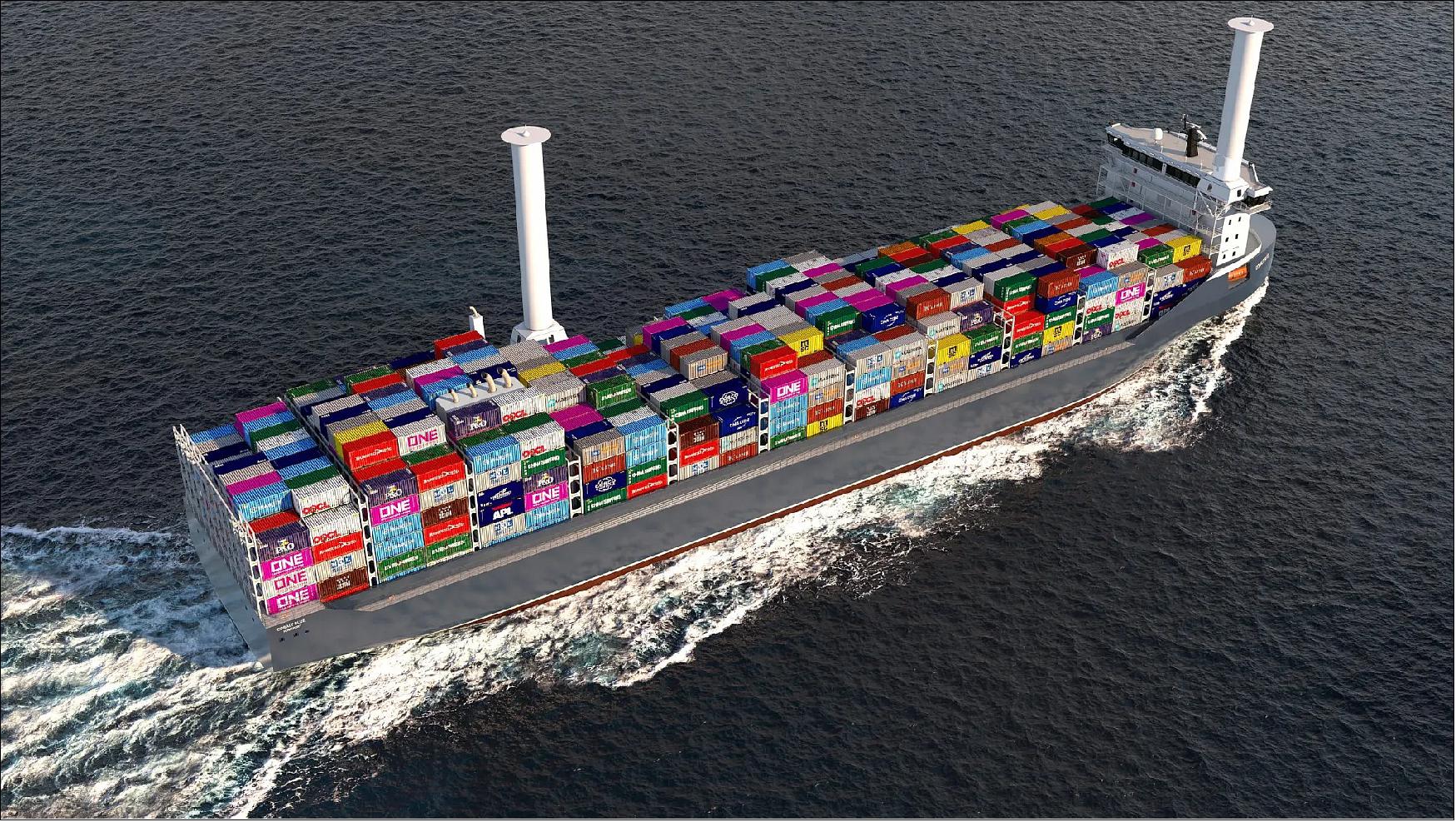
• November 24, 2021: Swiss engine designer WinGD has announced that its engines will be able to run on methanol and ammonia from 2024 and 2025, respectively. 127)
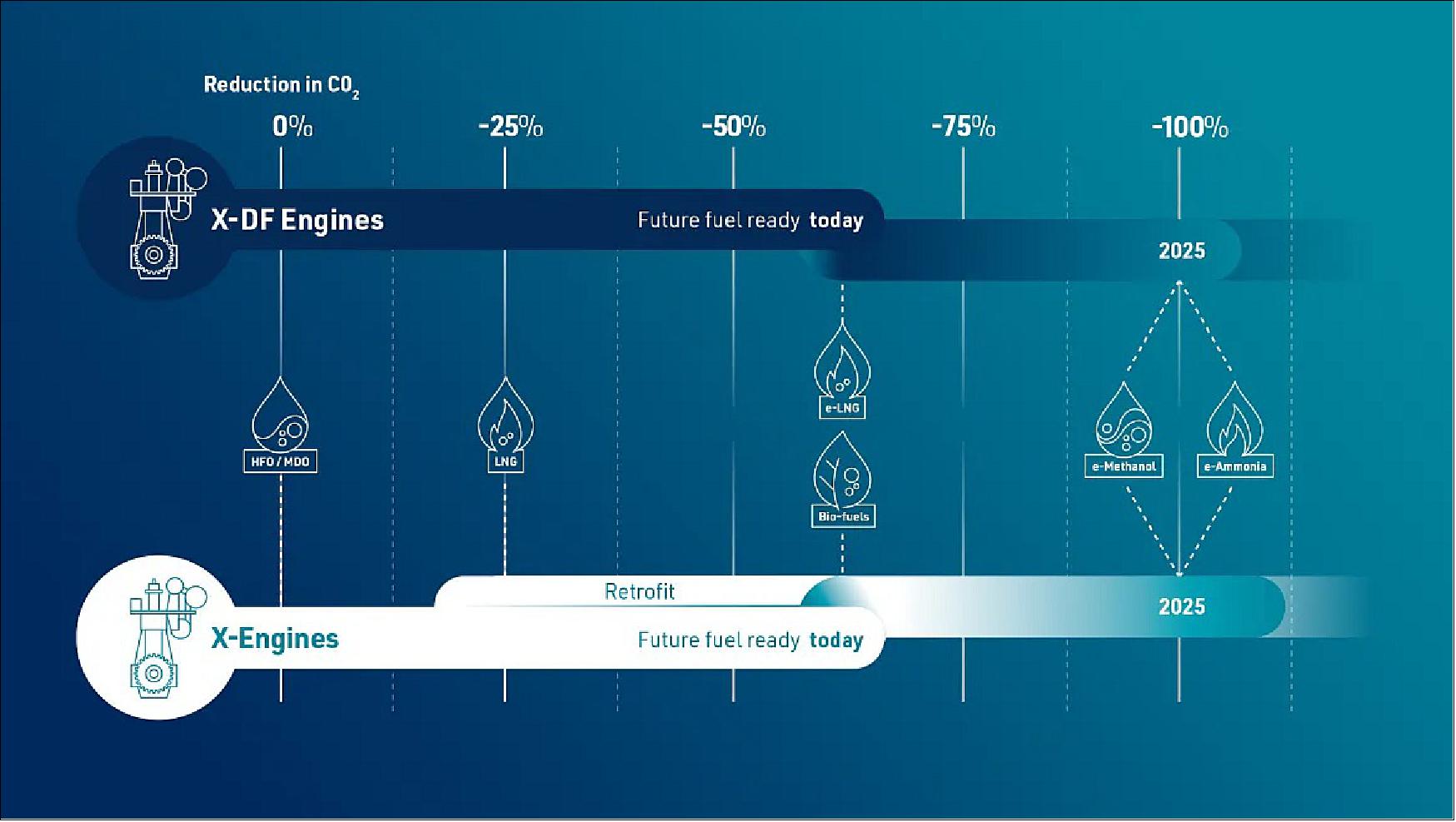
- Both X and X-DF engine series are already compatible with low-carbon fuels – liquid biofuel or biogas respectively – which can provide significant reductions in greenhouse gas emissions. As one example, the tanker operator Terntank bunkered and operated its X-DF engines on liquefied biogas as long ago as 2018. The full, long-term use of carbon-neutral or zero-carbon fuels is the next step on this pathway.
- Emissions from WinGD engines can already be optimised in line with IMO’s incoming Carbon Intensity Index (CII) and Energy Efficient Design Index for Existing Ships (EEXI). Hybridisation of the power arrangement is one option. WinGD offers system integration services that maximise fuel efficiency by selecting and sizing hybrid components and the electrical system in parallel with the main engine.
- The timeframe for ammonia and methanol capability is part of a wider ambition to grow sales of multi-fueled engines capable of operating on carbon-neutral fuels to 50 percent of the company’s orderbook by 2030. This is in line with the industry predictions of when these fuels will be available at scale and a viable fuel choice for deep-sea vessels.
- Dominik Schneiter, vice president research & development, WinGD said: “Our commitment to deliver engine technologies to enable the use of clean fuels by 2025 means that shipowners and operators can already invest in ships that are ready to use ammonia and methanol today, safe in the knowledge that WinGD will have the technologies available to power their vessels reliably, efficiently and cleanly.”
- “By 2030, many of the ships that will be sailing in 2050 – the date of IMO’s greenhouse gas emission reduction target – will already have been ordered,” stated Volkmar Galke, director of global sales, WinGD “Our clean fuel engine technologies will be available well before then and will be based largely on our current technologies, allowing us to support shipowners and operators in their decarbonisation choices whenever they make them.”
• November 22, 2021: NAPA has shared the preliminary results of its new research that explores the potential effect of The Energy Efficiency Index for Existing Ships (EEXI) on the transportation capacity, total emissions and carbon intensity of the global bulker fleet. 128)
- Adopted by MARPOL in June 2021, EEXI measures and restricts CO2 emissions per transport work, purely considering the ship’s design parameters. One of the most common means of complying with EEXI is likely to be through limiting engine power.
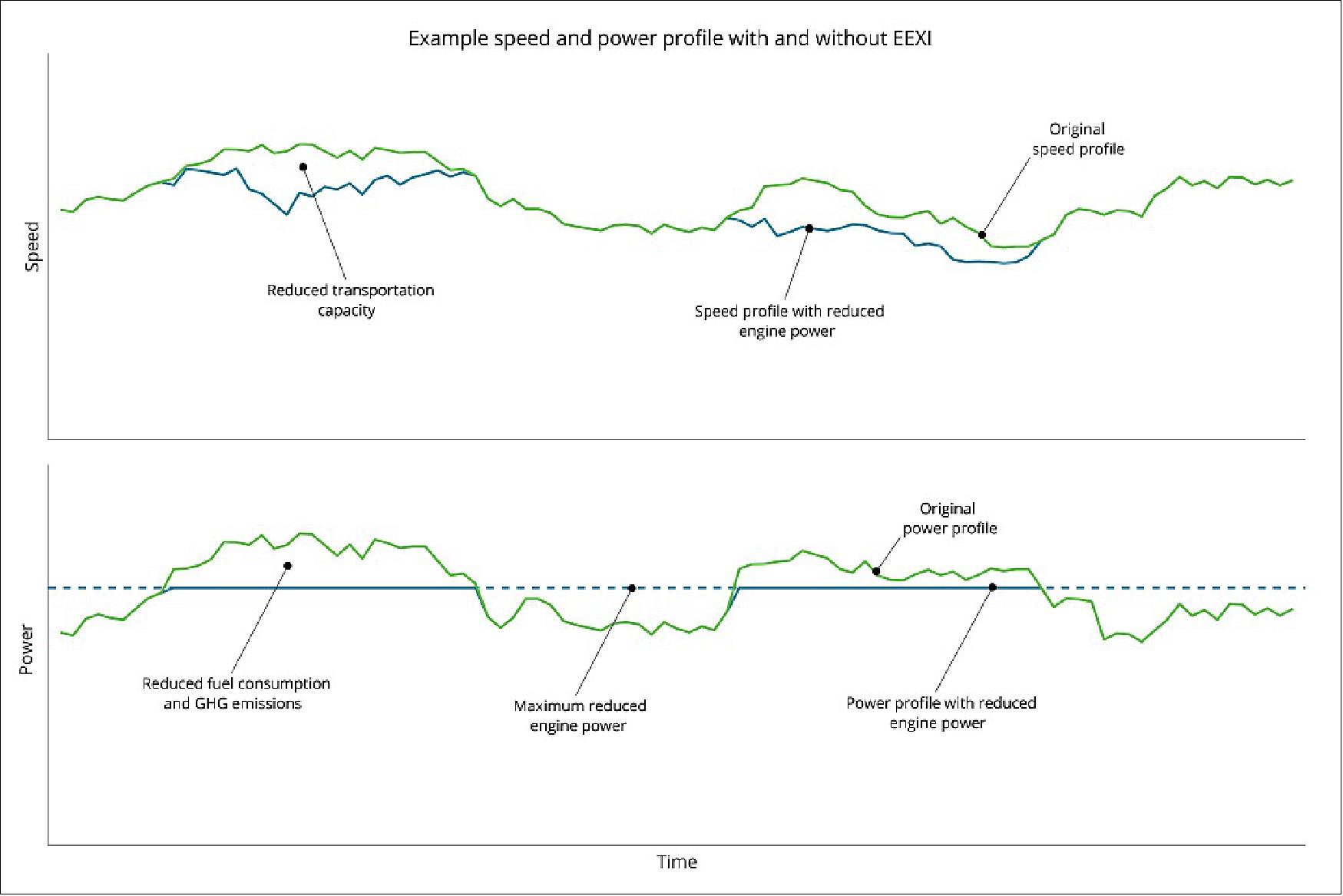
- The study maps EEXI requirements and engine power limitation onto real-life operations, including detailed weather data and records of real routes and speed profiles cross-referenced with the NAPA ship model database, which includes vessel-specific performance models for the global fleet.
- The retro-optimisation study used real voyage data from 1500 bulkers over 12 months in 2019. NAPA used its Fleet Intelligence platform to study the true operational profiles of vessels in actual weather conditions, whilst analysing how much the maximum engine power limitation would have impacted these operations.
- The data shows that the engine power limitations required by vessels to comply with EEXI would only have come into effect at high-speed peaks. Therefore, for most of the year, if EEXI had been in effect, vessel operations would have remained largely similar.
- In addition, the speed reductions required by EEXI would have reduced the transportation capacity by an average of 2 percent for bulkers. However, the impact on transportation capacity was strongly dependent on the year in which the vessel was built, ranging from under 2 percent for newer vessels and up to 6 percent for vessels built in 2012. This indicates that EEDI, which came into force more recently, helped align vessels towards the current standard.
- In the study, NAPA also found that the implementation of EEXI would reduce CO2 emissions by an estimated 6.6 percent and carbon intensity by 4.6 percent on bulk carriers.
- Teemu Manderbacka, lead R&D engineer at NAPA, said: “While this is a good start, it shows the gap between what EEXI can achieve and how much more ground there is to make up. It shows why, at MEPC 77, to truly match the level of ambition that has come out of COP26, the IMO member states will need to prioritise efficiency.”
- He continued: “We wanted to analyse the effect of EEXI on real-life operations, so we tried to answer the question, ‘what would have happened if EEXI was implemented in 2019?’. We discovered that it would be similar to limiting the top speeds of cars in Europe from 160 km/h to 130 km/h. For most users on most roads, it doesn’t really change anything; the only people it affects are those on the autobahn in Germany.
- “It does, however, demonstrate that EEXI can reduce carbon intensity and that the carbon savings outweigh the reductions in lost transport capacity. It’s one step on a much longer journey.”
- Ossi Mettälä, senior customer success manager at NAPA, said: “It was really important that we could simulate this regulation onto real-life operations. With this in mind, we brought together a range of sources: our NAPA Voyage Optimisation API, global weather data, vessel-specific performance models, the NAPA ship model database, and global AIS data to get these answers. This helped give us an accurate picture of just how far we have to go to reach the IMO’s targets – or the more ambitious targets of net-zero by 2050.
- “The tools that we used to analyse the problem can also help us solve it, as they would enable vessels to operate more efficiently and provide all stakeholders with greater insight into misaligned incentives and practices, such as rushing to wait. It underlines how there remains a huge amount of latent inefficiency in shipping that we can resolve simply by using data to shape our operations better.”
• November 19, 2021: Countries must now build on their commitments to save the Paris Agreement’s 1.5 degrees Celsius temperature goal with concrete action and halve shipping emissions by 2030 at the IMO. 129)
- Countries must now build on their commitments to save the Paris Agreement’s 1.5 degrees Celsius temperature goal with concrete action and halve shipping emissions by 2030 at the IMO.
- These are the thoughts of several organisations who released a joint statement this week to encourage countries to commit to ambitious carbon reduction goals. The joint statement was released by the Clean Shipping Coalition, Clean Arctic Alliance, Global Choices, Seas at Risk, Opportunity Green, Pacific Environment, Greenpeace, WWF- Canada, Environmental Defense Fund, ECODES. The statement goes on to say:
- There is currently no strategy in place at the IMO to achieve any significant ship emission reductions before 2030, let alone the reductions necessary to keep the sector on a pathway consistent with warming below 1.5º Celsius. Under the current IMO regulations ship emissions continue to rise out to 2030 and the shipping industry will exhaust its 1.5º carbon budget by 2029.
- At next week’s 77th session of IMO’s Marine Environment Protection Committee (MEPC77), IMO member states must urgently align the agency’s work on reducing climate impacts from shipping with the COP26 developments.
In particular, countries have the opportunity to:
a) Align shipping with the 1.5 degrees target: commit to reducing ship climate impacts on a timeframe consistent with keeping warming below 1.5 degrees Celsius, including reaching zero by 2050 at the latest and halving emissions by 2030;
b) Bolster short-term measures: reopen discussions on the level of ambition in the IMO’s short-term measure with a view to agreeing new targets consistent with halving emissions by 2030;
c) Tackle black carbon: take decisive action to address the impact on the Arctic of black carbon emissions, a short-lived climate forcer responsible for 20 percent of shipping climate impact;
d) Set a GHG levy: agree a minimum USD 100/ton levy on GHG emissions to raise climate finance and support a just transition to zero across the sector as called for at COP26.
- These actions constitute a significant increase in the ambition of IMO’s climate work but they are necessary if we want the shipping industry to contribute to keeping global heating below 1.5 degrees Celsius and save billions of people around the world from climate chaos.
The COP26 summit has already laid an important foundation for this shift, as:
- 54 climate-vulnerable countries signed the Dhaka-Glasgow declaration, demanding a carbon levy on ship fuel;
- 22 countries agreed to set up decarbonised shipping corridors through the Clydebank Declaration;
- 14 countries endorsed the Declaration on Zero Emission Shipping by 2050.
- We applaud the signatories for their climate leadership and urge them to make their presence felt at MEPC77. We insist that they stick to their positions on aligning with the 1.5 degrees Celsius temperature goal, thereby having to halve shipping emissions by 2030, and support a carbon levy inside the IMO as well as outside it.
- We will continue monitoring closely the discussion at the IMO to make sure climate commitments at COP26 translate into concrete action.
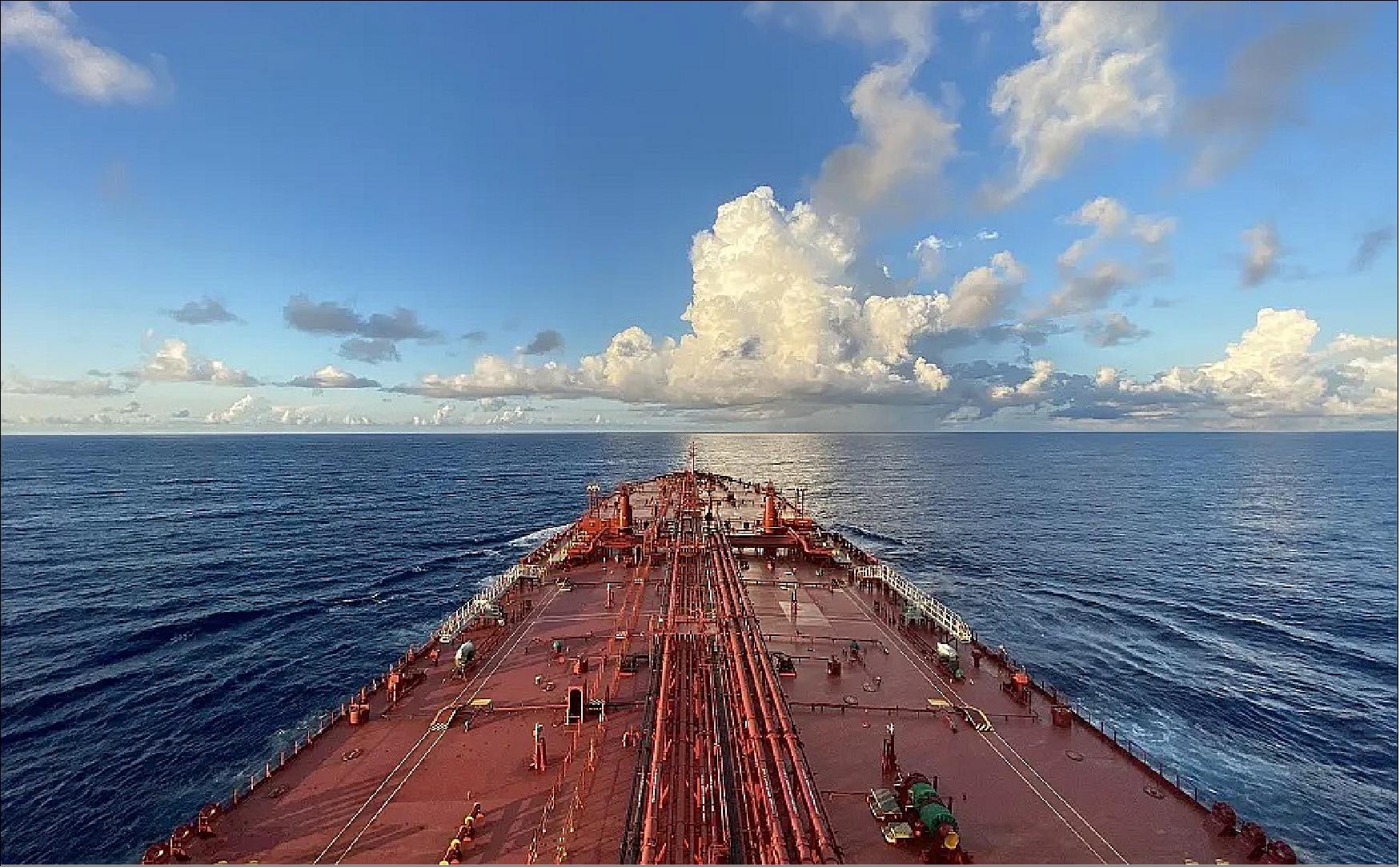
• November 18, 2021: Research from FuelTrust shows how different batches of the same grade of marine fuel (such as VLSFO or HFO) can have radically different degrees of energy intensity. 130)
- Fuel buyers armed with this knowledge could save up to 3 percent BTU (British thermal unit) of extra energy by bunkering with a different batch of fuel, while shipowners could save thousands of dollars in fuel costs.
- This analysis of different fuel batches was carried out using FuelTrust’s artificially intelligent (AI)-powered Digital Chemist, which simulates combustion on a molecular level to identify differences in fuel properties such as fuel quality, energy, and emissions profiles. Digital Chemist combines the known characteristics of a fuel batch, with class data on the vessel engine, and data from the day logs to accurately establish what happens when fuel is burned.
- Based on analysis of 14m barrels of VLSFO fuel across 28 batches, FuelTrust found that different batches of fuels could essentially provide higher energy, without the supplier or buyer realising – for a fully laden Panamax container ship, this would equate to a 50MT saving of fuel on a voyage from Vancouver, Canada to Portsmouth, UK, or the equivalent of up to 469 nautical miles of additional sailing distance on a typical bunker.
- “This isn’t like saying there’s a difference between gas stations – it’s more like there being a huge difference in the fuel you could buy at different pumps,” explained Jonathan Arneault, CEO of FuelTrust.
- This energy intensity delta could be operationally challenging as regulations on fuels tighten, and particularly if, as expected, zero carbon fuels such as methanol become widely used. Because zero-carbon fuels are less energy-dense than currently used fuels, vessels will need to carry more fuel to continue to operate in the same way.
- “Energy intensity matters. We’re about to see fuels come through with much a lower energy density than we’re used to,” continued Arneault.
- Dr. Ram Vis, founder and director at the Viswa Group and advisor to FuelTrust, emphasised how energy density will become a major concern for fuel purchasers;
- “If, as expected, you need twice the amount of methanol to do the same work as a tonne of HFO, buyers are going to have to pay a lot more attention to the BTUs that they are buying, as they’ll have to squeeze every drop of energy out of their fuel. If we see the same batch-to-batch variation in zero carbon fuels as we do today with conventional fuels, that will be a real issue. Fuel buyers will need to start thinking more in terms of energy, and less in terms of volume”.
- FuelTrust’s research indicates that differences in energy intensity will be matched by differences in emissions. With the proposed introduction of carbon taxes and emissions trading schemes, this could add up to thousands of dollars in taxes saved or lost, purely based on which batch of a fuel ends up in a vessel.
• November 16, 2021: Ship manager V.Group has launched a dedicated ‘Sustainability & Decarbonisation’ department and entered a strategic partnership with Mærsk Mc-Kinney Møller Centre for Zero Carbon Shipping (the Centre). 131)
- Launched in 2020 as an independent, not-for-profit organisation, the Centre is undertaking intensive research and development to find practical ways to decarbonise the maritime industry through several global initiatives.
- As a partner, V.Group intends to support its customers in the use of transition fuels, including green ammonia and hydrogen, in anticipation of a stricter regulatory climate.
- The ship manager will make several of its marine specialists available to the Centre in Copenhagen to provide insights about the operational practicality of proposed initiatives in a live setting.
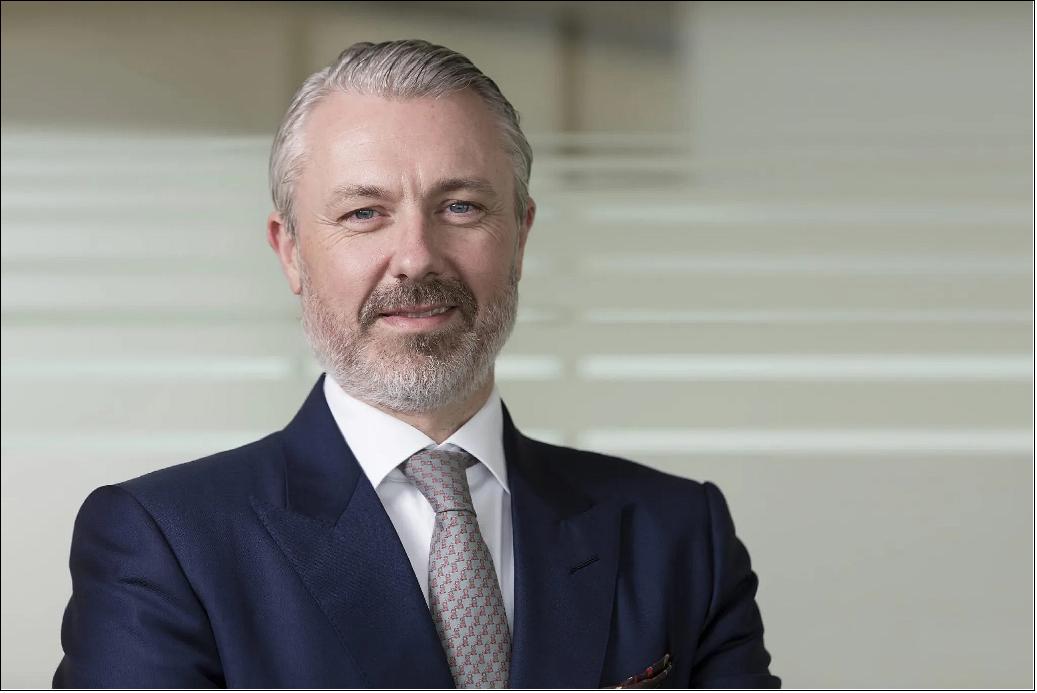
- René Kofod-Olsen, CEO at V.Group said :“We firmly believe that by pooling our resources, the maritime sector could play an exemplary role in bringing about fundamental change to protecting our planet. By establishing a dedicated function and joining forces with the Mærsk Mc-Kinney Møller Centre for Zero Carbon Shipping, we are demonstrating our commitment to driving this change in a very real and practical way.
- “By supporting the use of pioneering new fuels, new technologies and digital practices, V.Group aims to remove barriers, close gaps and find solutions, and will thereby assist our customers and the industry towards lower carbon emissions.
- “As well as informing our own practices, we believe that the dedicated approach and our involvement with the Centre will be of significant benefit to our customers and the wider industry.
- “We are committed to ensuring that operating procedures, safety management and crew training are kept in step with innovation. Crew, for instance, will have to know how to handle, store and manage new fuels and operate technically advanced propulsion and power generation equipment.
- “In the coming years, the entire seafaring community will need to be trained or retrained to adapt to this new low carbon world. Our customers can rest assured that we are prepared for these major changes.
- “Environmental credentials will soon become as important a consideration for vessel owners as health and safety, so it is imperative ship managers take the initiative.”
- Bo Cerup-Simonsen, CEO of Mærsk Mc-Kinney Møller Centre for Zero Carbon Shipping said: “We are delighted to be joining forces with V.Group. Decarbonising the maritime industry by 2050 calls for action now and together we will support the first movers that lead the way and demonstrate real climate action.
- “This transformation is about much more than maturing new fuel pathways and developing new technologies. It is a systemic change to an entire business system and the implementation of the new solutions will impose significant challenges across all parts of the value chain. V.Group brings decades of operational experience, expertise and insights that will help inform best practices around safety, training and new operational standards.
- “Connecting the human element and best practices of safety management to the hard engineering will be critical for a successful industrial transition. V.Group will contribute with significant knowledge and expertise in this field.
- ”V.Group’s partnership underlines the wider realisation that change is inevitable. The shipping industry currently accounts for three percent of global CO2 emissions and has made numerous commitments to reduce these by 2050,” concluded Cerup-Simonsen.
• November 10, 2021: Key nations have agreed during COP26 (26 th session of the Conference of the Parties) of the UNFCCC to work together on establishing ‘Green Corridors’. These corridors will be shared maritime trade routes on which to scale up zero-emission shipping. 132)
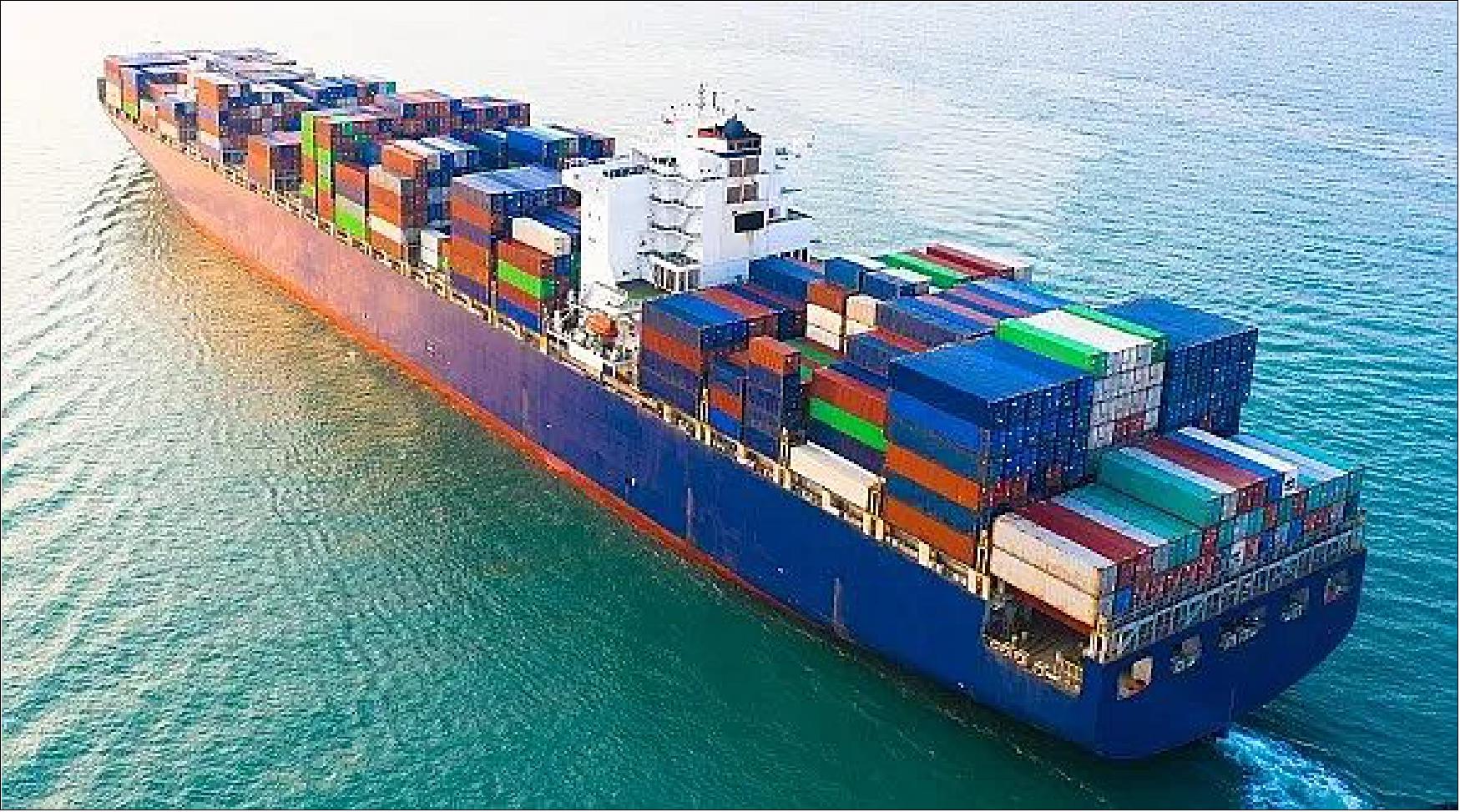
- The corridors cover both the necessary port infrastructure as well as vessels powered by zero-emission fuels. The goal is to establish six green corridors by 2025, with the longer term goal to scale activity to support both an increased number and longer routes by 2030.
- The commitment to establishing these corridors has been signed under the Clydebank Declaration.
As part of the declaration, the signatories pledge to:
a) Facilitate the establishment of partnerships, with participation from ports, operators and others along the value chain, to accelerate the decarbonization of the shipping sector and its fuel supply through green shipping corridor project.
b) Identify and explore actions to address barriers to the formation of green corridors. This could cover, for example, regulatory frameworks, incentives, information sharing or infrastructure.
c) Consider the inclusion of provisions for green corridors in the development or review of National Action Plans.
d) Work to ensure that wider consideration is taken for environmental impacts and sustainability when pursuing green shipping corridors.
- Ingrid Irigoyen, associate director for Ocean and Climate at The Aspen Institute, said: “Establishing zero-carbon shipping corridors is a clear and necessary next step in this transition. We’ll need to align stakeholders across the shipping and fuels value chains in specific geographies, and having this group of governments ready and eager to support those efforts is extremely helpful. As expressed in the coZEV 2040 Ambition Statement, cargo owners are interested in supporting concrete zero-carbon corridor projects.”
- Signatories include: Australia, Belgium, Canada, Chile, Costa Rica, Denmark, Fiji, Finland, France, Germany, Republic of Ireland, Italy, Japan, Republic of the Marshall Islands, Morocco, Netherlands, New Zealand, Norway, Sweden, The United Kingdom of Great Britain and Northern Ireland, The United States of America.
- The naming of the Clydebank Declaration pays tribute to the heritage of the City of Glasgow and the River Clyde where the Declaration was signed on 10 November 2021.
- The Declaration sits within the Zero-Emission Shipping Mission and is designed to complement work at the International Maritime Organization to enable zero-emission shipping.
We, the Clydebank Declaration signatories:
Recall the long-term temperature goal of the Paris Agreement to hold the increase in the global average temperature to well below 2°C above pre-industrial levels and pursue efforts to limit the temperature increase to 1.5°C above pre-industrial levels.
Note the International Maritime Organization (IMO)’s adoption of the Initial IMO Strategy on Reduction of Greenhouse Gas Emissions from Ships, Resolution MEPC.304(72), which aims to align international shipping with the aforementioned temperature target.
Emphasize the importance of pursing efforts to limit the increase in the global average temperature to 1.5°C above pre-industrial levels, to have a greater chance of significantly reducing the risks and impacts of climate change on countries, in particular least developed countries and small island developing states.
Recognize the benefits of pursuing synergies between decarbonization and clean air policies in shipping, and building on existing measures related to the reduction of pollution from ships under the International Convention for the Prevention of Pollution from Ships (MARPOL).
Express great concern regarding the findings from the Fourth IMO Greenhouse Gas Study 2020, which estimates that if no further action is taken, international shipping emissions are expected to represent 90% to 130% of 2008 emission levels by 2050.
Express great concern also regarding the findings of the IPCC Working Group I contribution to the Sixth Assessment Report (2021), which states that global warming of 1.5°C and 2°C will be exceeded during the 21st century unless deep reductions in carbon dioxide (CO2) and other greenhouse gas (GHG) emissions occur in the coming decades, and hence, endorse the need for international shipping to keep accelerating its level of action.
Equally recognize that a rapid transition in the coming decade to clean maritime fuels, zero-emission vessels, alternative propulsion systems, and the global availability of landside infrastructure to support these, is imperative for the transition to clean shipping.
The signatories of this Declaration assert the need for the formation of an international coalition between ambitious governments, to act together and demonstrate that maritime decarbonization is possible, while unlocking new business opportunities and socioeconomic benefits for communities across the globe.
Mission Statement
The signatories of the Declaration are to support the establishment of green shipping corridors – zero-emission maritime routes between 2 (or more) ports.
It is our collective aim to support the establishment of at least 6 green corridors by the middle of this decade, while aiming to scale activity up in the following years, by inter alia supporting the establishment of more routes, longer routes and/or having more ships on the same routes. It is our aspiration to see many more corridors in operation by 2030. We will assess these goals by the middle of this decade, with a view to increasing the number of green corridors.
In the pursuit of these goals, with reference to the approach(es) set out in Annex A, signatories pledge to:
- facilitate the establishment of partnerships, with participation from ports, operators and others along the value chain, to accelerate the decarbonization of the shipping sector and its fuel supply through green shipping corridor projects
- identify and explore actions to address barriers to the formation of green corridors. This could cover, for example, regulatory frameworks, incentives, information sharing or infrastructure
- consider the inclusion of provisions for green corridors in the development or review of National Action Plans
- work to ensure that wider consideration is taken for environmental impacts and sustainability when pursuing green shipping corridors.
• November 9, 2021: Marine fuel testing company VPS and marine fuel tracing company BunkerTrace have announced a new strategic partnership to see VPS bring to market BunkerTrace’s forensic technology – starting with the launch of its Sample Assurance product. 133)
- The agreement represents a significant step for the improvement in traceability and transparency across the global marine fuel sector. As such, VPS will now provide a variety of new services to its customers – powered by BunkerTrace’s blockchain and synthetic DNA technology.
- As these new services are rolled out, they will allow for greater efficiency across the bunkering supply chain, peace of mind in ensuring customer compliance, drastically reduce the risk of delays and disputes, support ESG objectives, and protect customers’ reputation.
- BunkerTrace’s Sample Assurance product is a tamper-proof embedded seal which is added to the sample cubitainer during a VPS Bunker Quantity Survey. Using the BunkerTrace mobile app, VPS (Vessel Performance Solutions) surveyors digitally record the event to prove sample provenance and integrity. In the event of a dispute, the seals carry a unique code, only detectable with a BunkerTrace detection unit in a VPS lab where the sample will be checked for integrity.
- Physically tagging and digitally tracing the collected samples prevents contamination and tampering, assuring the quality of the samples as evidence. This enables a clear chain of custody and conclusive evidence to authenticate representative fuel samples.
- Steve Bee, group commercial & business development director at VPS said: “The shipping industry, like every other sector, is in the midst of a digital transformation. On top of that, there are also increasing demands for improved governance and greater transparency. In partnering with BunkerTrace, VPS is able to meet both those demands head on; leading the transition on the global marine fuel market into an age of more assurance, trust and transparency.”
- Deanna MacDonald, co-founder & CEO of BunkerTrace said: “BunkerTrace’s technology is genuinely ground-breaking in terms of its ability to physically tag and digitally trace marine fuel samples – underpinned by innovative blockchain and synthetic DNA technologies. What we needed was a partner that understands the growing need and demand for digital tracing and tracking services, but also has global reach, and shared ideals. In VPS we have found that, and we’re excited to see where we can take this partnership.”

• November 9, 2021: Marine robotics company Ocean Infinity and its partners are to build a marine propulsion test facility with an integrated Ammonia Marine Propulsion System (AMPS). 134)
- The test facility will demonstrate clean-fuelled technology eventually capable of powering Ocean Infinity’s Armada fleet, using an innovative ammonia-based fuel cell system.
- Ocean Infinity recently won The Clean Maritime Demonstration Competition, which is funded by the Department for Transport, with Innovate UK acting as delivery partner. With Ocean Infinity acting as lead partner, the company is combining forces with UK experts in clean fuel cell technology; maritime logistics; deployment and operation of remote and autonomous technology; and the development of operational regulations. The project team consists of Oxford Green Innotech, the University of Oxford and the University of Southampton’s Marine and Maritime Institute.
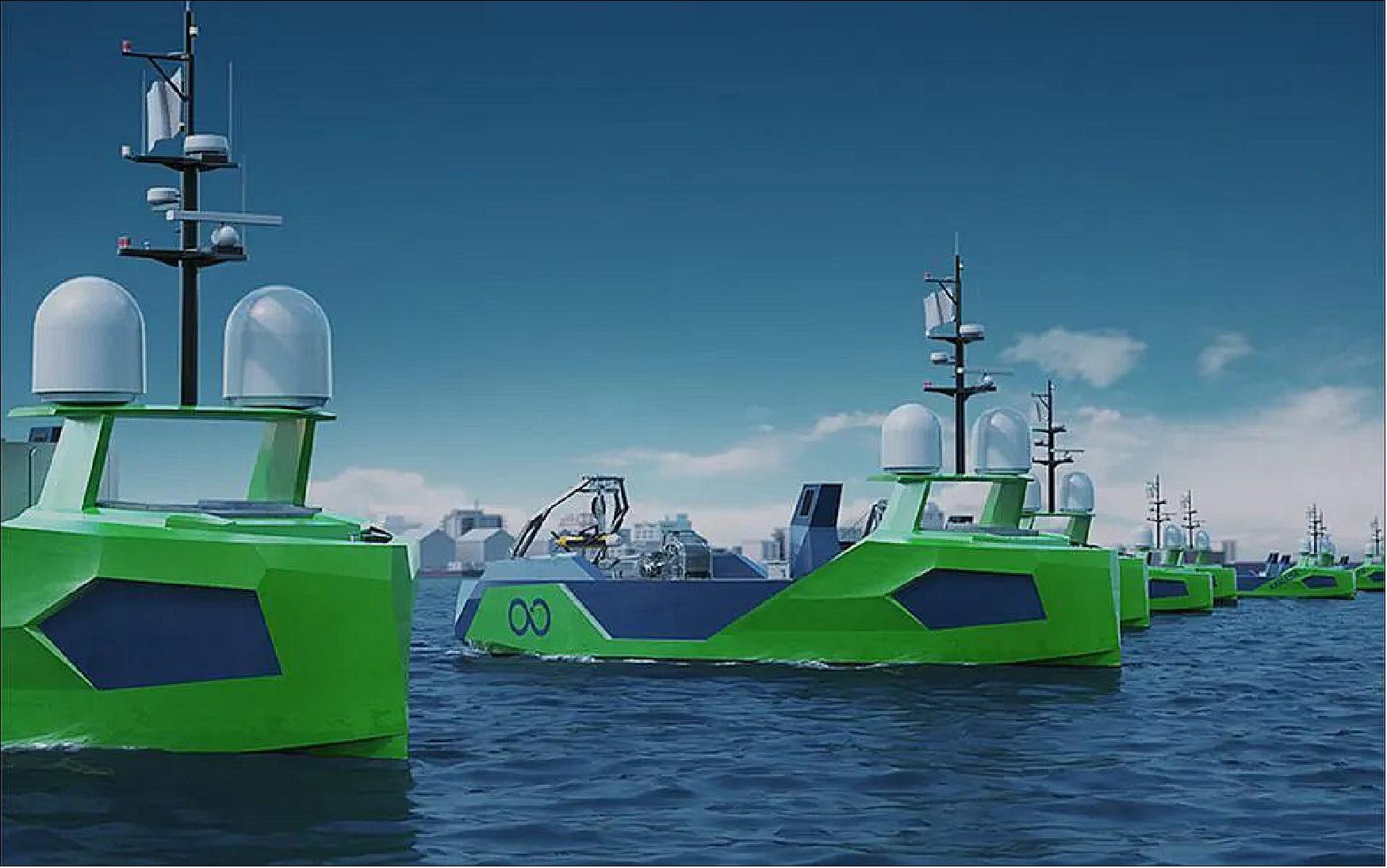
- Currently, most vessels use Green House Gas intensive internal combustion power systems. Directly targeting key elements of the UK Government’s 2050 Clean Maritime Plan, Ocean Infinity and its partners are introducing innovative new technologies and techniques for clean vessel propulsion, expecting to make a meaningful contributing towards the UK’s net-zero greenhouse gas commitment.
- This project, due to deliver a zero-emissions marine propulsion system, is crucial for developing a robust understanding and thus optimisation of an AMPS, suitable for integration into Ocean Infinity’s Armada fleet and beyond.
- Dan Hook, Ocean Infinity’s Chief Technology Officer, said: “Winning The Clean Maritime Demonstration Competition is a significant step forward in the delivery of a zero emissions marine propulsion system. Working with the UK’s leading experts, we are driving forward a ground-breaking ammonia-based fuel cell system, which will not only make the Armada fleet the cleanest in the world, but also has the potential to revolutionize marine propulsion systems.
- I would like to extend our thanks to the Department for Transport, and Innovate UK, for instigating the competition and for their financial support of this important program.”
• November 5, 2021: Proman Stena Bulk has launched Stena Pro Patria, the first of three 49,900 dwt (deadweight tonnage) methanol dual-fuel MR tankers that Proman and Stena Bulk are building together as part of their joint venture. 135)
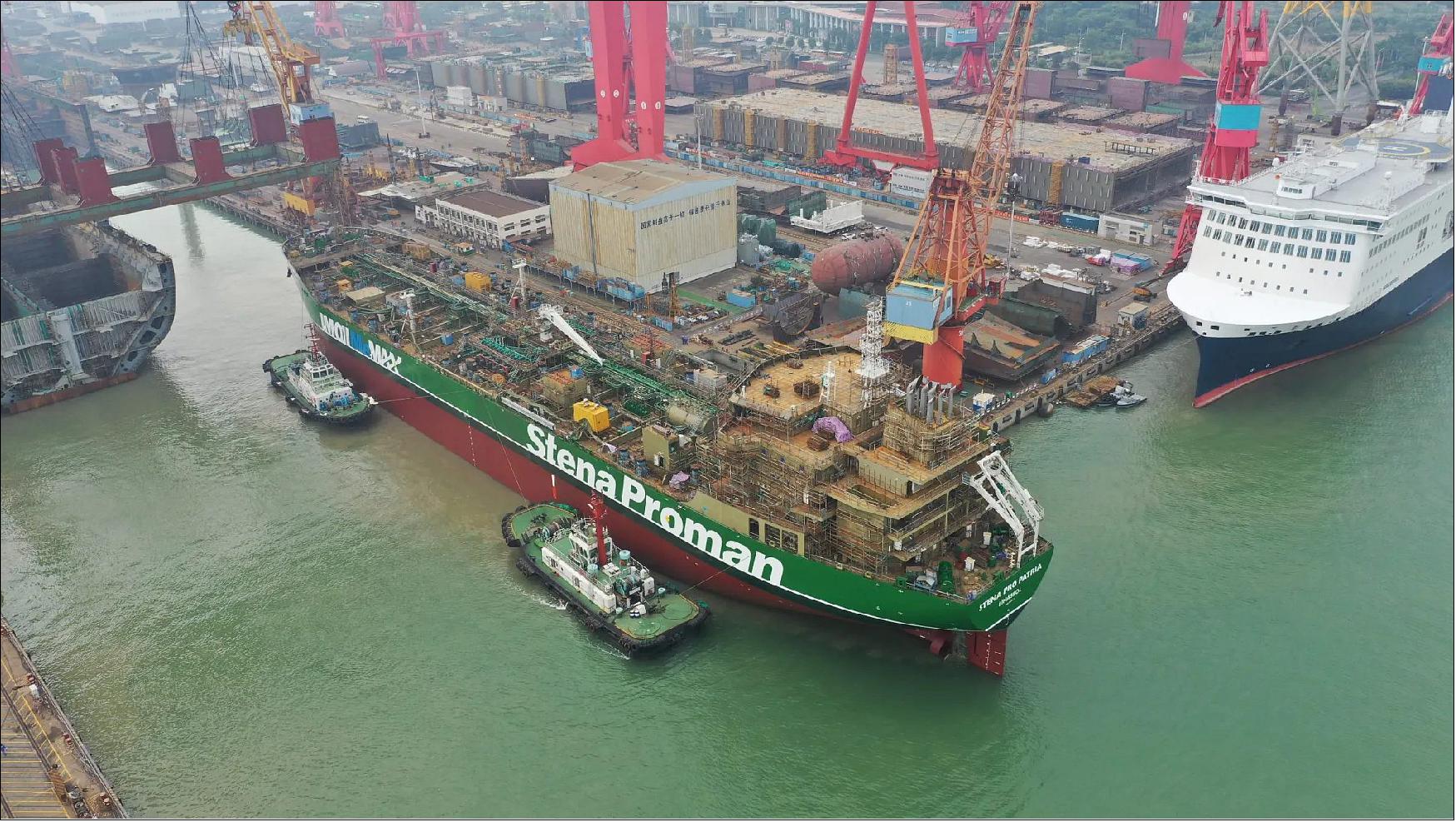
- Stena Pro Patria will use approximately 12,500 tons per annum of methanol as a marine fuel. Using widely available and cost-competitive ‘grey’ methanol produced from natural gas, greenhouse gas (GHG) emissions resulting from the vessel’s normal commercial operations will be significantly reduced compared to conventional marine fuels. This includes the virtual elimination of sulphur dioxide and particulate matter, a 60 percent reduction in nitrogen oxide and a cut in carbon dioxide, offering immediate improvements to air quality around ports and coastlines.
- Stena Pro Patria was launched at Guangzhou Shipyard International (GSI), which is the first Chinese shipyard to build a methanol dual-fuel vessel.
- Construction of the Stena Pro Patria will now continue on the water, ahead of sea trials and final delivery to Proman Stena Bulk in Q1 2022.
- Over the next two years, it will be joined by another five methanol-powered newbuilds: Stena Pro Mare and Stena Prosperous, which will be Proman Stena Bulk JV vessels, and Proman-owned Provident, Progressive and Promise. All vessels will be constructed at Guangzhou Shipyard International and delivered by the end of 2023.
- All Proman and Proman Stena JV vessels will utilise the same vessel design and MAN B&W 6G50ME-C9.6 MW Tier III engines. The vessels will also be equipped with the latest energy efficiency technologies, including continually controlled combustion, optimised tuning, redesigned and aerodynamic hull lines, and an energy shaft generator, reducing fuel consumption and helping to meet strict emissions criteria.
• November 5, 2021: Kawasaki Kisen Kaisha (K Line) has announced it is raising its greenhouse gas (GHG) emissions reduction target to net-zero by 2050. 136)
- In it's revised targets, K Line states that it aims to improve CO2 emission efficiency by 50 percent by 2030 compared to 2008, exceeding the 40 percent target set by the International Maritime Organization (IMO).
- To meet this target, K Line has already introduced LNG (Liquefied Natural Gas)-fuelled carriers, and is working to introduce various energy-efficiency technologies, such as wind power propulsion.
- In the second half of the 2020s, K Line aims to introduce zero-emission vessels powered by new fuels, such as ammonia and hydrogen, and carbon-neutral fuels, such as bio-LNG and synthetic fuel. The company will actively support projects aimed at a decarbonised society, including support vessels for projects related to the renewable energy field, Mr Yukikazu Myochin, president and CEO of K Line confirmed in the company’s recent statement.
- In 2023, K Line plans to deliver a very large gas carrier (VLGC), mainly fuelled by liquefied petroleum gas (LPG) and capable of carrying LPG or ammonia, with a view to transporting ammonia in the future. This will reportedly generate an approximate 20 percent reduction in CO2 emissions, compared with heavy-oil fuelled vessels.
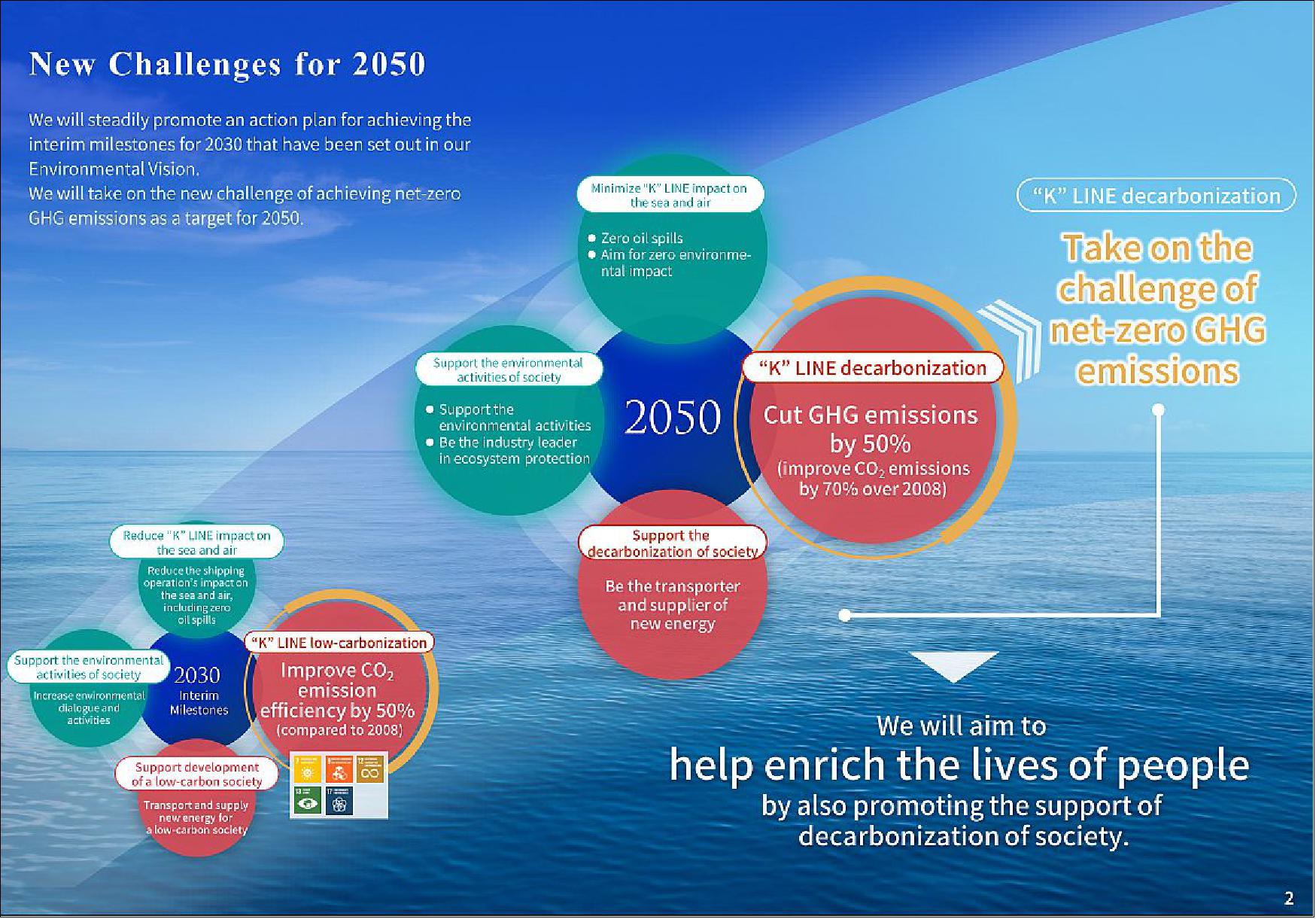
• November 2, 2021: Hyundai Global Service (HGS), the aftercare division of shipbuilder and engine maker Hyundai Heavy Industries, has teamed up with ABB Turbocharging to offer an engine part-load optimisation (EPLO) service for shipowners seeking to cut emissions in line with the International Maritime Organisation’s (IMO) requirements. 137)
- Ahead of the entry into force of the Energy Efficiency Existing Ship Index (EEXI) and Carbon Intensity Index (CII) regulations in 2023, many vessel owners are looking to engine power limitation as a solution. Optimising engines for part-load operation is a reliable and economically feasible solution to minimise environmental impact and improve the operational efficiency of vessels. EPLO can help shipowners find the optimum power range for their engine power limitation, optimise combustion within the reduced load range and reduce fuel consumption, emissions and maintenance costs.
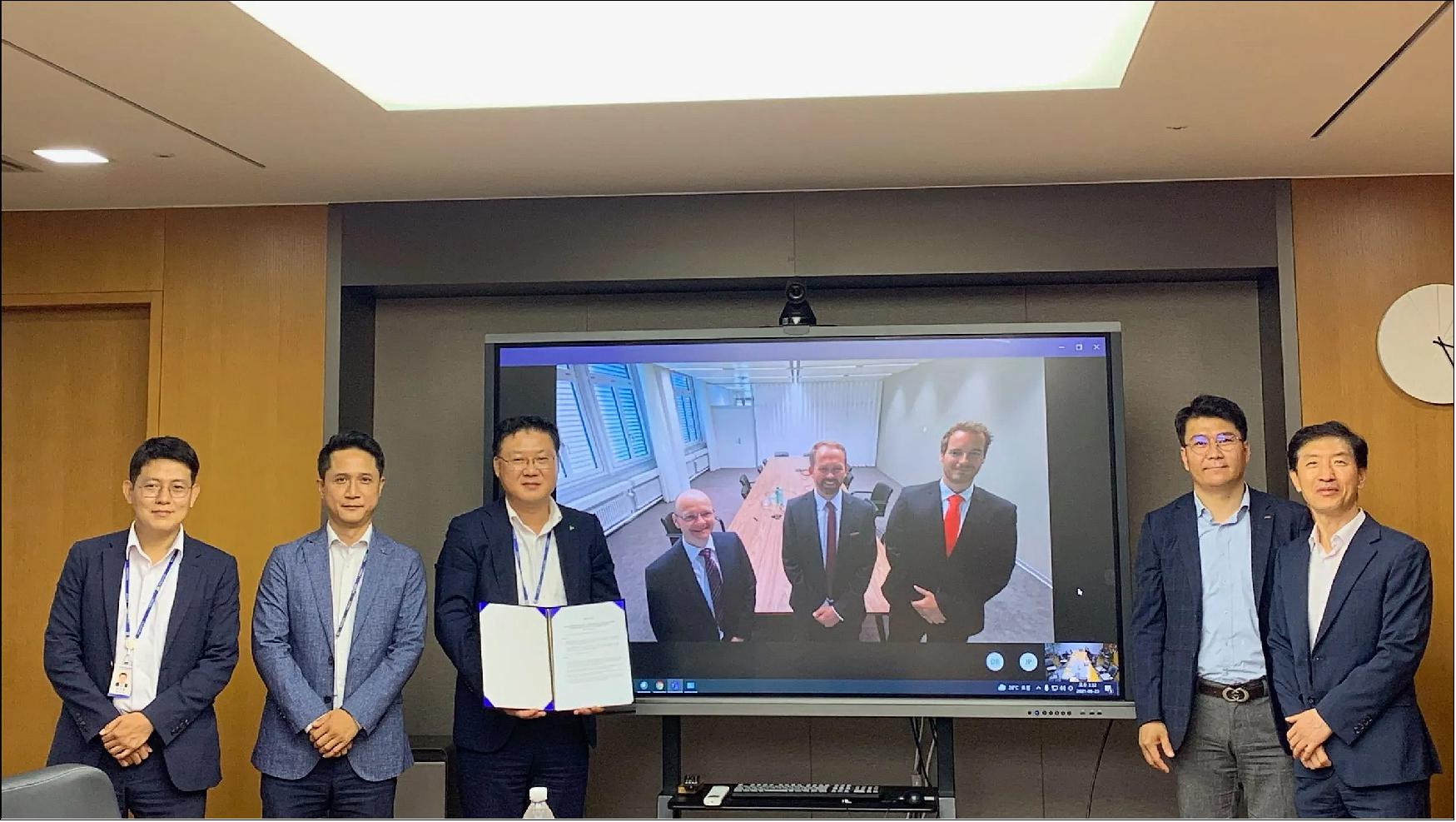
- HGS and ABB will provide a full, turnkey package covering engines, turbocharger retrofit solution and NOx certification (liaising with classification societies), supported by digital solutions to monitor the in-service performance of engines and turbochargers. The companies can offer several forms of optimisation targeting specific customer needs and vessel operating profile. This ranges from installing wastegates to engine derating or turbocharger cut-out. In each case ABB and HGS can fully manage the project autonomously.
- The service also enables shipowners to optimise operations on an ongoing basis with the inclusion of ABB Ability Tekomar XPERT, an engine diagnosis solution. The tool offers personalised advisory based on real-time, in-service data that helps shipowners to further reduce fuel costs and CO2 emissions.
- HGS managing director of green engineering sales, Sung Ki Ahn said: “This strategic technical alliance in response to IMO’s new regulations will offer excellent value to our shipowner customers as they aim to reduce emissions and improve efficiency. We are delighted to be able to draw on ABB’s wide experience and understanding of turbocharger and engine tuning.”
- ABB Turbocharging head of global service sales, Dirk Balthasar commented: “We see part-load optimisation as an important part of maximising the benefit of engine power limitations and ensuring that the engine system operates optimally at its new loading. With HGS’ engine technical service capabilities and experience of project management, and ABB’s turbocharging know-how, upgrade capabilities and unique software solutions, this partnership offers a holistic solution that will be hard to find elsewhere.”
• November 1, 2021: Swiss climate tech start-up Daphne Technology has attracted another round of investors including Shell Ventures, Trafigura, AET, and Saudi Aramco Energy Ventures. The US $10.92 million investment will help the start-up to continue leveraging innovative technology to remove greenhouse gas (GHG) emissions from the combustion gas of any fuel type. 138)
- Daphne Technology’s plug-and-play solution breaks down pollutants, such as nitrogen oxides, methane and carbon dioxide, and converts them into non-hazardous by-products, which are either released into the environment or transformed into valuable products.
- Daphne Technology aims to help the transition to net-zero in the maritime and hard-to-decarbonise sectors. The company is currently pursuing commercial deployment and scale-up and is positioning its solutions in landmark projects.
- As Daphne’s technology can be applied to multiple fuel types, it has the potential to make a substantial impact across the energy system.
- Shell Ventures led the CHF 10 million capital raise along with Trafigura. AET, and all previous investors co-invested, including Saudi Aramco Energy Ventures and the Innovation Fund. The capital raise earmarks the second round of funding since Daphne Technology spun off from the Swiss Federal Technical Institute (EPFL) in 2018.
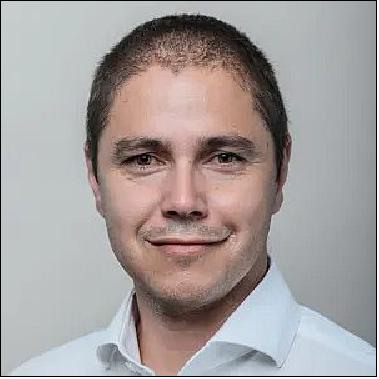
- “We are proud to have attracted best-in-class strategic investors all committed to working together, with Daphne, for an economically sustainable energy transition,” said founder and CEO of Daphne Technology, Dr Mario Michan. “The capital raise enables us to deploy our systems and expand our portfolio of emission reduction solutions. The transition to a more sustainable economy represents a historic investment opportunity.”
- All new shareholders are joining Daphne with the common goal of accelerating the company’s technology deployment and maximising its impact.
- Peter van Giessel, investment director, Shell Ventures, commented: “We are very pleased to support Daphne in their mission to create a more sustainable energy future. Daphne’s technology addresses a significant challenge in the hard-to-abate marine space when it comes to reducing greenhouse gas emissions. Their plug-and-play solution has enormous potential to also help other sectors, and we look forward to supporting them in their journey.”
• October 27, 2021: NY Line, Japan Engine Corporation, IHI Power Systems, and Nihon have been approved by Japan’s New Energy and Industrial Technology Development Organization (NEDO) to participate in a demonstration project that will see the commercialization of vessels equipped with a domestically produced ammonia-fuelled engine. 139) 140)
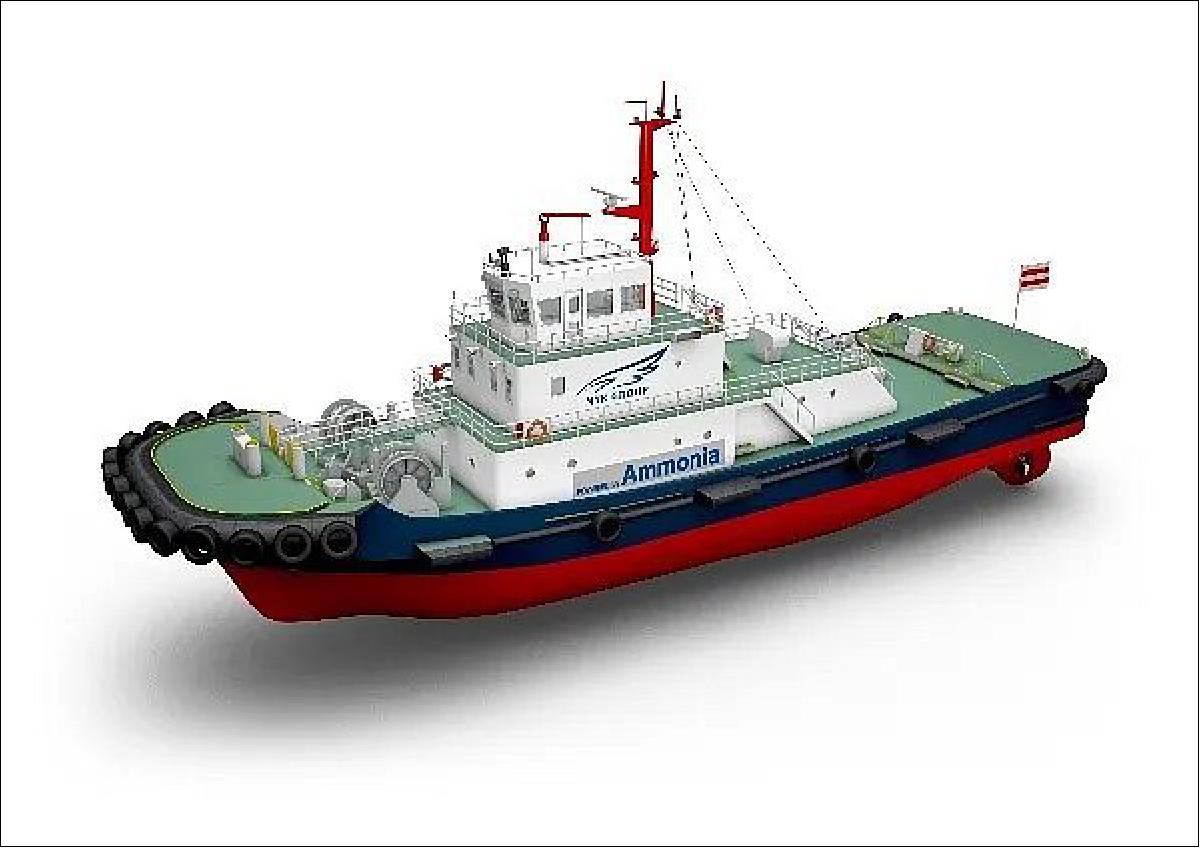
- The demonstration project forms part of the Green Innovation Fund project, a 2 trillion yen fund created in NEDO to significantly accelerate efforts in energy transformation.
- The project, which is scheduled to begin in December with ClassNK, aims to use ammonia as fuel to significantly reduce greenhouse gas (GHG) emissions during voyages and thus introduce an ammonia-fuelled vessel for the good of society earlier than 2030. The four companies and ClassNK will eventually work toward the goal of achieving zero emissions from ships in the future.
- NEDO has approved the following demonstration projects:
The development and operation of an ammonia-fuelled tugboat (A-Tug, Figure 131)
- The ammonia fuel will have a flame retardant bottleneck, which is difficult to ignite, so this project assumes that a small amount of fuel oil will be used as pilot fuel. Targeting the delivery of A-Tug in FY2024, the companies aim to reduce GHG emissions by achieving an ammonia fuel mixed combustion rate of 80 percent or higher.
- The companies will confirm safe operation in demonstrations aimed to improve the mixed combustion rate with a view to achieving zero GHG emissions by using biofuel as a pilot fuel in the future.
Ammonia-Fuelled Ammonia Gas Carrier (AFAGC)
- Targeting the ship’s delivery in FY2026, the companies will develop and operate an ammonia-fuelled ammonia gas carrier (AFAGC) with the concept of transporting ammonia as cargo and using the cargo and ammonia gas vaporised from the cargo as fuel during the voyage.
- The companies aim to reduce GHG emissions by achieving a maximum ammonia fuel mixed combustion rate of 95 percent for the main engine that moves the ship, and an ammonia fuel mixed combustion rate of 80 percent or more for the auxiliary engine that runs the generator.
• October 26, 2021: Weathernews Inc. has launched an upgrade of its Carbon Intensity Monitoring (CIM) Service, the CO2 emission monitoring service for the shipping industry that was initially launched in April this year. The CIM service provides visualization of the CO2 emissions of vessels to help shipping companies meet IMO regulations. 141)
- In order to achieve greenhouse gas (GHG) reduction targets, the International Maritime Organization (IMO) adopted the carbon intensity indicator (CII) rating scheme as a new regulation applicable to ocean-going vessels. As a result, the environmental performance of a vessel will be evaluated on the basis of its annual energy efficiency starting in 2023, making energy efficiency measures imperative for shipowners and ship management companies.
- In order to address this new regulation, Weathernews has upgraded the CIM Service to enable real-time measurements of CO2 emissions during voyages. The company has also added a function where the environmental performance can be evaluated based on CO2 emissions, fuel consumption and the distance sailed.
- By using CIM, shipowners and ship management companies will be able to check the volume of CO2 emissions and environmental performance of their vessels in a timely manner.
- ClassNK has certified the CIM Service as an innovative solution that leverages digital technology.
- While the reliability of the operational data and the calculation method is essential when calculating the CO2 emitted during shipping operations, the data provided through the CIM Service can be used with confidence, for internal data management or for external release as published data, given that the Service has been certified by a third party see document more info.
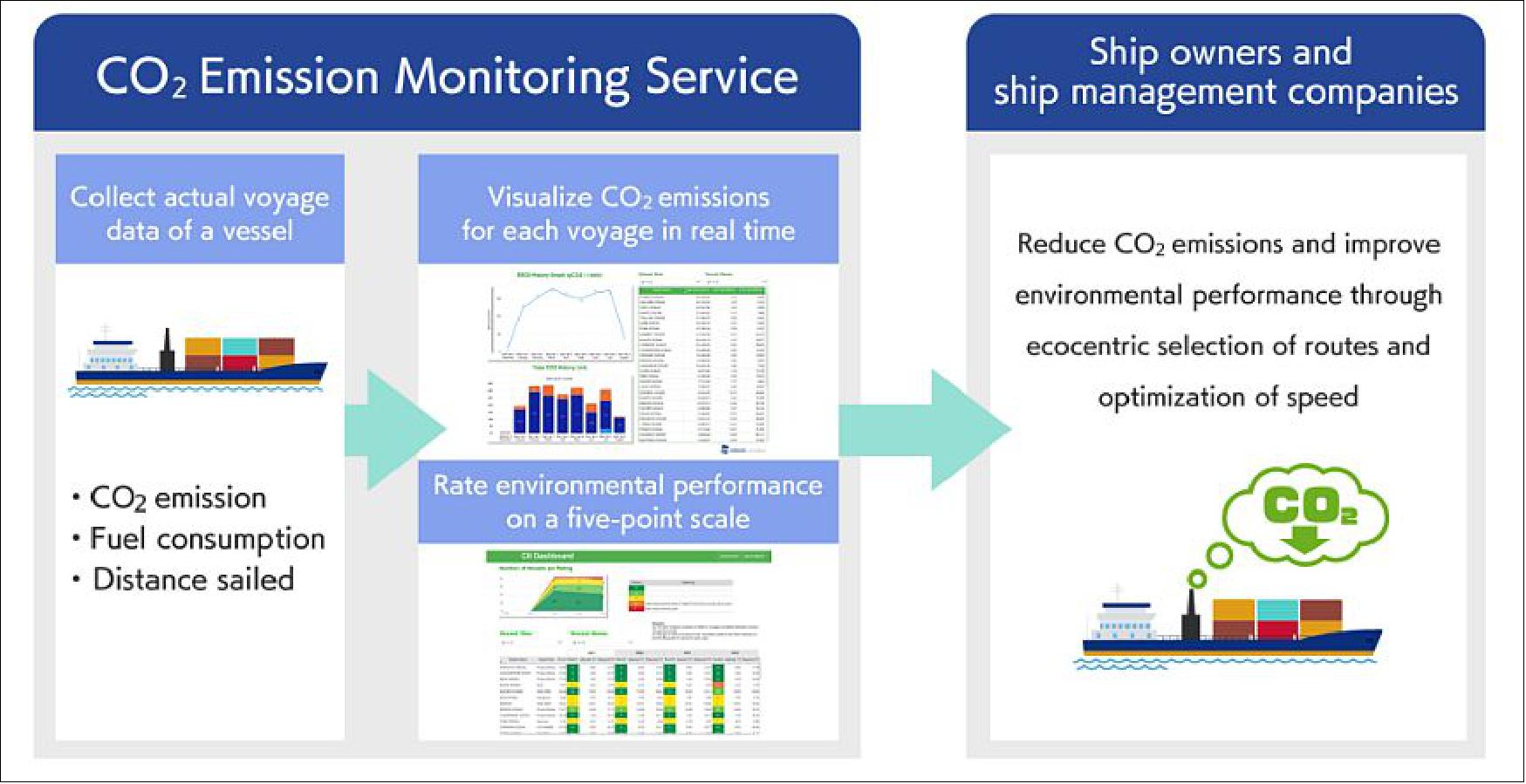
• October 26, 2021: Marine low-speed engine developer WinGD of Winterthur, Switzerland, has strengthened its training capabilities as the number of gas-fuelled vessels on order surges. Among the investments, the company has expanded its network of training locations and added new online tools, making it even easier for ship operators to give their crews the skills they need. 142)
- According to DNV’s Alternative Fuels Insight, the number of gas fuelled vessels in operation is expected to grow from 221 today to nearly 500 by 2023. While much energy goes into projecting the supply and bunkering infrastructure needed to support that growth, less focus is placed on the extra demand it will create for seafarer training.
- “Marine engines in general are getting more complex and require more understanding from the crew to operate them in an optimal and safe way,” said WinGD general manager customer training, operations, Gregory Sudwoj. “Our investment in making engine training more accessible is just another way in which WinGD is adding value for ship owners and enabling crew to operate assets effectively and efficiently.”
- WinGD’s engine operating courses have traditionally been delivered through its owned facilities in Winterthur, Busan and Shanghai. Over the past few years WinGD has enlisted a global network of training partners at locations including the Philippines, India, Greece and Poland. Further locations will follow.
- WinGD representatives were on hand earlier this month to celebrate the opening of the new low-speed engine training centre at the Maritime University of Szczecin (MUS) in Poland. The highly specialized training laboratory features a WinGD engine room simulator offering virtual reality training to equip crew with real-world experience. Proper operation and maintenance procedures of complex engine parts and subassemblies are explained with the help of interactive 3D animations.
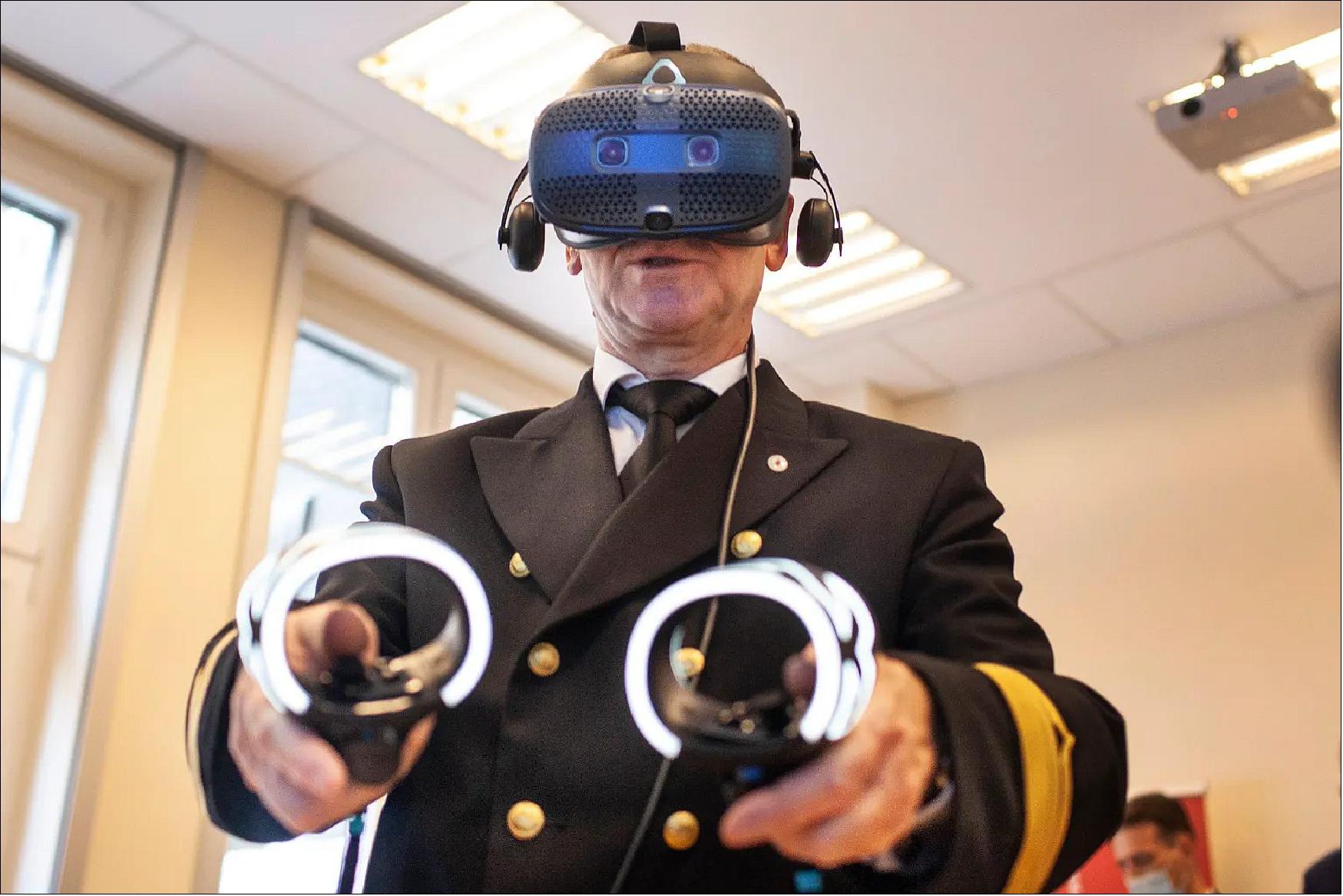
- “The cost and hassle of travelling is a limitation for whoever delegates crew members for training, especially during the pandemic,” said Gregory Sudwoj. “Together with partners like MUS we can make access easier and wider, respecting crews’ time and removing unnecessary expense and complications for the shipowner. With the number of LNG fuelled vessels coming into operation, it is essential that we ensure that our customers’ crew are well equipped with the knowledge and confidence they need to optimize these vessels.”
- As well as the standard five-day engine operator course, these training facilities can offer a range of additional courses – including those for auxiliary engine-room systems – via computer-based learning.
- Online training is another important element of ensuring that seafarers have access to the training they need. Since global travel restrictions began to emerge in February 2020, WinGD has been delivering training digitally. What started as instructor-led presentations with video from the instructor’s simulator have been developed into a full cloud streaming service delivering a truly interactive training experience.
- Soon, every participant will be able to run their own computer simulation with the instructor able to monitor and provide feedback. The system has been tested in Asia and Europe and WinGD is now building up server infrastructure for a global roll out.
- Aside from expanding access to training, WinGD has also worked with partners to build bespoke simulation training facilities for customers using its X-DF dual-fuel engines. And the company will soon unveil a simulator dedicated to LNG carriers, which feature a different machinery arrangement from other merchant vessels, deploying twin main engine propulsion concept.
• October 25, 2021: Klaveness Combination Carriers (KCC) has signed a Letter of Intent with technology company Shipshave to implement its semi-autonomous hull cleaning solution across its fleet. 143)
- Shipshave ITCH (In-Transit Cleaning of Hulls) performs hull cleaning while the vessel is sailing to prevent the early-stage growth of hull fouling. Shipshave reports that its technology has proven fuel savings of around 10 percent when in regular use. The operational cost of ITCH is less than 1 percent of current technologies, according to the company.
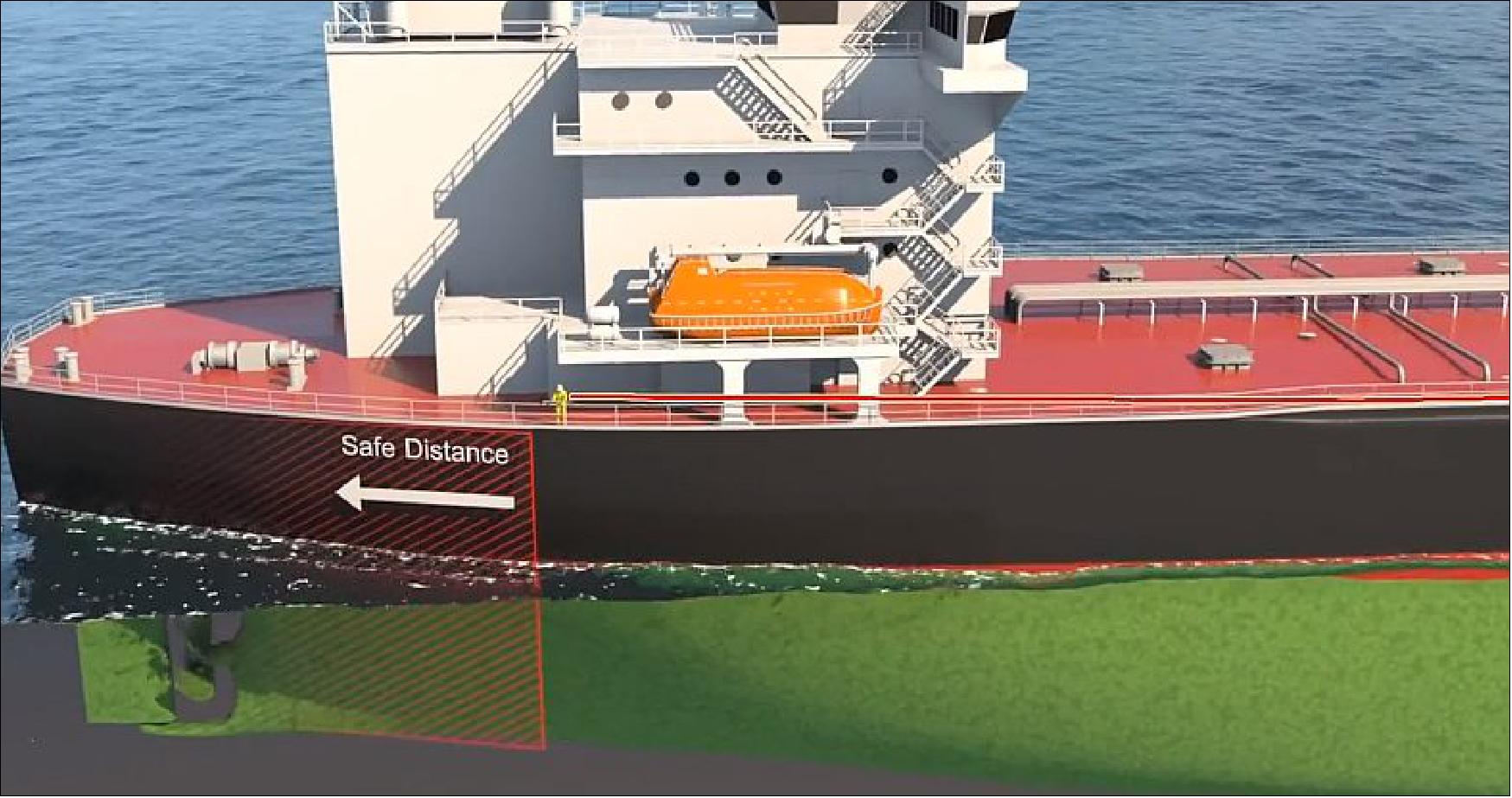
- A successful pilot of the solution onboard KCC’s vessel Ballard throughout 2021 improved fuel efficiency and provided the shipping company with sufficient confidence to expand the scope of the pilot and aim for fleet-wide rollout.
- Biofouling on ships’ hulls is a major concern for shipping companies as it not only heightens fuel consumption by increasing resistance between the ship and the water, but also causes the transfer of species from their native to non-native environments, disrupting the ecological balance. Keeping the hull of a ship clean and free from barnacle growth prevents the transfer of these species and ensures smooth contact between the ship and the water it is sailing through.
- Shipshave’s lightweight plug and play ITCH system is a semi-autonomous electric propulsion robot that cleans the hull underwater, while the ship is in operation. The system can be installed and used by crew onboard. Soft brushes move up and down the hull in a defined pattern to remove barnacles.
- Shipshave has delivered approximately 10 ITCH robots to date.
- “Reducing the marine growth on the underwater hull of our vessels by applying Shipshave’s innovative solution among others, is an important part of KCC’s efforts to improve energy efficiency for substantially reducing CO2 emissions and improving the sustainability of our business,” said CEO of KCC, Engebret Dahm.
- “Seeing KCC’s seafarers taking ownership of improving their fuel efficiency is rewarding,” said Eirik Eide from Shipshave.
- “We see an accelerating uptake from KCC and other shipowners driven by a desire to go green and the upcoming Carbon Intensity Indicator,” added CEO Rune Freyer of Shipshave.
• October 21, 2021: Stena of Göteborg, Sweden, and methanol producer Proman have committed to jointly develop a retrofit & supply solution, enabling both Stena’s vessels as well as third party vessels to experience the immediate environmental benefits and greenhouse gas emission reductions delivered by methanol. 144)
- By switching to this fuel, methanol-powered vessels can lead the transition to a lower carbon future and significantly reduce the greenhouse gas emissions generated by conventional oil-based fuels, bringing an immediate improvement in air quality around ports and shipping lanes. Sulphur oxides (SOx) and particulate matter emissions are practically eliminated, carbon dioxide (CO2) emissions reduced, and nitrogen oxide (NOx) is cut by 60 percent. Furthermore, methanol’s biodegradable and water-soluble qualities significantly reduce the risk to marine environments.
- Proman and Stena will jointly offer a turn-key solution for the shipping industry to benefit from a methanol-based pathway to a sustainable low-carbon future. In 2015 Stena was the first shipowner in the world to convert a large vessel to methanol power together with a current partner. Since then, the vessel has been operated safely and conveniently, thereby demonstrating the potential of using methanol as a marine fuel. Methanol produced from natural gas brings an immediate CO2 reduction which will be further reduced to over 90 percent as renewable and sustainable methanol becomes more widely available as marine fuel.
- Per Westling, CEO, Stena RoRo, said: “We believe that methanol is a clear frontrunner in shipping’s search for fuels beyond the fossil default and we are proud to be playing our part to help build the market for alternative fuels within shipping. We converted Stena Germanica to methanol power already in 2015 with another current partner, and that gives us valuable experience both from a conversion and operational perspective.”
- The plans for a Retrofit & Supply solution build on the previously announced joint venture between Stena Bulk and Proman for three methanol-ready tankers. The first of these vessels, the 49,900 DWT Stena Pro Patria will be delivered in early 2022, with a further three Proman-owned but mutually operated dual-fuel vessels due in 2023.
- Carl-Johan Hagman, CEO, Stena Rederi, said: “This announcement builds on the exciting and fruitful partnership that Stena Bulk has already forged with Proman and gives Stena another avenue to explore the use of methanol on more ship types.”
- David Cassidy, chief executive of Proman, said: “Methanol is the only available alternative marine fuel that offers immediate emissions reductions, dramatically improving air quality and delivering a clear shipping decarbonization pathway for 2050 and beyond. Unlike other alternative marine fuels, methanol utilizes existing technology and is safe and widely available. Proman’s partnership with Stena has grown from strength to strength. Our combined vision is to dramatically accelerate the energy transition in shipping and not only talk about changing our environment but to actually make it happen. We will leverage both companies’ ambition and expertise to make methanol more widely available to vessel owners around the world and help them to join us on the transition to a cleaner shipping industry.”
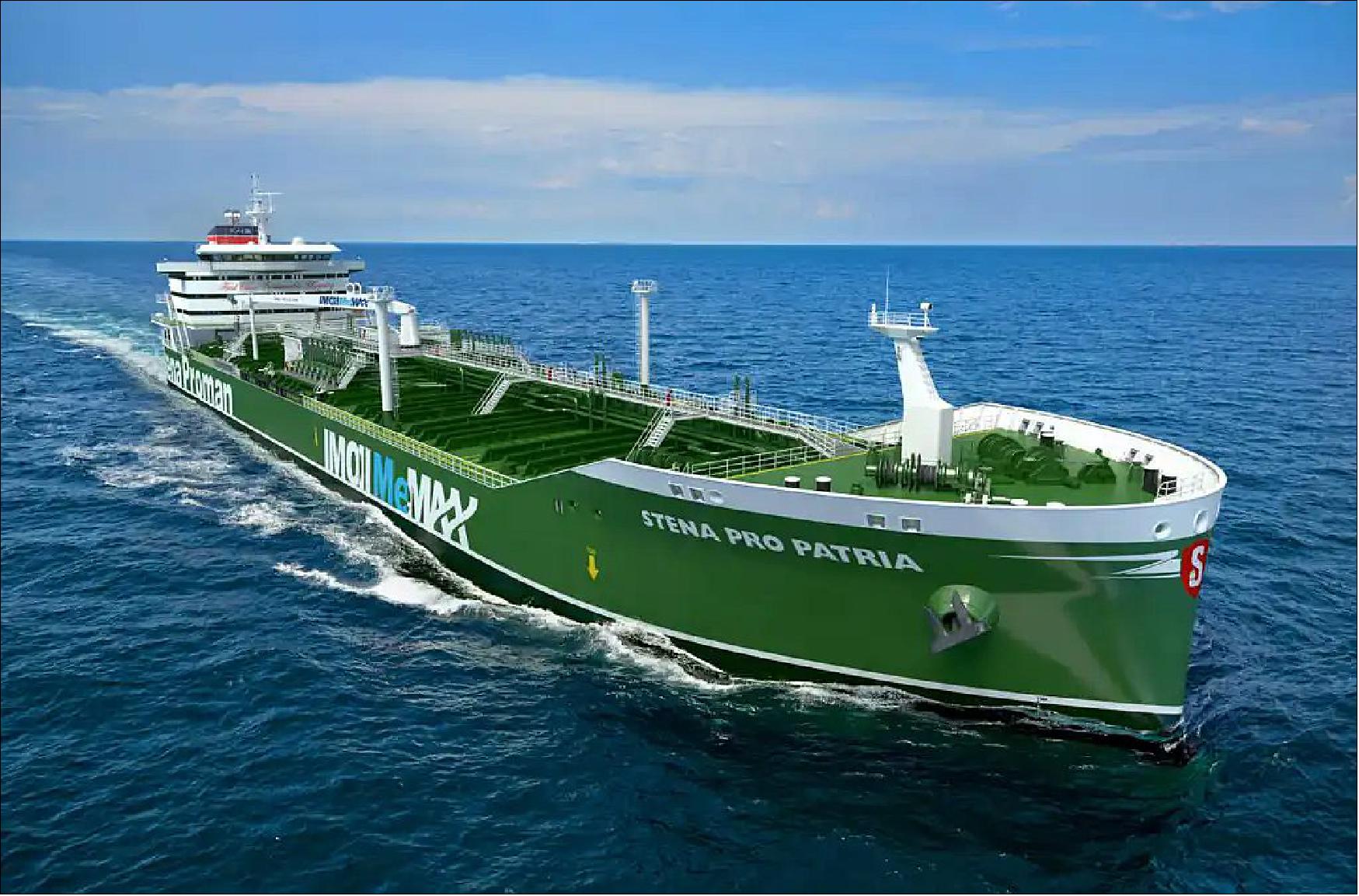
• October 20, 2021: RightShip has argued that the IMO’s Energy Efficiency Existing Ship Index (EEXI) and Carbon Intensity Indicator (CII) to reduce greenhouse gas (GHG) emissions slated for 2023 may be too slow to enforce change by only factoring in operational considerations, missing out on the crucial emissions reduction capabilities of the Energy Efficiency Design Index (EEDI). 145)
- The RightShip organization’s latest review reveals the IMO’s recent announcement fails to account for potential GHG savings through mandated design minimums. It states that for existing vessels to meet the EEXI, the IMO will be relying almost entirely on overridable engine power limitations (EPLs) i.e., running vessels at a slower speed – doing little to pave the way for the technology needed for long-term industry transformation.
- RightShip CEO, Steen Lund said: “At RightShip, we work with global sectors that are under a lot of pressure to decarbonize. Whether it’s oil and gas, renewables, or other heavy industry, de-risking the vessel selection process and eliminating unnecessary emissions can have a big impact on harm reduction for people and planet.
- “We support the IMO’s commitment to new carbon emissions regulations. However, RightShip is committed to working towards a maritime industry that causes zero harm, and we have concerns about the limitations associated with the EEXI. To achieve industry goals, we must seek out the most innovative solutions and as such, we welcome all opportunities to collaborate with the industry to develop transformative results.”
- As part of its efforts to accelerate the decarbonization of the industry, RightShip has been enabling superior chartering decisions through technology using its GHG Rating tool since 2012. This tool provides a systematic, transparent way to gain a competitive advantage when selecting vessels by singling out the most efficient, and sustainable ships, considering both the operational profile and vessel design. This approach offers the industry a way to meet the IMO’s mandates, while providing a complete holistic overview to make more confident chartering decisions and reduce harm to the environment.
- Kris Fumberger, RightShip’s head of sustainability and environment noted: “Historically, RightShip has seen the market utilize overridable EPLs to improve their GHG Rating. However, we revised our EPL requirements in 2020 and have since seen a significant move towards other energy saving equipment (ESE) to meet GHG Rating expectations. This confirms that vessel owners and operators can utilize innovative sustainable measures to improve fleet efficiency.”
• October 20, 2021: The European Community Shipowners Association (ECSA) has published its position paper on the FuelEU Maritime proposal, which aims to foster the uptake of cleaner fuels in shipping. ECSA supports the objective but notes that the proposal may become a missed opportunity due to the use of documents provided by non-EU fuel suppliers to calculate carbon savings contributing to the EU’s climate targets, which may create substantial enforcement loopholes. 146)
- ECSA suggests that making the EU fuel suppliers responsible for meeting the fuel standards will address these concerns and will be consistent with other proposals of the ‘Fit for 55’ package. Fostering demand is key and the EU emissions trading system (ETS) revenues, the carbon contracts for difference under the EU ETS innovation fund and a higher multiplier under the Renewable Energy Directive should be used to bridge the price differential between cleaner and conventional fuels.
- “Even though an international solution for shipping would be preferable, shipping should contribute its fair share to address the climate crisis, at EU level as well. ECSA supports the objective of the FuelEU Maritime proposal to foster the market uptake of cleaner fuels that are currently not affordable or commercially available. However, the proposal should be more consistent with other proposals of the ‘Fit for 55’ package and with the overall increased climate ambition of the EU” said Claes Berglund, ECSA’s president.
- Under the current proposal enforcement for biofuel blends purchased outside the EU will rely only on paper documents provided by non-EU fuel suppliers. Using these documents to calculate carbon savings contributing to the EU’s climate targets, may create substantial loopholes and, ultimately, an enforcement minefield.
- “FuelEU may become a missed opportunity for the uptake of clean fuels in the sector. Making the EU fuel suppliers responsible for meeting the fuel standards will substantially address the enforcement concerns. Fostering demand is key and the EU ETS revenues, the carbon contracts for difference under the EU ETS innovation fund and a higher multiplier under the Renewable Energy Directive should be used to bridge the price differential between cleaner and conventional fuels” said Sotiris Raptis, ECSA’s acting secretary general.
- Flexibility is welcome but a new MRV system is unnecessary and burdensome, according to a statement released by ECSA. Ships should also not be penalized when onshore power supply is not available in ports, the statement read.
• October 15, 2021: Caledonian Maritime Assets (CMAL) and the University of Strathclyde have secured a £30,000 grant to fund a six-month research project to explore the technical, operational and commercial viability of using zero-carbon fuels to power ferries. 147)
- The funding award is a result of a successful joint bid to the Department for Transport’s clean maritime demonstration competition (CMDC), which was launched in March 2021 to accelerate maritime decarbonisation in the UK.
- The project, called Lifecycle Energy Solutions for Clean Scotland/UK Maritime Economy, is a feasibility study that will explore the most effective solutions that will drive down carbon emissions from the maritime sector, but will also support sustainable economic growth and industry competitiveness.
- CMAL’s team of ship designers, naval architects and marine engineers will work alongside marine academics and researchers at the University of Strathclyde to conduct a life cycle assessment on the viability of using ammonia, hydrogen, and main grid electricity for ferries. The team will design robust business scenarios based on 23 ferries on 27 routes on the west coast of Scotland, including highly reliable predictions of the costs and benefits of the proposed alternative fuel sources and a comparison to the use of diesel.
- The project outputs will feed into CMAL’s future decarbonisation plan and will contribute to the Scottish Government’s ambition to increase low emission vessels in the ferry fleet by 30 percent.
- John Salton, fleet manager and projects director at CMAL said: “Carbon-free fuels are in the early stages of development across the UK maritime sector, but there are various views on the most effective ways for these fuels to be produced, distributed and used onboard for the clean shipping economy. This project will explore a wide variety of scenarios based on actual ferries and routes in operation today. We’ll look at environmental impact and maritime safety and regulation, as well as costs, vessel design, fuelling infrastructure and supply chain constraints.
- “Essentially, we are aiming to produce a roadmap that will direct future uses and ultimately lead to a carbon-free ferry fleet. The shipping industry is a significant source of carbon emissions and we must do our bit to explore and create new solutions. We’re just weeks away from welcoming COP26 to Scotland. Climate change means we can’t rely on fossil fuels to continue powering ferries into the future and projects like this are vital to inform how we transform the sector. We need new and proven technologies that are better for the environment, as well as practical, reliable and affordable.”
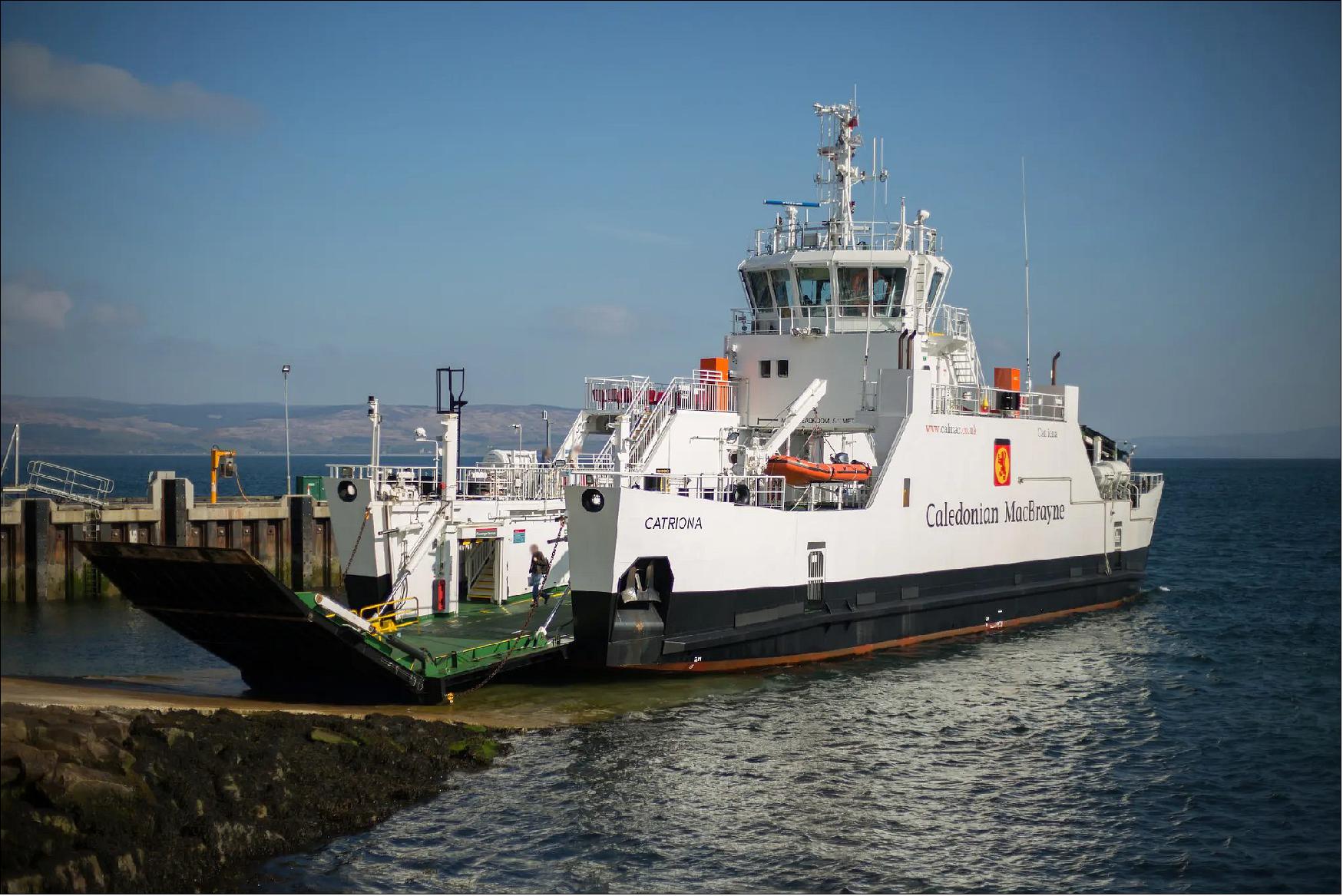
• October 15, 2021: Kongsberg Digital has joined forces with ABS to integrate Vessel Insight with the ABS My Digital Fleet platform to offer shipowners, ship managers and charterers seamless access to powerful analytics services. 148)
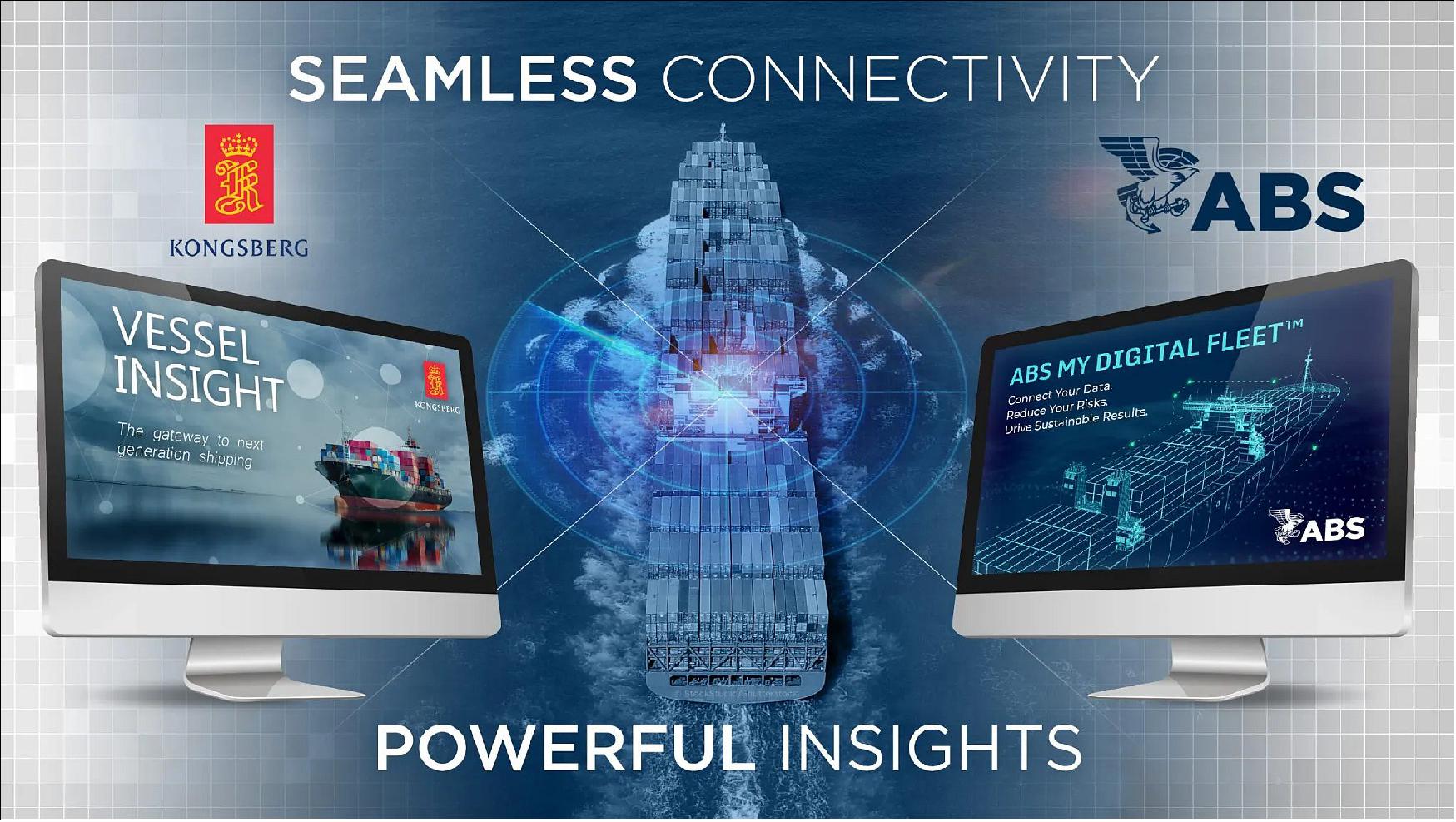
- ABS My Digital Fleet is a customizable risk management platform that seamlessly integrates data to provide real-time insights for driving sustainable operations and reducing operational risks.
- Kongsberg Digital’s Vessel Insight vessel-to-cloud data infrastructure captures, aggregates, and contextualizes all data derived from a vessel’s sensors and other assets, transferring it for storage in the cloud through the proprietary Kongsberg network – ‘Kognifai Cloud’ – a specialized VPN solution. The data collected through Vessel Insight will be made accessible to the ABS My Digital Fleet platform for the development of analytics services.
- As part of the ABS My Digital Fleet Alliance Program, ABS will now offer Kongsberg Digital’s Vessel Insight infrastructure as an integrated service with ABS My Digital Fleet. Kongsberg Digital’s Kognifai open digital Marketplace, which offers third party solutions fully integrated with its Vessel Insight infrastructure, will now offer ABS My Digital Fleet. The ABS My Digital Fleet Alliance Program nurtures an ecosystem of industry-trusted intelligence and technology providers enabling integrated insights for clients on one unified platform.
- “The potential of digital technologies to advance the cause of safety and operational excellence, not to mention the decarbonisation of our industry, is significant. That’s why this is such a key announcement for the digitalisation of shipping. Together, Kongsberg Digital and ABS are putting more power in the hands of our users; widening access to deep operational insights and making it simpler to realize the huge benefits offered by advanced data analytics,” said John McDonald, ABS executive vice president and chief operating officer.
- “The maritime industry is facing stricter environmental regulations and demands. Collecting data to analyze, predict and improve processes for vessels and fleets is key to meet the new regulations while gaining a competitive edge. By combining ABS’ unique data integration and analytics platform with the Vessel Insight data capturing infrastructure, we are strengthening our position to offer an even better integrated service of high value for the industry. We believe this alliance will further spark the incentives for existing and prospective Vessel Insight subscribers to utilize the benefits of digitalisation within the maritime industry,” said Andreas Jagtøyen, executive vice president of Digital Ocean, Kongsberg Digital.
• October 15, 2021: Scandlines has chosen to install the Norsepower Rotor Sail onboard its hybrid ferry Berlin following a 5 percent CO2 emissions reduction from installation onboard the Berlin’s sister ship last year. 149)
- The Berlin operates the route between Rostock and Gedser. The route is perfectly located to meet the requirement that gives the greatest benefit of the Rotor Sail for propulsion, namely that the wind must be perpendicular to the sail.
- Scandlines’ COO, Michael Guldmann Petersen, noted: “We expected the Copenhagen Rotor Sail to provide a 4 – 5 percent CO2 reduction. That expectation has been met, so we have now taken the next step and prepared the sister ferry Berlin for installation.”
- “Our route across the Baltic Sea is north/south bound, and the prevailing wind is from the west or east. In other words, our Rotor Sails have optimal conditions.”
- “There has generally been a lot of interest in the Rotor Sail – and in the beginning even wonder among the passengers about the ‘chimney.’ Most of the crew are now also masters of technical explanations that are easy to understand,” said Petersen.
- Tuomas Riski, CEO of Norsepower, commented: “We are delighted that Scandlines is expanding its use of our Rotor Sail technology after achieving its CO2 emissions reduction targets on its first vessel, the Copenhagen. Our Rotor Sail technology is technically applicable to approximately 30,000 vessels in the current global fleet of ships and we hope that this is a further signal to shipowners and operators that confidence is growing in wind propulsion technology.”
- The preparation for the Rotor Sail includes building a steel foundation on the ferry, on which the Rotor Sail will be fixed. The initial work took place when the Berlin was on a planned yard stay at Remontowa in Poland at the end of May.
- The installation of the Rotor Sail itself is scheduled for 2022.
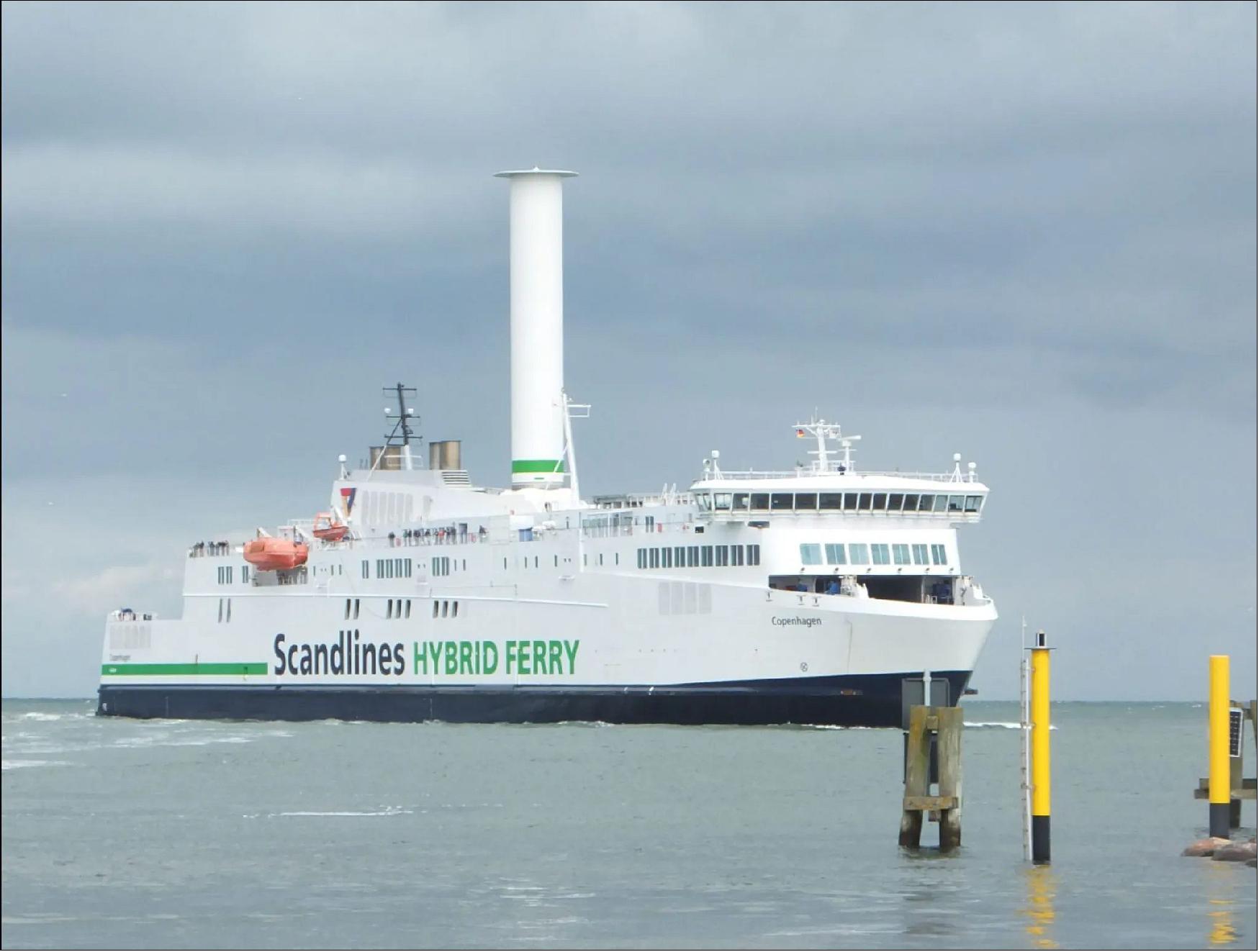
• October 11, 2021: Norwegian shipowner Eidesvik Offshore and Wärtsilä have signed a landmark cooperation agreement aimed at converting an offshore supply vessel (OSV) to operate with an ammonia-fuelled combustion engine with required fuel supply and safety system. 150)
- This project will be the first of its kind ever in the world and has a provisional completion target by the end of 2023.
- The OSV considered for a retrofit currently has Wärtsilä dual-fuel engines operating primarily with LNG fuel. The conversion will allow the vessel to operate with a 70 percent ammonia blend. Wärtsilä has already successfully laboratory tested an engine fuelled with a 70 percent ammonia blend. The ultimate goal is to achieve operation with 100 percent ammonia and with a minimum ignition fuel requirement.
- As a fuel, ammonia has the potential to drastically reduce emissions of CO2. Both Wärtsilä and Eidesvik have stated their commitment to supporting the industry’s efforts to decarbonize its operations.
- “Using ammonia as a fuel is seen as a key future contributor to shipping’s energy transition, and we’re excited to be the first offshore ship owner taking this step. This project is yet another confirmation of our strong reputation as a pioneer in implementing new environmental technologies in both newbuilds and the existing fleet,” said Eidesvik CEO & president, Jan Fredrik Meling.
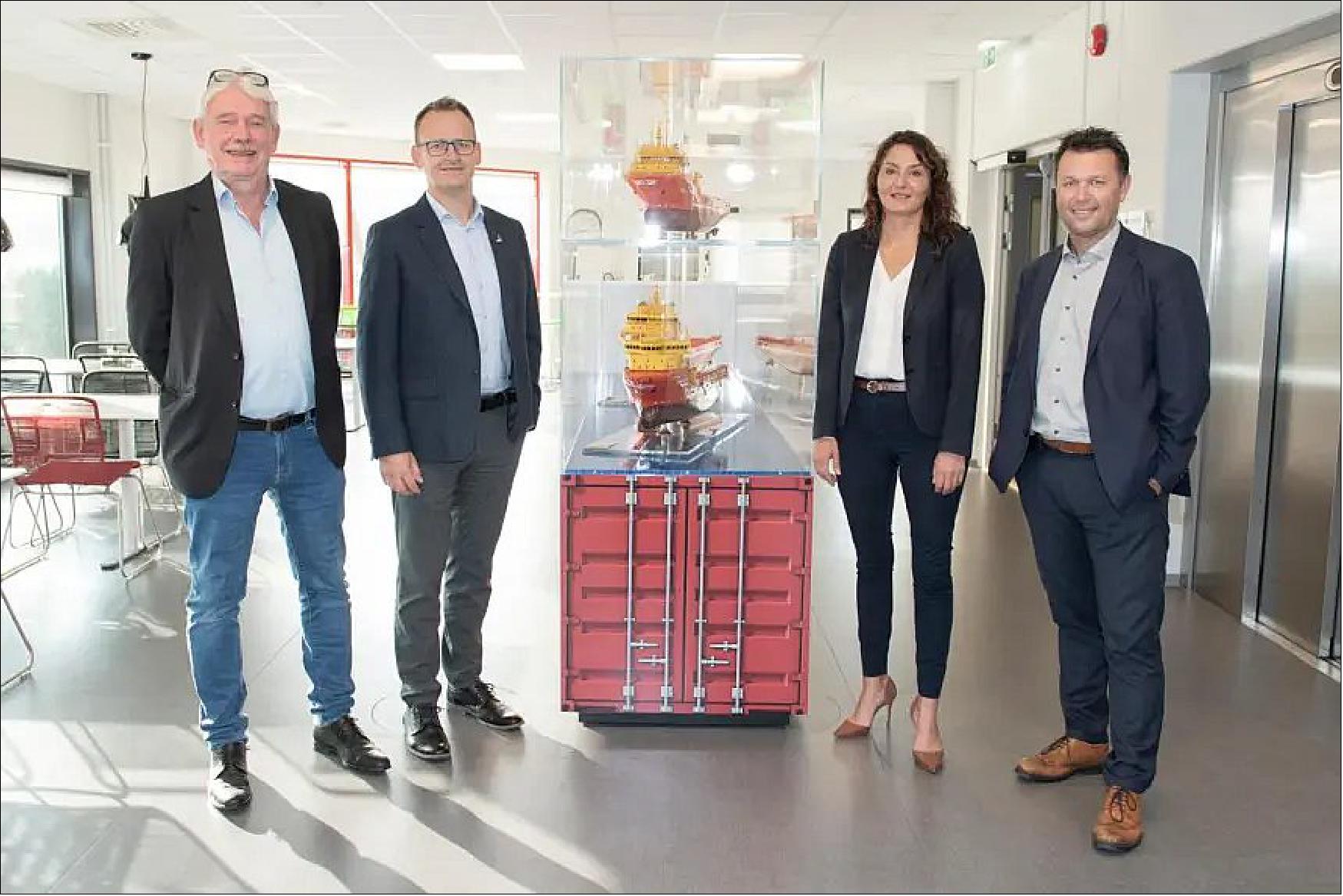
• October 1, 2021: FrontM and Bulugo have teamed up to simplify the procurement of fuels and lubricants for sea-going personnel. 151)
- Under the agreement, existing customers of both companies will now have access to Bulugo’s online bunker fuel and lubricants procurement platform and FrontM’s marketplace. The partnership aims to bring e-procurement directly to remote customers, simplifying the traditional marine fuel and lubricants sourcing process and making it easier for shipping firms to find available bunker fuel and lubricants at competitive prices.
- Onboard crew will be able to connect with new suppliers, seek quotes, assess responses, negotiate prices, and make informed decisions on fuel and/or lubricant offers.
- For those dealing with engine issues and corrosive wear, this provides a convenient and straightforward way to order lubricants, enabling them to take corrective action more quickly and helping to minimize costly failure or expensive unplanned maintenance.
- The new procurement integration will be freely available to all existing customers and their fleets, globally.
- Lisa Moore, chief commercial officer, FrontM commented: “As more shipping companies and operators leverage digital and platform technologies to obtain and automate their purchasing and workforce automation processes, we believe the alliance with Bulugo enables our clients to better align their purchasing requirements during their online fuel procurement process. The combination of FrontM’s marketplace approach to service consumption and Bulugo’s fuel quoting and procurement delivery platform offers our partners and their customers a transformative shopping experience by reducing procurement lead times and providing time-critical quotes that match them to the best carrier.”
- Peter Rossi, founding director, Bulugo commented: “Digital behaviors are constantly evolving with e-commerce and onboard solutions being a big part of the digital shift. This is an ideal enhancement for existing FrontM customers and for those operators who make spot purchases, especially, where flexibility is key due to limited route planning or tramp trade. Bulugo is now at the heart of vessel activity. As partners, Bulugo and FrontM can leverage each other’s expertise – in shipping and technology to transform ways of working.
- “Bulugo was built to be secure and scalable. We are a platform that integrates at the core of the maritime ecosystem, and FrontM is a perfect example of this. We are excited to collaborate with their global team to maximize the value delivered to shipping companies through their advanced onboard solution.”
• September 30, 2021: Carnival Corporation has committed to installing Silverstream Technologies’ fuel-saving air lubrication system to its Excel-class cruise ship, currently known as hull S717. 152)
- The technology is expected to deliver fuel and emissions savings of more than 5 percent and the order has been placed by or from Meyer Werft shipyard with the 344 m vessel set to make its debut in 2023.
- The Silverstream System uses a series of air release units (ARUs) in the flat bottom of a vessel to generate a rigid carpet of microbubbles that travel the full length of the hull. The technology will be installed during S717’s construction, with Meyer Werft manufacturing the ARUs to Silverstream specifications.
- Like other vessels in its class, the newbuild will be powered by Liquefied Natural Gas (LNG), paving the way for the next generation of low carbon passenger vessels.
- The news follows the order and ongoing installation of the Silverstream System on P&O Cruises’ vessel Arvia, also an Excel-class vessel, which is currently under construction at Meyer Werft shipyard.
- This announcement marks another step in Silverstream’s relationship with Carnival Corporation, which started in 2017 with the installation of its technology on the Princess Cruises vessel Diamond Princess. The independent verification of the performance of the Silverstream System on this vessel – over 5 percent net fuel and emissions savings – as verified by class society Lloyd’s Register laid the groundwork for more installations.
- Ben Clement, senior vice president, newbuilds, refurbishments & product innovation, Carnival Cruise Line, said: “At Carnival, we are committed to building the cruise industry’s most efficient and sophisticated ships. The addition of the Silverstream System on Carnival Cruise Line’s third Excel-class ship will ensure that this vision continues to become a reality. Following the impressive fuel and emission savings on Diamond Princess, and subsequent orders of the System, we value our relationship with Silverstream and are excited to explore more opportunities to champion clean technologies in the future.”
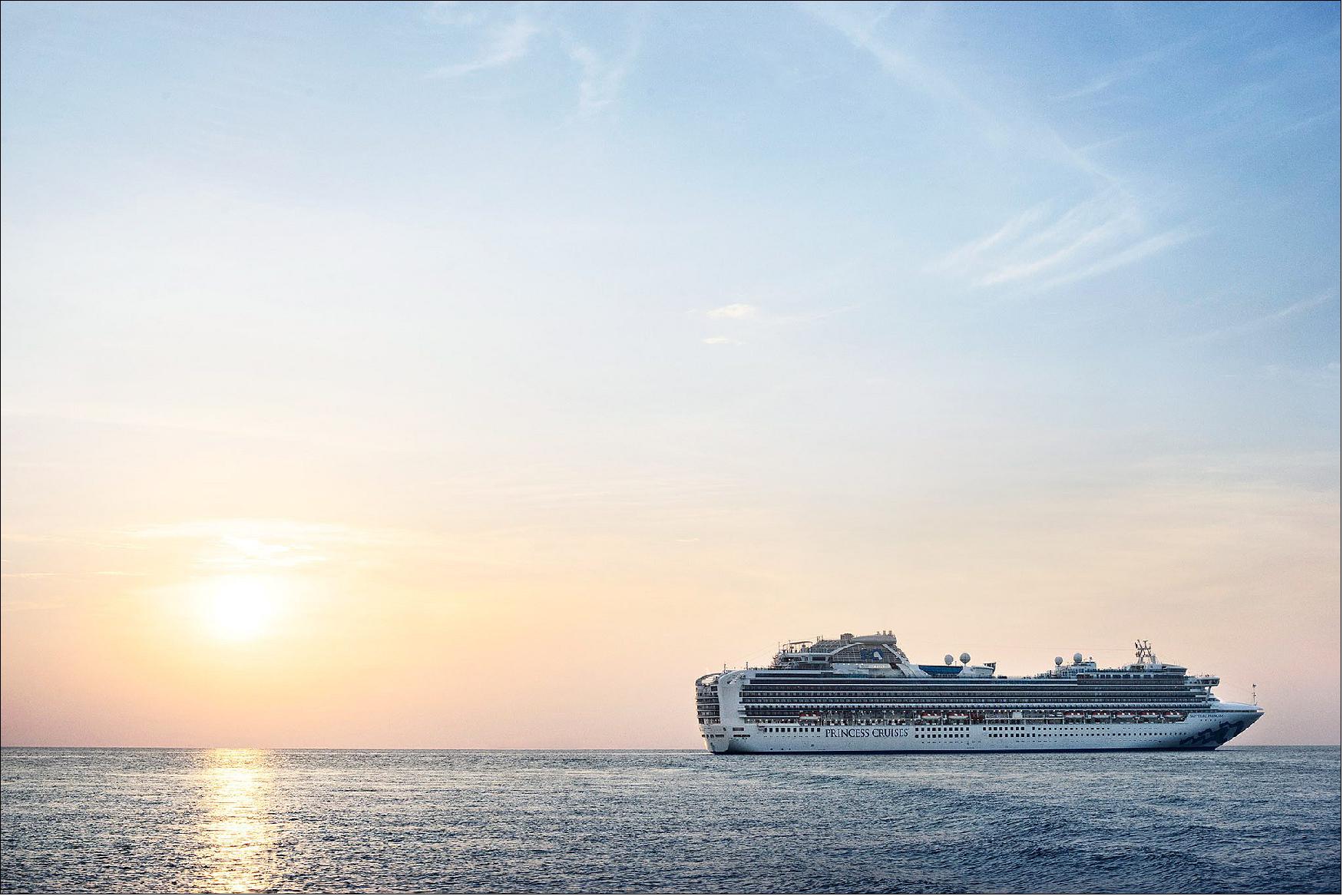
- Noah Silberschmidt, CEO, Silverstream Technologies, said: “We are proud to further cement our strong relationship with Carnival with a second order of the Silverstream System on its Excel-class vessels. A repeat order for our technology from the cruise sector’s leading brand reflects its viability to cut emissions and reduce fuel costs.
- “These powerful savings, combined with our system’s high reliability, availability and low maintenance, means that we have become a critical part of Carnival’s sustainability roadmap. We are continuing to work with Carnival to jointly identify further opportunities to install our technology across its current and planned fleet.
- “We are also pleased to once again work with our friends and partners at Meyer Werft shipyard. Maintaining a close partnership with leading shipyards is a vital part of our efforts to scale installations of our technology as a standard on all newbuild vessels.”
• September 29, 2021: Ship operator and manager Vroon has achieved a 22 percent fuel saving onboard its container vessel, the Indian Express, by optimizing the propulsion system with a controllable pitch propeller. 153)
- The shipping company worked with Berg Propulsion to investigate the possibility of optimizing the propulsion system to improve energy efficiency and reduce CO2 emissions to meet regulations set by the International Maritime Organization (IMO) and improve its sustainability profile.
- Berg Propulsion worked with Vroon to analyze the vessel’s current and future operational requirements and determined its operational profile. “The performance of the original propeller blades was benchmarked against the vessel’s defined operation profile,” said David Sakandelidze, Berg Propulsion business manager – energy and efficiency.
- From here, Berg Propulsion’s simulation tools were used to develop a new propeller geometry. Initial modelling showed superior ship performance could be achieved with the new propeller design. In line with these findings, Berg Propulsion designed blades tailored for the operation, improving efficiency significantly.
- “Efficiency gains are made for much of the time and, at 12 knots, the new blades achieve up to 50 percent higher efficiency than the ones they replace,” said Sakandelidze.
- With performance improved at the speeds most commonly required during operations, Indian Express would achieve 22 percent fuel saving overall, as well as lower emissions that should go farther than the requirements of the IMO’s carbon Intensity Initiative goals for 2026.
- “We have recently put a new focus on CII and EEXI and supporting customers to improve and optimize vessels already in operation,” said Jonas Nyberg, managing director west for Berg Propulsion. “We are excited to partner our customers, and to help them become more efficient while reducing their environmental footprint.”
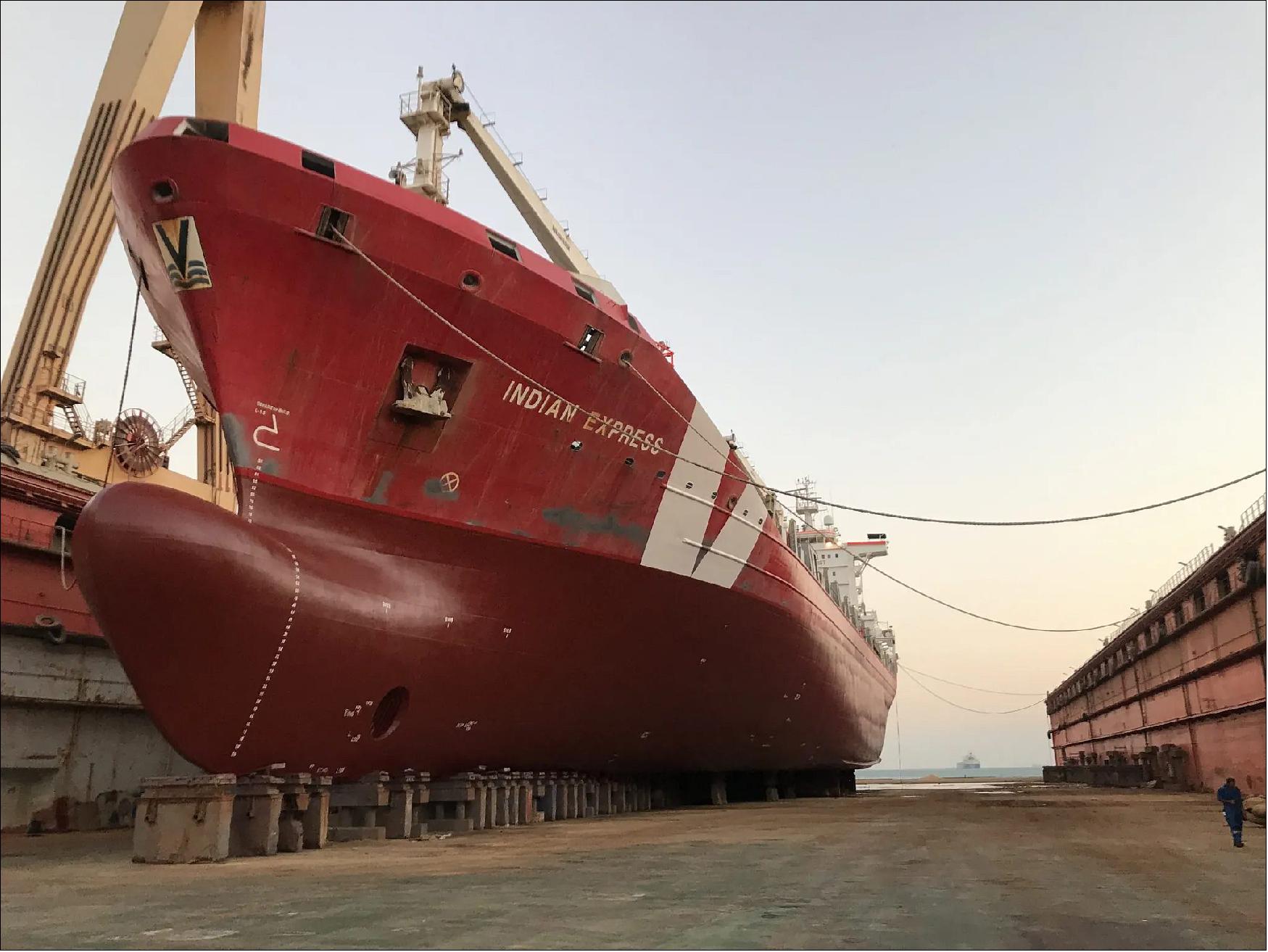
• September 29, 2021: Tokyo-based Weathernews Inc (WNI) has joined forces with Danish firm Vessel Performance Solutions (VPS) to integrate critical performance data from ship systems with its weather routing system to optimize voyage planning. 154)
- The VESPER software platform by VPS records continuous performance data from the hull and propellers, main and auxiliary engines and boilers to determine speed, RPM and fuel consumption estimates. The integration will enable this information to be accessed from WNI’s Optimum Ship Routing (OSR) service.
- WNI’s weather forecasting solution harnesses the power of artificial intelligence (AI), supported by human intelligence and logistics, to provide highly accurate forecasts for avoidance of bad weather that can disrupt voyage schedules. It is installed on around 10,000 vessels worldwide.

- Henrik Faurschou, global product and market strategy leader at WNI said the alliance with VPS is in response to a market expectation for more integrated and comprehensive systems with a high level of predictive functionality.
- Shipping companies including Golden Ocean, G2Ocean, Lauritzen Bulkers and Ultrabulk already use the services of both WNI and VPS, and therefore will be able to instantly take advantage of the integrated solution.
- VPS co-founder, naval architect, Ph.D. Jakob Buus Petersen said: “The joint solution combines the two competencies of vessel performance analytics and weather routing to create a powerful service by using accurate and sophisticated ship models for speed, fuel and load in the voyage optimization simulation.”
- VESPER uses well-established mathematical ship models and calibrates these models against operational data to give precise predictions of speed, fuel and RPM as a function of speed, drought, wind and wave conditions.
- In practice, this will significantly improve the accuracy of voyage cost estimation and calculation of ETAs in voyage planning for OSR users, according to Petersen.
- The integration will provide access to OSR weather data for around 1000 ships presently using the web-based VESPER service, which also includes advanced data validation, a crew feedback module, advanced diagnostics, charter party and voyage monitoring, as well as environmental compliance reports support like EU MRV, IMO DCS and CII support.
- Predictability is key for ship operators and integrating weather forecasting with real-time data on equipment performance makes OSR an even smarter tool to minimize voyage cost,” said Faurschou.
• September 22, 2021: The UN’s International Maritime Organization (IMO) aims to reduce international shipping’s total annual greenhouse gas (GHG) emissions by at least 50 percent of 2008 levels by 2050. To achieve this target, zero emission shipping must be the default choice by 2030. The strategy to meet this target is set to be revised in 2023. 155)
- The Call to Action for Shipping Decarbonisation calls upon world leaders to supercharge the transition and align shipping with the Paris Agreement temperature goal.
- The private sector is already taking important steps to decarbonise global supply chains. This includes investing in RD&D (Research Design and Development) and pilot projects, ordering and building vessels operated carbon neutrally, buying zero emission shipping services, investing in the production of net-zero emission fuels, investing in port and bunkering infrastructure, and assessing and disclosing the climate alignment of shipping related activities.
- Signatories of the Call to Action for Shipping Decarbonisation call on world leaders to:
a) Commit to decarbonising international shipping by 2050 and deliver a clear and equitable implementation plan to achieve this when adopting the IMO GHG Strategy in 2023.
b) Support industrial scale zero emission shipping projects through national action, for instance by setting clear decarbonisation targets for domestic shipping and by providing incentives and support to first movers and broader deployment of zero emissions fuels and vessels.
c) Deliver policy measures that will make zero emission shipping the default choice by 2030, including meaningful market-based measures, taking effect by 2025 that can support the commercial deployment of zero emission vessels and fuels in international shipping.
- Signatories to the Call to Action for Shipping Decarbonisation include Anglo American, A.P. Moller – Maersk, BHP, BP, BW LPG, Cargill Ocean Transportation, Carnival Corporation, Citi, Daewoo Shipbuilding & Marine Engineering, ENGIE, Euronav, GasLog, Hapag-Lloyd, Lloyd’s Register, Mitsui O.S.K. Lines, MSC Mediterranean Shipping Company, Olympic Shipping and Management, Panama Canal Authority, Port of Rotterdam, Rio Tinto, Shell, Trafigura, Ultranav, Volvo, and Yara.
- “Now is the time to raise our ambitions and align shipping worldwide—a significant carrier of global trade—with the goals of the Paris Agreement. We are working closely with our clients to advance the shipping industry’s transition to net zero emissions and, with the support of strong public policy measures, we can accelerate our collective efforts to decarbonise the global economy,” said Jane Fraser, chief executive officer, Citi.
- “For the world to decarbonise, shipping must decarbonise. Our customers are looking to us to decarbonise their supply chain emissions. We are investing significantly in the carbon neutral emissions technologies that are readily available. To make such investments the default choice across our industry, we need a market-based measure to close the competitiveness gap between fossil and zero emission fuels of today and the carbon neutral fuels of tomorrow,” said Henriette Hallberg Thygesen, chief executive officer of fleet & strategic brands, A.P. Moller – Maersk.
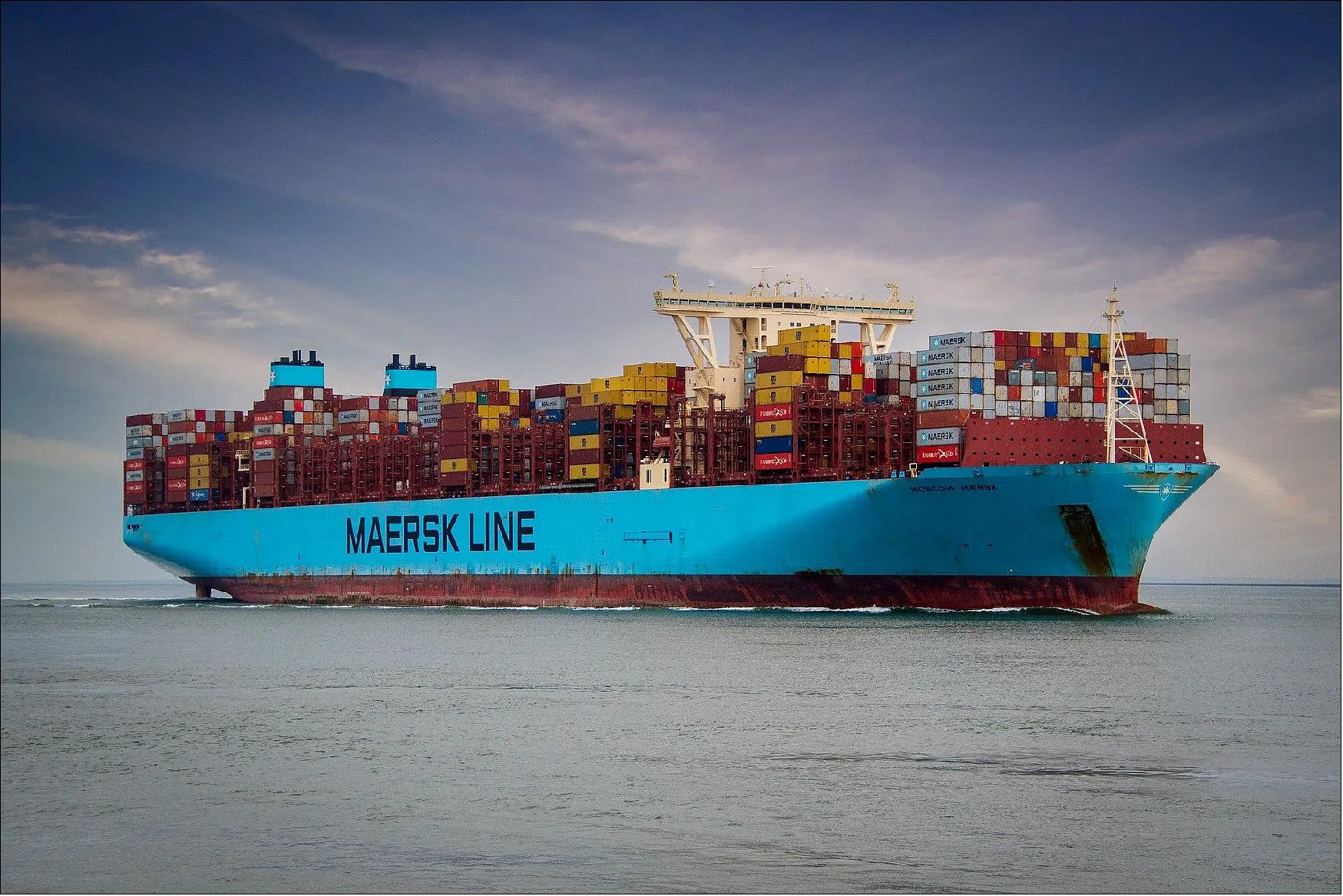
• September 18, 2021: Family-owned Pleiades Shipping Agents S.A. is a medium-size ship owning and management company specialized in tanker trade. The company has committed to Alfa Laval’s PureSOx scrubbers with an Alfa Laval Service Agreement, which includes critical spares, sensor exchange, connectivity and more, to secure compliance with emission limits. 156)
Note: Alfa Laval PureSOx is the leading scrubber solution for meeting SOx (Sulphur Oxide) emissions limits, including the 2020 global sulphur cap.
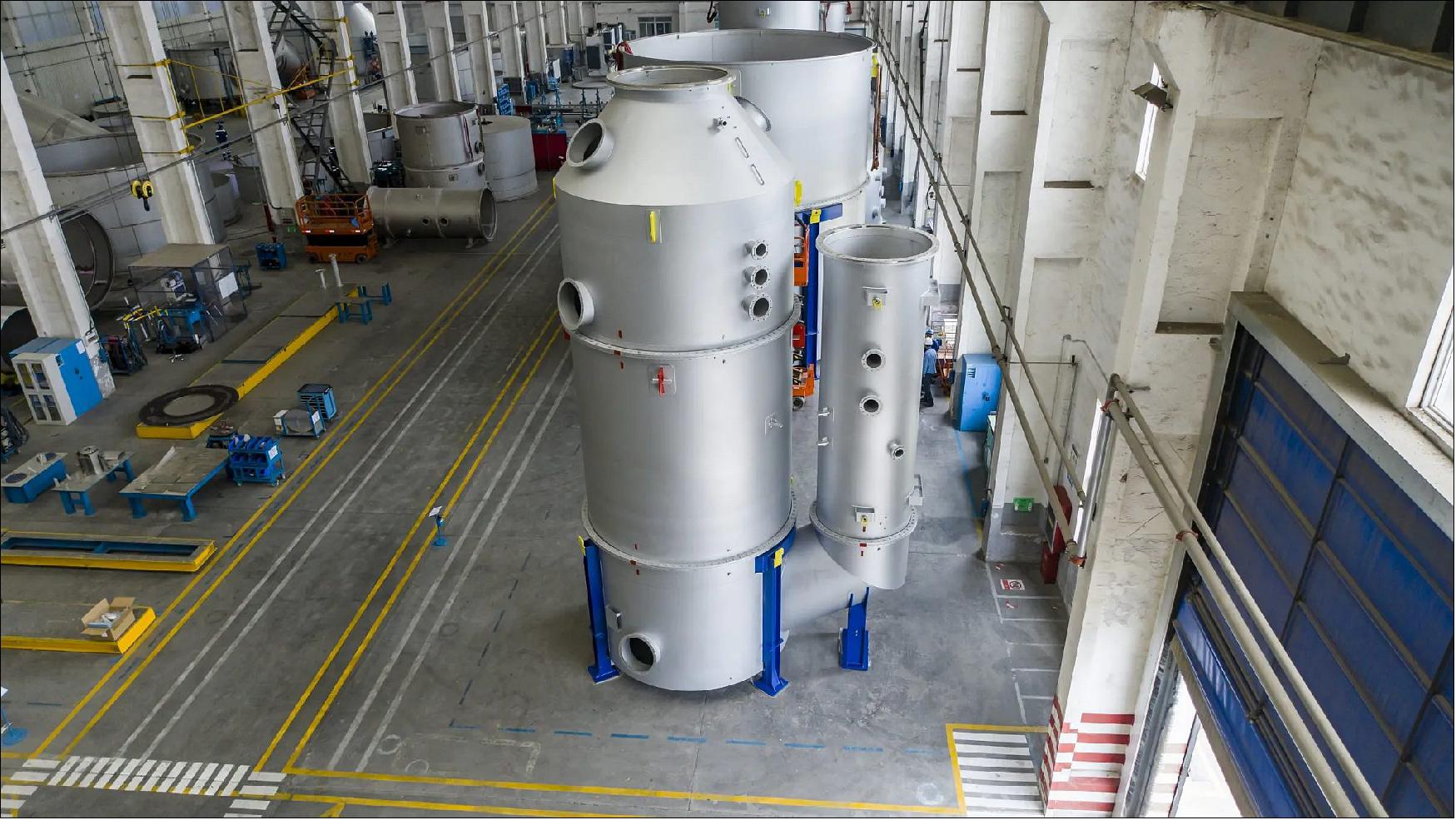
Fuel Savings
- Headquartered in Greece, Pleiades Shipping Agents S.A. transports crude oil and petroleum products, especially between North and South America, the Caribbean and the Far East. Today’s fleet comprises a mix of Panamax, Aframax and MR tankers, including two MR tankers with PureSOx scrubber systems on board. These two vessels were delivered in 2018, in time for the scrubbers to be thoroughly tested before the global sulphur cap entered into force in 2020.
- “Our decision to use scrubbers on newbuilds was based on techno-economic factors,” said Miltos Synefias, technical director at Pleiades. “Newbuilds have ample time to recoup the capital investment, and we based our evaluation on a conservative price differential of $100/MT between LSFO (Low Sulphur Fuel Oil) and HSHFO (High Sulfur Heavy Fuel Oil) over the service life of the vessel.”
Service Coverage Integral to Savings
- Economy figured into the company’s choice of scrubbers generally, but also into the specific choice of PureSOx. Synefias lists the initial purchase price, installation cost and fit-for-purpose materials among the PureSOx advantages. Yet equal focus was placed on long-term economy, in the form of service access and technical support.
- “Alfa Laval has been a pioneer in developing scrubbers for marine application,” Synefias noted. “Their cumulative service experience and continuous development were important factors in our decision. We knew we could expect worldwide service coverage and swift, to-the point replies when it comes to remote assistance and troubleshooting.”
Strong Cooperation With a Service Agreement
- Synefias describes the performance of the PureSOx systems since commissioning with two words: “Just perfect.” Nonetheless, Pleiades has chosen to sign an Alfa Laval Service Agreement for the systems, covering:
a) Regular Condition Audits
b) Annual service kits for preventive maintenance
c) Critical spares to ensure uninterrupted operation
d) Regular sensor exchange
e) PureSOx Connect digital services for remote monitoring and troubleshooting.
- “Scrubber technology is new to our company,” Synefias said of the decision. “As we move forward in operation, we would like to do it hand-in-hand with Alfa Laval, who can share expert experience and knowhow as we adjust our shipboard operational practices.”
Hassle-Free Calibration
- One of the services that has been easy to appreciate is the Exchange Program for PureSOx sensors. When the installed sensors are due for required calibration, Pleiades receives a three-week advance notice, followed by delivery of pre-calibrated replacement sensors that are installed by the crew or an attending service engineer.
- “We’ve had no difficulties at all with the delivery and installation process,” said Synefias. “The big advantage of the Exchange Program is having the sensors available when required, without the headache of enquiry, purchasing and storing sensors on board in advance. The service also comes with warranty coverage, in the event that a sensor should fail prematurely.”
Critical Communication
- Although the PureSOx systems are working smoothly, PureSOx Connect – the digital service package that lets crews, technical staff and Alfa Laval service experts collaborate remotely with secure access to PureSOx data, provides the shipping company with greater confidence.
- “The system is user-friendly, so our crews have quickly become familiar with PureSOx operation and troubleshooting, without extensive training needs,” Synefias said. “But we’ve seen that our crews are eager to exchange technical information, thanks to the efficient communication channel established between Alfa Laval, [Alfa Laval agent] Technava, our superintendent and the vessels’ chief engineers.”
Strengthening Relationships
- Going forward, Synefias sees the relationship with Alfa Laval becoming both deeper and broader. He notes that Alfa Laval provides many systems important to tanker operation, including boilers, inert gas systems, fuel treatment systems, ballast water treatment systems and Framo submerged cargo pumps.
- “Given the opportunity, our preference is to combine as many systems as possible under the same maker,” Synefias noted. “We’ve strategically elected to install Alfa Laval Aalborg boilers and Alfa Laval Smit inert gas systems, and along with PureSOx we’ve incorporated Framo systems and Alfa Laval fuel treatment and supply systems into our MR tankers.”
- Likewise, Synefias sees expanded potential for scrubbers on the horizon. “In the long term. We’d like to see our investment in scrubbers developing into CO2 capture to meet IMO 2030 targets. That’s something we’ve seen discussed in the press.”
• September 17, 2021: Navigator Gas has been awarded a new Approval in Principle (AiP) for an ammonia-fuelled gas carrier design from DNV. 157)
Note: DNV (formerly DNV GL) is an international accredited registrar and classification society headquartered in Høvik, Norway. The company currently has about 12,000 employees and 350 offices operating in more than 100 countries, and provides services for several industries including maritime, oil & gas, renewable energy, electrification, food & beverage and healthcare. DNV GL was created in 2013 as a result of a merger between two leading organizations in the field — Det Norske Veritas (Norway) and Germanischer Lloyd (Germany). In 2021, DNV GL changed its name to DNV, while retaining its post-merger structure.
- An industry-wide consortium, including MAN Energy solutions, Babcock International, and the Norwegian Maritime Authority (NMA), has collaborated with Navigator Gas to achieve the Approval in Principle (AiP) from DNV.
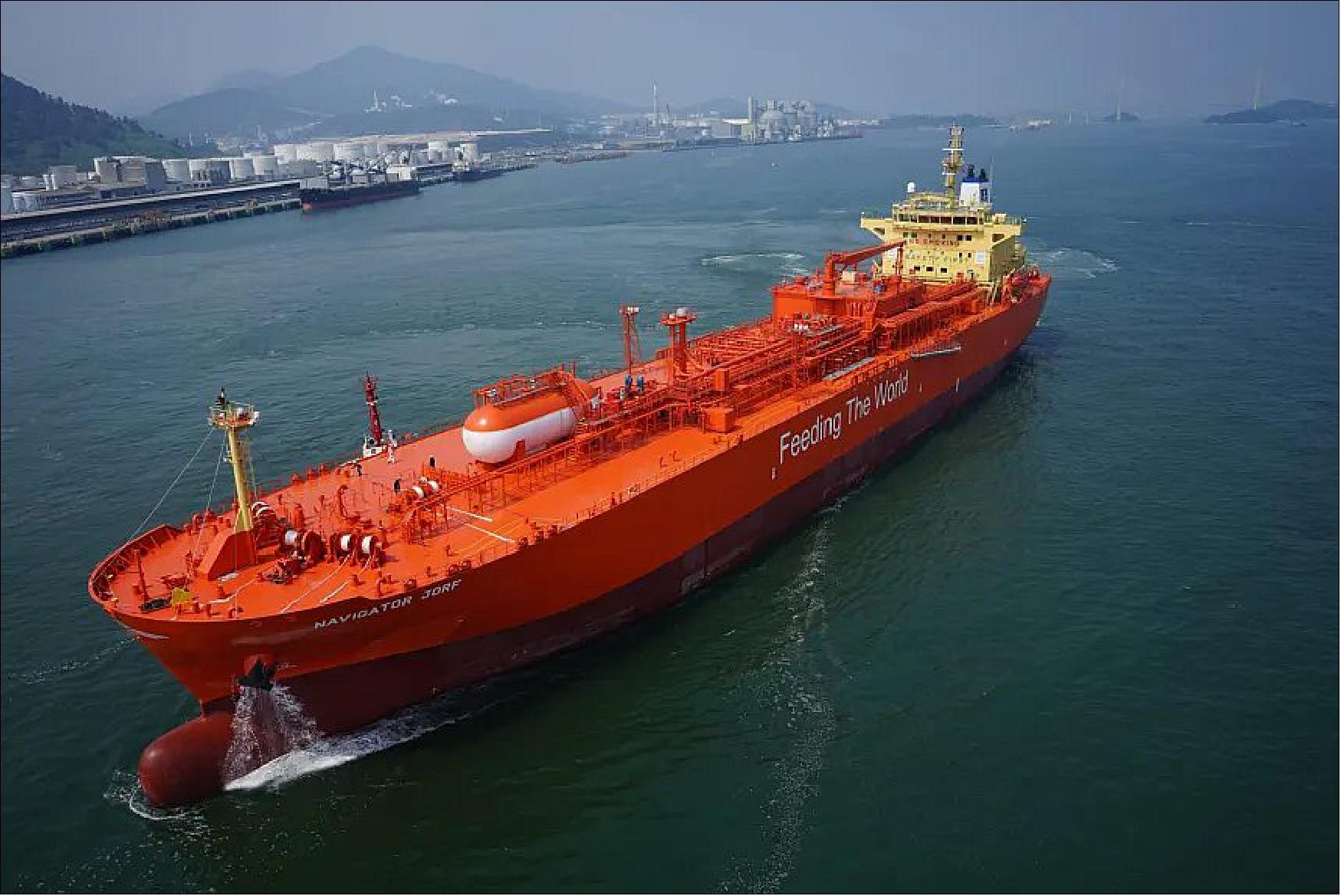
- The new gas carrier design has been awarded the AiP based on the special features notation (GF NH3) under DNV’s new rules for the use of ammonia as fuel in gas carriers. DNV, alongside the NMA (Norwegian Maritime Authority), reviewed the design and relevant documentation and found no potential showstoppers to its realisation.
- “Navigator Gas has been discussing Ammonia as a fuel with our consortium partners since 2018, when this topic was on the fringes of discussions surrounding decarbonization and the use of alternative fuels,” said Paul Flaherty, technical advisor to Navigator Gas. “Those early discussions on feasibility led to the completion of a comprehensive HAZID (Hazard Identification) in early 2019, which remains as valid today as it was then. This has also been used as the base safety case during our AiP discussions with DNV. Since our discussions began, we have witnessed an exponential increase in the number of projects around the globe looking at Hydrogen and Ammonia as carbon free source of energy. We have also been engaging with our customers and business partners to discuss their carbon free shipping requirements for transporting Blue/Green Ammonia to their customers.”
- “Obtaining an AiP from DNV for an Ammonia fuelled vessel is the first step in preparing Navigator Gas to meet the future demands of our customers and to reduce our carbon footprint through lower greenhouse gas emissions. In the longer term, using Ammonia as fuel is one of Alternative Fuels options we are pursuing, along with CCS, Carbon Offsetting and improved Vessel Optimization to reduce our carbon footprint and lower greenhouse gas emissions. I would like to thank DNV, MAN Energy Solutions, Babcock International and the Norwegian Maritime Authority, for their unwavering support and input during the AiP process,” said Flaherty.
• September 16, 2021: Predictive intelligence company Windward has launched the Data for Decarbonization program (D4D), a partnership aimed to increase transparency and foster collaboration within the maritime industry by leveraging the power of big data and artificial intelligence (AI). 158)
- The program aims to create large datasets gathered from all stakeholders in the maritime trade industry to build AI models that will accurately predict the carbon emissions of any vessel voyage, and optimize the whole pre-fixture process – including vessel selection, contract clauses, and supply chain scheduling. Current solutions are based on static and historical data, primarily on vessel specifications, and lack the high level of accuracy needed in this space. Often they do not consider variables such as weather, a vessel’s operational profile, ballast/laden status, the ballast leg, and hull fouling.
- The program will ignite participation across the maritime ecosystem including financial institutions, shipowners, insurers, charterers, and energy companies. Existing members include ADNOC Logistics & Services, ASM Maritime, Executive Ship Management (ESM), SOKANA Shipping, and Interunity.
- The Data for Decarbonization Program is expected to not only see the creation of a solution, but to bring value to members by accelerating the learning curve of understanding their own data, enabling them to better optimize their own assets. The program also benefits the industry at large by fostering interdisciplinary collaboration between data scientists, bankers, shippers, IT specialists, commercial teams, and ESG teams.
- The program aims to help shipowners to cut fuel costs by optimizing vessel operations without depending on the coverage of expensive IoT devices and hardware, and will allow them to compare their fleet to others. Charterers will be able to optimize their pre-fixture vessel selection by choosing the optimal performing vessel, optimizing the ballast leg, and during the post-fixture phase adapting a smart ETA and laden speed to real operating conditions.
- Freight forwarders and beneficial cargo owners will be able to measure carbon shipping performance for every container, accounting for the particular vessel and projected route of every shipment thus offering end customers a “green premium” option of low carbon shipping. Trade financiers will be able to independently verify the environmental impact of financing decisions thus exercising sustainable trade financing.
- “The answer to reducing carbon emissions lies in the Power of Many. Regulation is necessary, but the solution needs to come from within to ensure that the global supply chain continues to function and garners the trust of the general public” said Ami Daniel, CEO & co-founder of Windward. “The maritime shipping industry is headed to decarbonization. Those that invest in sharing data and insights now will benefit from the advantages of an accurate model trained specifically for the industry’s unique operations. Together we can realize a solution that will allow all stakeholders to analyze, predict, and price their carbon footprint, improve their bottom line, and accomplish a carbon-free future.”
• September 10, 2021: Drawing views from leaders across the supply chain, a report from maritime professional services organization Lloyd’s Register, titled “How To Make Shipping’s ‘Decade of Action’ a Reality” says the transition to zero-carbon shipping will be among the most significant in the sector’s history, with investments made today preventing future supply chain interruptions and minimizing disruption to the backbone of world trade. 159)
![Figure 146: It’s time for the maritime industry to deliver decarbonization. Not only that, but the pace of change needs to accelerate. Leaders from across the global supply chain are calling for immediate action on maritime decarbonization if a successful energy transition to zero-carbon supply chains is to be achieved [image credit: VPO (Vessel Performance Optimization)]](https://www.eoportal.org/ftp/satellite-missions/s/Shipping_180722/Shipping_Auto4.jpeg)
Currently, around 80 % of goods transported worldwide rely on shipping and the maritime sector accounts for almost 3 percent of global greenhouse gas (GHG) emissions. However, despite widespread commitment to addressing the decarbonization of the sector, a lack of regulatory certainty and support from policymakers could see a rushed and uncoordinated transition, potentially leading to significant supply chain disruption.
Nick Brown, chief executive, Lloyd’s Register, said: “Our industry is no longer asking ‘if’ or ‘when’ decarbonization should take place. We know we must act now and many of us are. The question that remains is ‘how’ will the maritime industry deliver meaningful change during this crucial decade of action.
“This report brings together expert views and insights from the public and private sector on what the global maritime industry needs to do to make this decade of change a reality. The challenge is immense, but the commitment is real, from many organisations and governments. Everyone involved in the maritime supply chain must play their part.”
The Lloyd’s Register study, produced in association with Longitude, the research unit of the Financial Times, found consensus among maritime experts that shipping companies, their customers, and governments, need to work together on global solutions before the urgency of the climate crisis forces the sector into disruptive and fragmented changes. Contributors to the report called for greater global regulation of shipping to head off the emergence of inconsistent national policies.
Jim Barry, chief investment officer, BlackRock Alternatives Investors, commented: “The natural instinct of any industry will be to look to defer regulation, ‘How long can I drag it out?’ That’s the wrong instinct today and it’s not going to work this time because the climate is changing. There’s no ambiguity on that. The cost of this transition will be less the sooner you get your head around the future roadmap and the sooner you begin the adjustment.”
Contributors to the study also urged public and private sectors to work in unison to drive funding into the most promising emerging technologies and to support smaller businesses unable to decarbonize on their own. In addition, they emphasized the importance of infrastructure – such as alternative shipping fuels being available in ports – to ensure the ships of the future can deliver goods on a truly global basis.
Katharine Palmer, shipping lead, UNFCCC (United Nations Framework Convention on Climate Change) stated: “The pace of change required needs to be ramped up. This is a climate crisis which requires an urgent response. The momentum is building, commitments are being made, the understanding of the transformation needed across the maritime system is there. We now need everyone to mobilize and convert understanding, awareness and commitment into action.”
There was consensus among maritime experts that the next decade presents a fundamental challenge to the future of shipping. With consumers, investors, and governments increasingly demanding zero-carbon solutions from the private sector, contributors to the report highlighted the risk of stranded assets, financial loss, and regulatory complexity if the maritime sector fails to proactively address the climate crisis. However, they also noted that shifting to zero-carbon shipping would deliver competitive benefits at a relatively low cost that can be comfortably absorbed across the supply chain.
Lindsay Zing, senior director of sustainability, freight forwarder DSV Panalpina, noted: “If you cannot offer a ‘green’ product, you will lose business – it is an absolute requirement. Our customers are constantly asking what we can do to lower CO2, and we will launch our green logistics program later this year. Customers push us, we push our suppliers, and we will make a difference.”
• September 10, 2021: The first of an order of four of the largest VLECs (Very Large Ethane Carriers) ever commissioned, the 99,000 cbm dual-fuel vessel is designed for long haul ethane transportation but can also handle other liquified gas cargoes such as LPG (Liquified Petroleum Gas) and ethylene. 160)
As a tradition, Jiangnan always gives a nickname to a newly developed ship. Jiangnan has assigned this novel VLEC as “Bluebonnet,” the state flower of Texas, the home state of ABS’ world headquarters. This reflects the engagement between engineers at Jiangnan and ABS, initially during the conceptual stage, which resulted in ABS granting Approval in Principle in September 2019, with subsequent design approval and construction supervision.
“Launch of this vessel is a key milestone in the development of the industry. It’s significant not simply because of its scale but in the flexibility, it offers operators to adapt to an evolving global marketplace. As the world’s leading Class for gas carriers, we are proud to have been able to use our extensive experience to support delivery of this project,” said Sean Bond, ABS director, global gas development.
“It is a giant step forward from a dream to reality. The first VLEC launching is not only a significant milestone in construction but also a landmark to prove the technical feasibility of our own-developed ‘BrilliancE’ Type B containment system. We sincerely thank the great support from both the shipowner and ABS. I believe that Jiangnan has built-up the confidence to confidently manage the construction of subsequent Type B tanks, and this accumulated know-how can also be transferred to forthcoming LNG Type B tanks,” said Keyi Hu, chief of corporate technology, Jiangnan Shipyard (Group).
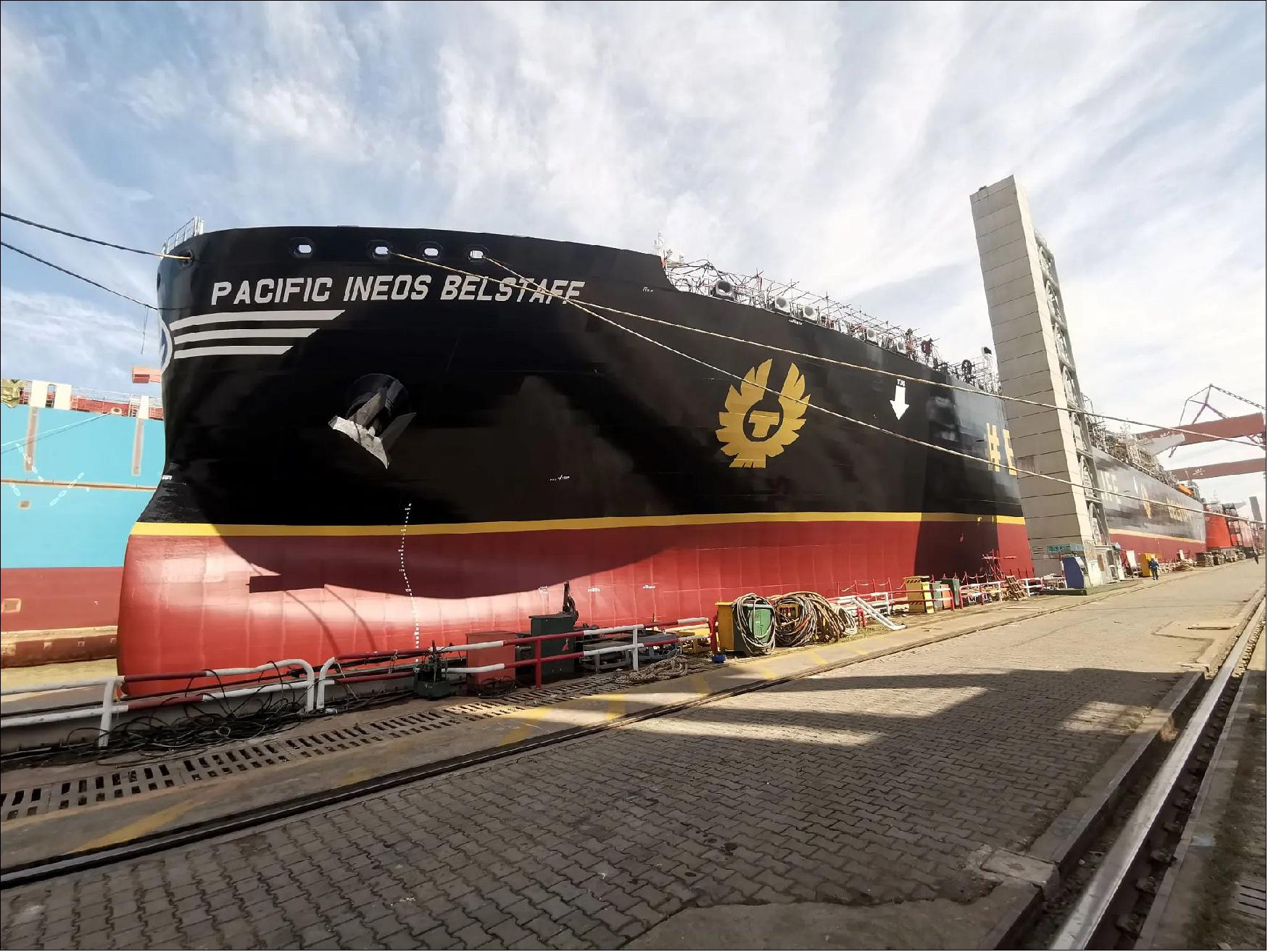
• September 8, 2021: ABB has responded to rising demand for low and zero emissions from ships by developing a containerized energy storage system (ESS) – a complete, plug-in solution to install sustainable marine energy storage at scale. 161)
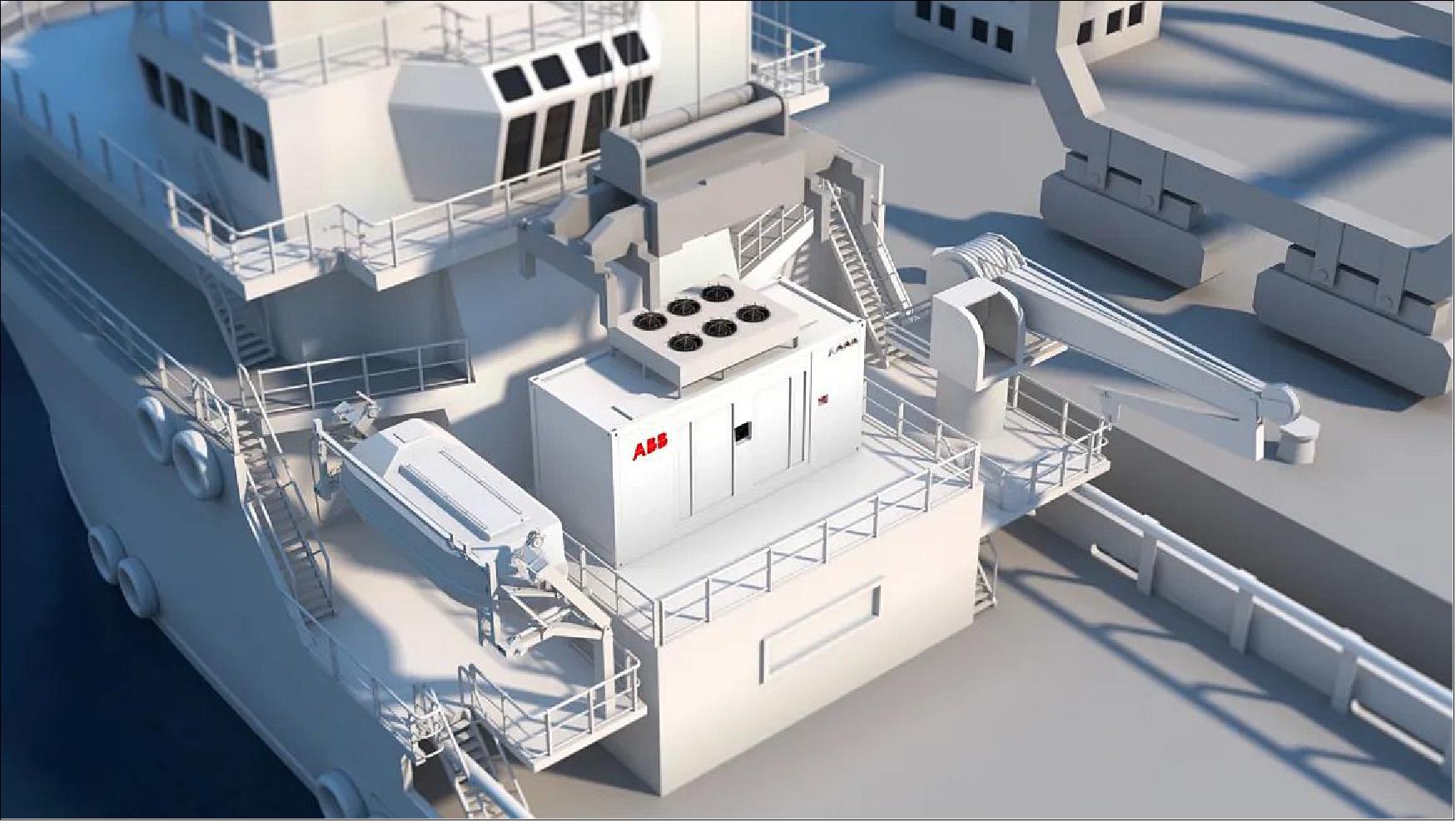
The containerized ESS is housed in a 20 ft high-cube ISO container and ready to integrate with the vessel’s main power distribution system. The ESS brings new simplicity to energy storage retrofitting, with all batteries, converters, transformer, controls, cooling and auxiliary equipment pre-assembled in the self-contained unit for ‘plug and play’ use.
“Fuel savings, lower emissions and increased safety during operation and maintenance are the demand drivers for energy storage systems in the newbuild ship market, where ABB has extensive experience. With containerized ESS, we are delighted to be able to offer these benefits to owners of existing ships with a one-stop retrofit solution,” said Jyri Jusslin, head of service, ABB Marine & Ports.
The containerized ESS solution is suitable for integration on board a wide variety of ships. Offshore support vessels, for instance, would particularly benefit from a self-contained solution, as the electrical room space on board is especially limited. Flexible and cost-effective energy storage system technology would also be relevant to container ships, ferries, drill ships and other vessel types.
“The containerized ESS expands integration options across multiple types of ships and delivers a solution that can be fully serviced from outside the unit for enhanced safety. Knowing that there is a simple way to integrate an energy storage system could be the extra encouragement needed for owners to consider incorporating batteries for vessel efficiency and, especially, for sustainable power,” said Jyri Jusslin.
The containerized ESS offers one of the highest energy densities in the market within a 20 ft container, offering a standardized installation, which adds up to lower costs and faster delivery.
The containerized ESS is a technically mature solution that answers to shipowners’ demand to retrofit vessel power distribution systems and add a battery of significant capacity. The pre-assembled and factory-tested equipment and cabling make the containerized ESS solution easy to integrate with all vessel subsystems. It is also supported by the ABB Ability Marine Remote Diagnostics System, which offers continuous monitoring for preventive maintenance and fast and easy system repair.
• July 13, 2021: 2021 marks a decade of action since IMO adopted the first set of mandatory energy efficiency measures for ships. 162)
The International Maritime Organization (IMO) is marking a decade of action on cutting greenhouse gas emissions from shipping, since the first set of international mandatory measures to improve ships' energy efficiency was adopted on 15 July 2011, as part of the International Convention for the Prevention of Pollution from Ships (MARPOL).
To support the implementation of the measures and encourage innovation, IMO has been implementing a comprehensive capacity building and technical assistance program, including a range of global projects. These include the GEF-UNP-IMO GloMEEP Project (now concluded), the European Union funded global network of maritime technology cooperation centers (GMN project), the IMO-Norway GreenVoyage2050 project and the IMO-Republic of Korea GHG SMART Project.
IMO Secretary-General Kitack Lim said, "In July 2011, the first set of mandatory measures to improve the energy efficiency of new build ships was adopted, fundamentally changing the baseline for the performance of the incoming global fleet in terms of emission reduction. The pace of regulatory work to address GHG emissions from shipping has continued within the framework of the IMO Initial Strategy for reducing GHG emissions from shipping, and most recently with the adoption of further, key short-term measures aimed at cutting the carbon intensity of all ships - new build and existing ships - by at least 40% by 2030, compared to the 2008 baseline, in line with the initial strategy ambitions."
"The package of mandatory measures combined with implementation support sets shipping on a pathway to decarbonization. There is more work to do, but we have solid foundations, which is contributing to the global fight against climate change" Mr. Lim said.
IMO has issued an infographic outlining key regulatory and implementation support steps. You can download a high resolution version of this infographic by clicking on it and then saving the file.
• April 29, 2021: A rapidly growing number of ships are being fitted with exhaust gas cleaning systems, or “scrubbers,” as a way to comply with the International Maritime Organization’s (IMO) 2020 global fuel sulfur limit. Scrubbers remove sulfur from ship exhaust by spraying a buffer solution, usually seawater, over it and then discharging the washwater overboard, often without treatment. The washwater is more acidic than the surrounding seawater and contains polycyclic aromatic hydrocarbons, particulate matter, nitrates, nitrites, and heavy metals including nickel, lead, copper, and mercury. Scrubber washwater is toxic to some marine organisms, harms others, and can worsen water quality. 163) 164)
This report is the first global assessment of the mass of washwater discharges expected from ships using scrubbers. The authors used 2019 ship traffic, as a pre-COVID-19 baseline, and considered approximately 3,600 ships that had scrubbers installed by the end of 2020. Results show that absent additional regulations, ships with scrubbers will emit at least 10 gigatons (Gt) of scrubber washwater each year. For context, the entire shipping sector carries about 11 Gt of cargo each year. Real-world discharges might be higher, as the authors used conservative estimates for washwater flow rates and the scrubber-equipped fleet now stands at more than 4,300 ships.
Approximately 80% of scrubber discharges occur within 200 nautical miles of shore, and there are hot spots in heavily trafficked regions, including the Baltic Sea, North Sea, Mediterranean Sea, the Strait of Malacca, and the Caribbean Sea. Scrubber discharges also occur in IMO-designated Particularly Sensitive Sea Areas (PSSAs), including the Great Barrier Reef, where about 32 million tons (Mt) of scrubber washwater is expected. But that represents only 5% of the 665 Mt expected to be discharged in PSSAs around the world. The Baltic Sea PSSA, for example, is projected to receive 295 Mt of discharges.
Although several governments have taken preventative measures and banned the use of scrubbers in their ports, internal waters, and territorial seas, many have not. Policymakers concerned about the impacts of washwater discharges can consider several actions: The IMO could immediately call on ships to voluntarily stop dumping scrubber washwater in PSSAs. The IMO could then prohibit the use of scrubbers as a means of compliance with fuel sulfur standards and require that ships use cleaner fuels at all times. Countries and ports could ban scrubber discharges in their waters, and flag states could agree to phase out the use of scrubbers on ships flying their flag.
Shipping traffic is not distributed evenly and understanding how much washwater is expected to be discharged and where could improve policymaking. The interactive map below is filled with details of the distribution of scrubber washwater discharges. It has six different layers, and after activating the layer(s) you want to explore, move your cursor to the location of interest and left click to get more information.
Fleet of scrubber-equipped ships (Ref. 164)
In 2019, we identified 81,297 active ships in the global fleet by matching AIS data with ship registry data based on each ship’s IMO number [165)]. We used the 2019 fleet as the baseline for this analysis because 2020 traffic patterns were disrupted by the coronavirus pandemic and do not reflect typical shipping traffic. Of the 81,297 ships in the fleet, we identified 3,628 that have or will have scrubbers installed by the end of 2020. This is lower than the roughly 4,300 ships that were fitted with scrubbers by the end of 2020 because, at the time of this analysis, Clarksons reported only 3,754 ships with scrubbers (we matched 3,628 to the AIS data set). Since this analysis, Clarksons has added additional ships with scrubbers to their database. Of the scrubbers installed on the 3,628 ships we could match with the AIS data, open-loop scrubbers are the most common type (85% of all scrubbers installed) and hybrids are second most popular (14%); only 1% of the scrubbers are closed loop. More than half of all scrubbers were installed in 2019 in preparation for the global marine fuel sulfur regulation that came into force at the beginning of 2020.
Bulk carriers, container ships, and oil tankers represent 74% of the fleet outfitted with scrubbers, by number of ships. Bulk carriers are the most common ship type outfitted with scrubbers—1,246 ships, or 34% of all outfitted ships. However, within each ship type, cruise ships have the largest share of their fleets outfitted with scrubbers: 34% of all cruise ships (Figure 1). Even though bulk carriers are the leaders by absolute numbers, only 10% of all bulk carriers have a scrubber installed. More information can be found in the supplemental data that accompanies this paper on the ICCT website.
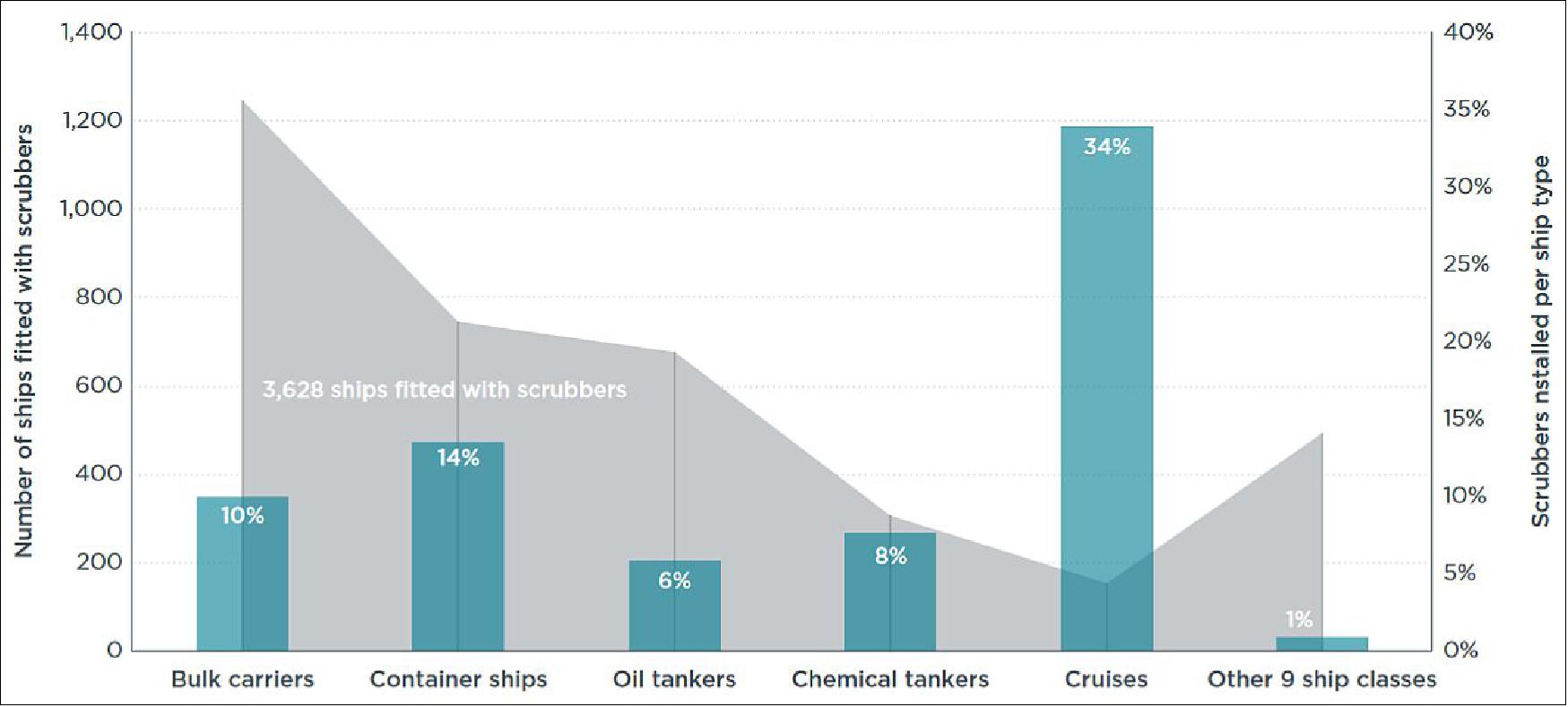
• April 13, 2018: IMO adopts an initial strategy on the reduction of greenhouse gas emissions from ships, with a vision which aims to phase them out, as soon as possible in this century. 166)
Nations meeting at the United Nations International Maritime Organization (IMO) in London have adopted an initial strategy on the reduction of greenhouse gas emissions from ships, setting out a vision to reduce GHG emissions from international shipping and phase them out, as soon as possible in this century.
The vision confirms IMO’s commitment to reducing GHG emissions from international shipping and, as a matter of urgency, to phasing them out as soon as possible.
More specifically, under the identified “levels of ambition”, the initial strategy envisages for the first time a reduction in total GHG emissions from international shipping which, it says, should peak as soon as possible and to reduce the total annual GHG emissions by at least 50% by 2050 compared to 2008, while, at the same time, pursuing efforts towards phasing them out entirely.
The strategy includes a specific reference to “a pathway of CO2 emissions reduction consistent with the Paris Agreement temperature goals”.
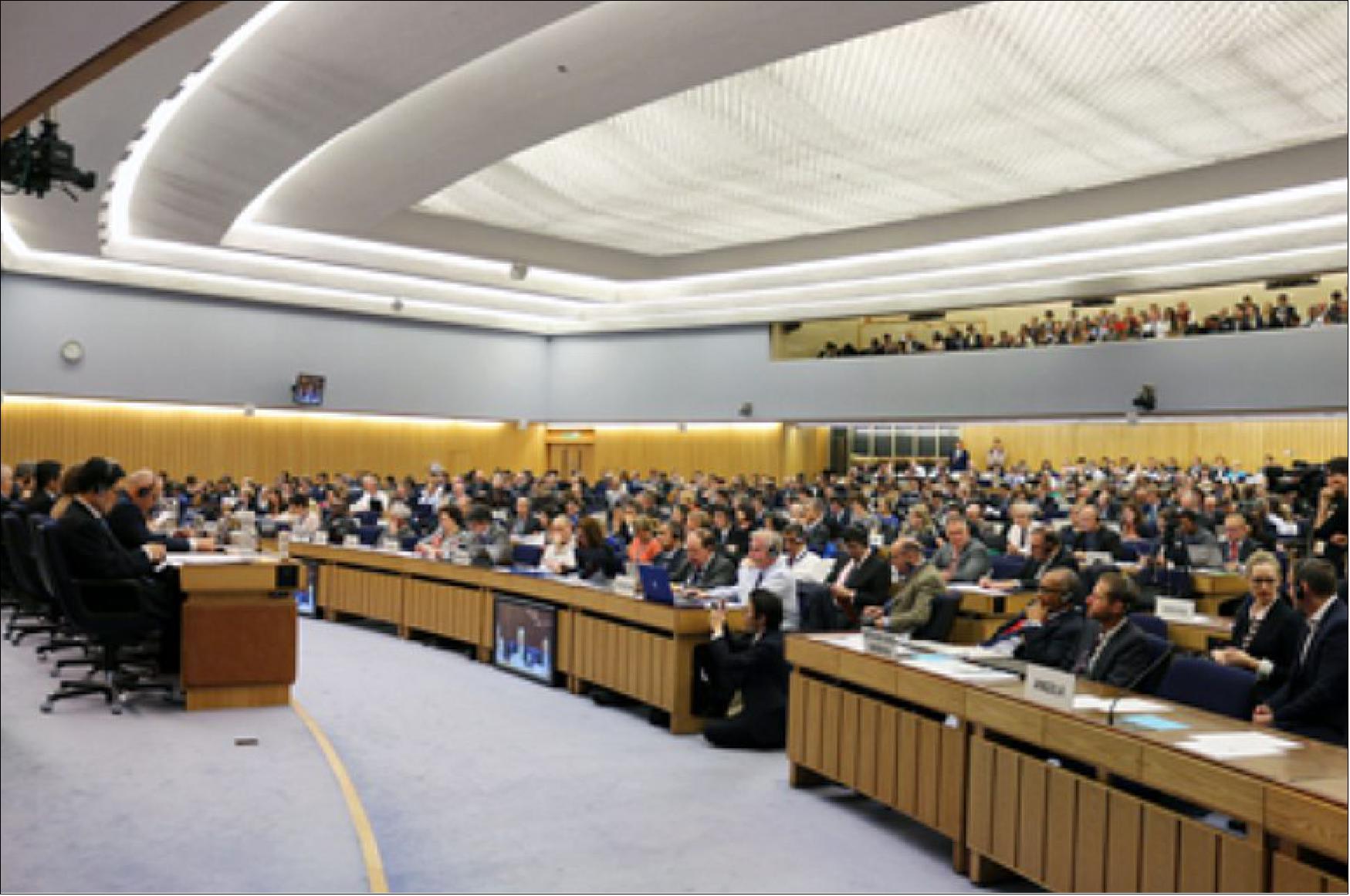
The initial strategy represents a framework for Member States, setting out the future vision for international shipping, the levels of ambition to reduce GHG emissions and guiding principles; and includes candidate short-, mid- and long-term further measures with possible timelines and their impacts on States. The strategy also identifies barriers and supportive measures including capacity building, technical cooperation and research and development (R&D).
IMO Secretary-General Kitack Lim said the adoption of the strategy was another successful illustration of the renowned IMO spirit of cooperation and would allow future IMO work on climate change to be rooted in a solid basis.
He told delegates, “I encourage you to continue your work through the newly adopted Initial GHG Strategy which is designed as a platform for future actions. I am confident in relying on your ability to relentlessly continue your efforts and develop further actions that will soon contribute to reducing GHG emissions from ships.”
According to the “Roadmap” approved by IMO Member States in 2016, the initial strategy is due to be revised by 2023.
Continuing the momentum of work on this issue, the Committee agreed to hold the fourth Intersessional meeting of the Working Group on Reduction of GHG emissions from ships later in the year. This working group will be tasked with developing a program of follow-up actions to the Initial Strategy; further considering how to progress reduction of GHG emissions from ships in order to advise the committee; and reporting to the next session of the MEPC (MEPC 73), which meets 22-26 October 2018.
IMO has already adopted global mandatory measures to address the reduction in GHG emissions from ships. IMO is also executing global technical cooperation projects to support the capacity of States, particularly developing States to implement and support energy efficiency in the shipping sector.
References
1) ”Reducing Greenhouse Gas Emissions from Ships,” ICCT (International Council on Clean Transportation), June 2011, URL: https://theicct.org/sites/default/files/publications/ICCT_GHGfromships_jun2011.pdf
2) ”United Nations Sustainable Development Goals,” IMO, URL: https://www.imo.org/en/MediaCentre/HotTopics/Pages/SustainableDevelopmentGoals.aspx
3) ”Reducing emissions from the shipping sector,” EC (European Commission), July 2021, URL: https://ec.europa.eu/clima/policies/transport/shipping_en
4) ”Marsoft and ClimeCo announce carbon credits collaboration,” VPO Global, 15 July 2022, URL: https://vpoglobal.com/2022/07/15/marsoft-and-climeco-announce-carbon-credits-collaboration/
5) ”XFuel lands €8.2m investment to accelerate roll-out of low carbon fuel technology,” VPO Global, 14 July 2022, URL: https://vpoglobal.com/2022/07/14/xfuel-lands-e8-2m-investment-to-accelerate-roll-out-of-low-carbon-fuel-technology/
6) ”WinGD and Chord X to bring CII insights to engine users,” VPO Global, 14 July 2022, URL: https://vpoglobal.com/2022/07/14/wingd-and-chord-x-to-bring-cii-insights-to-engine-users/
7) ”Berge Bulk vessels to be fitted with Anemoi Rotor Sails,” VPO Global, 13 July 2022, URL: https://vpoglobal.com/2022/07/13/berge-bulk-vessels-to-be-fitted-with-anemoi-rotor-sails/
8) ”Joint platform to tackle emissions by eliminating ‘Sail Fast, then Wait’ approach,” VPO Global, 8 July 2022, URL: https://vpoglobal.com/2022/07/08/joint-platform-to-tackle-emissions-by-eliminating-sail-fast-then-wait-approach/
9) ”MPCC orders two methanol-powered container newbuilds,” VPO Global, 8 July 2022, URL: [web source no longer available]
10) ”Proman Stena Bulk takes delivery of second methanol-fuelled tanker,” VPO Global, 5 July 2022, URL: https://vpoglobal.com/2022/07/05/proman-stena-bulk-takes-delivery-of-second-methanol-fuelled-tanker/
11) ”ESG-NRG integrates with Dataloy to offer clients carbon removal options,” VPO Global, 5 July 2022, URL: https://vpoglobal.com/2022/07/05/esg-nrg-integrates-with-dataloy-to-offer-clients-carbon-removal-options/
12) ”35% of major shipping companies striving for net zero by 2050 finds MMMCZCS report,” VPO Global, 1 July 2022, URL: https://vpoglobal.com/2022/07/01/only-35-of-major-shipping-companies-striving-for-net-zero-by-2050-finds-mmmczcs-report/
13) ”Eastern Pacific Shipping selects graphene-based coating to improve fuel efficiency,” VPO Global, 1 July 2022, URL: https://vpoglobal.com/2022/07/01/eastern-pacific-shipping-selects-graphene-based-coating-to-improve-fuel-efficiency/
14) ”Berge Bulk vessel to sail with WindWings in 2023,” VPO Global, 29 June 2022, URL: https://vpoglobal.com/2022/06/29/berge-bulk-vessel-to-sail-with-windwings-in-2023/
15) ”Armach Robotics introduces in-water hull cleaning,” VPO Global, 28 June 2022, URL: https://vpoglobal.com/2022/06/28/armach-robotics-introduces-in-water-hull-cleaning/
16) ”Ocean Infinity secures €15M for hydrogen-fulled container ships,” VPO Global, 24 June 2022, URL: https://vpoglobal.com/2022/06/24/samskip-and-ocean-infinity-secure-e15m-to-deliver-hydrogen-fulled-container-ships/
17) ”Mitsubishi bulker becomes first vessel retrofitted with BAR Tech’s WindWings,” VPO Global, 22 June 2022, URL: https://vpoglobal.com/2022/06/22/mitsubishi-bulker-becomes-first-vessel-retrofitted-with-bar-techs-windwings/
18) ”E-ferry sails 50nm on single battery charge,” VPO Global, 21 June 2022, URL: https://vpoglobal.com/2022/06/21/e-ferry-sails-50nm-on-single-battery-charge/
19) ”Proman Stena Bulk takes delivery of first methanol-powered newbuild,” VPO Global, 21 June 2022, URL: https://vpoglobal.com/2022/06/21/proman-stena-bulk-takes-delivery-of-first-methanol-powered-newbuild/
20) ”Anemoi rotor sails to cut Oldendorff bulk carrier EEDI by 29 percent,” VPO Global, 17 June 2022, URL: https://vpoglobal.com/2022/06/17/anemoi-rotor-sails-to-cut-oldendorff-bulk-carrier-eedi-by-29-per-cent/
21) ”Hydrogen at risk of being a missed opportunity, states new DNV report,” VPO Global, 14 June 2022, URL: https://vpoglobal.com/2022/06/14/hydrogen-at-risk-of-being-a-missed-opportunity-states-new-dnv-report/
22) ”Bureau Veritas and Danaos pilot CII REALTIME notation,” VPO Global, 13 June 2022, URL: https://vpoglobal.com/2022/06/13/bureau-veritas-and-danaos-pilot-cii-realtime-notation/
23) ”Yara Marine enables EEXI compliance for Donsötank tanker,” VPO Global, 13 June 2022, URL: https://vpoglobal.com/2022/06/13/yara-marine-enables-eexi-compliance-for-donsotank-tanker/
24) ”Sterntube-less ship concept could save shipowners thousands,” VPO Global, 10 June 2022, URL: [web source no longer available]
25) ZeroNorth secures over $50 million in Series B investment,” VPO Global, 10 June 2022, URL: [web source no longer available]
26) ”Accelleron and Hoppe Marine partner on data collection for vessel performance,” VPO Global, 10 June 2022, URL: https://vpoglobal.com/2022/06/10/accelleron-and-hoppe-marine-partner-to-improve-data-collection-for-vessel-performance-analytics/
27) ”Weathernews and Dataloy forge data integration partnership,” VPO Global, 10 June 2022, URL: [web source no longer available]
28) ”StormGeo unveils new CII simulator tool,” VPO Global, 1 June 2022, URL: https://vpoglobal.com/2022/06/01/stormgeo-unveils-new-cii-simulator-tool/
29) ”DNV grants preliminary approval to hydrogen-based energy system,” VPO Global, 1 June 2022, URL: https://vpoglobal.com/2022/06/01/dnv-grants-preliminary-approval-to-hydrogen-based-energy-system/
30) ”‘Digital Twin for Green Shipping’ project launches,” VPO Global, 1 June 2022, URL: https://vpoglobal.com/2022/06/01/digital-twin-for-green-shipping-project-launches/
31) ”Wärtsilä opens Sustainable Technology Hub to accelerate decarbonisation,” VPO Global, 1 June 2022, URL: https://vpoglobal.com/2022/06/01/wartsila-opens-sustainable-technology-hub-to-accelerate-decarbonisation/
32) ”New laker from CSL slashes emissions with Berg Propulsion technology,” VPO Global, 27 May 2022, URL: https://vpoglobal.com/2022/05/27/new-laker-from-csl-slashes-emissions-with-berg-propulsion-technology/
33) ”Furuno adds NAPA Voyage Optimisation to new voyage planning system,” VPO Global, 26 May 2022, URL: https://vpoglobal.com/2022/05/26/furuno-adds-napa-voyage-optimisation-to-new-voyage-planning-system/
34) ”Windship research highlights effect of rig design on EEXI,” VPO Global, 25 May 2022, URL: https://vpoglobal.com/2022/05/25/windship-research-highlights-effect-of-rig-design-on-eexi/
35) ”K LINE unveils designs for LNG-fuelled and battery-powered bulk carriers,” VPO Global, 20 May 2022, URL: https://vpoglobal.com/2022/05/20/k-line-unveils-designs-for-lng-fuelled-and-battery-powered-bulk-carriers/
36) ”Neoline to equip latest cargo ship with solid sail solution,” VPO Global, 20 May 2022, URL: https://vpoglobal.com/2022/05/20/neoline-to-equip-latest-cargo-ship-with-solid-sail-solution/
37) ”Danelec wins order to upgrade 100+ vessels with performance monitoring tool,” VPO Global 19 May 2022: URL: https://vpoglobal.com/2022/05/19/danelec-wins-order-to-upgrade-100-vessels-with-performance-monitoring-tool/
38) ”Voyager Worldwide adds vessel tracking and alerts to Fleet Insight service,” VPO Global, 18 May 2022, URL: https://vpoglobal.com/2022/05/18/voyager-worldwide-adds-vessel-tracking-and-alerts-to-fleet-insight-service/
39) ”Armach Robotics launches Hull Service Robot,” VPO Global, 17 May 2022, URL: https://vpoglobal.com/2022/05/17/armach-robotics-launches-hull-service-robot/
40) ”Pacific Basin, Nihon, and Mitsui team up to develop zero-emission vessels,” VPO Global, 14 May 2022, URL: https://vpoglobal.com/2022/05/14/pacific-basin-nihon-and-mitsui-team-up-to-develop-zero-emission-vessels/
41) ”Start-up zero44 to help shipping companies manage CO2 emissions,” VPO Global, 14 May 2022, URL: https://vpoglobal.com/2022/05/14/start-up-zero44-to-help-shipping-companies-manage-co2-emissions/
42) ”EyeGauge wins Yara Marine’s decarbonisation accelerator programme,” VPO Global, 14 May 2022, URL: https://vpoglobal.com/2022/05/14/eyegauge-wins-yara-marines-decarbonisation-accelerator-programme/
43) ”Joining forces to tackle biofouling,” VPO Global, 10 May 2022, URL: https://vpoglobal.com/2022/05/10/joining-forces-to-tackle-biofouling/
44) ”New report from MTF outlines pathways to using ammonia as a marine fuel,” VPO global, 6 May 2022, URL: https://vpoglobal.com/2022/05/06/new-report-from-mtf-outlines-pathways-to-using-ammonia-as-a-marine-fuel/
45) ”Global Centre for Maritime Decarbonisation welcomes three new partners,” VPO Global, 6 May 2022, URL: https://vpoglobal.com/2022/05/06/global-centre-for-maritime-decarbonisation-welcomes-three-new-partners/
46) ”HAV receives preliminary approval for hydrogen-based energy system,” VPO Global, 6 May 2022, URL: https://vpoglobal.com/2022/05/06/hav-receives-preliminary-approval-for-hydrogen-based-energy-system/
47) ”Eastaway chooses Wärtsilä solutions for EEXI compliance,” VPO Global, 5 May 2022, URL: [web source no longer available]
48) ”Start-up to bring IoT emissions monitoring tool to the maritime industry,” VPO Global, 29 April 2022, URL: https://vpoglobal.com/2022/04/29/start-up-secures-shippings-support-to-bring-iot-emissions-monitoring-tool-to-the-maritime-industry/
49) ”Zero-emission design concept for Handymax bulker unveiled,” VPO Global, 29 April 2022, URL: https://vpoglobal.com/2022/04/29/zero-emission-design-concept-for-handymax-bulker-unveiled/
50) ”BV, Vinssen and NTU Singapore to develop hydrogen fuelled vessels,” VPO Global, 27 April 2022, URL: https://vpoglobal.com/2022/04/27/bv-vinssen-and-ntu-singapore-to-develop-hydrogen-fuelled-vessels/
51) ”Emerging ammonia bunkering network set to fuel carbon-neutral ambitions,” VPO Global, 27 April 2022, URL: https://vpoglobal.com/2022/04/27/emerging-ammonia-bunkering-network-set-to-fuel-carbon-neutral-ambitions/
52) ”Wärtsilä invests in Marindows to spur maritime decarbonisation in Japan,” VPO Global, 20 April 2022, URL: https://vpoglobal.com/2022/04/20/wartsila-invests-in-marindows-to-spur-maritime-decarbonisation-in-japan/
53) ”MMHE partners with Silverstream to expand roll out of air lubrication technology,” VPO Global, 20 April 2022, URL: https://vpoglobal.com/2022/04/20/mmhe-partners-with-silverstream-to-expand-roll-out-of-air-lubrication-technology/
54) ”BSM adds new tool to monitoring platform to improve ship performance transparency,” VPO Global, 20 April 2022, URL: https://vpoglobal.com/2022/04/20/bsm-adds-new-tool-to-monitoring-platform-to-improve-ship-performance-transparency/
55) ”ClassNK releases GHG emissions management tool,” VPO Global, 19 April 2022, URL: https://vpoglobal.com/2022/04/19/classnk-releases-ghg-emissions-management-tool/
56) ”Inmarsat and Thetius explore impact of digital tech on shipping’s decarbonisation,” VPO Global, 8 April 2022, URL: https://vpoglobal.com/2022/04/08/inmarsat-and-thetius-explore-impact-of-digital-tech-on-shippings-decarbonisation/
57) ”Maintenance & Continuous Improvement,” VPO Global, 7 April 2022, URL: https://vpoglobal.com/2022/04/07/bv-launches-digital-tool-for-machinery-maintenance/
58) ”Container ship slashes emissions by 27 percent through synthetic fuel,” VPO Global, 7 April 2022, URL: https://vpoglobal.com/2022/04/07/container-ship-slashes-emissions-by-27-per-cent-through-synthetic-fuel/
59) ”Ballard secures DNV type approval for marine fuel cell module,” VPO Global, 6 April 2022, URL: https://vpoglobal.com/2022/04/06/ballard-secures-dnv-type-approval-for-marine-fuel-cell-module/
60) ”IMO makes progress on lifecycle GHG emissions guidelines,” VPO Global, 25 March 2022, URL: https://vpoglobal.com/2022/03/25/imo-makes-progress-on-lifecycle-ghg-emissions-guidelines/
61) ”Euronav and Theyr collaborate to optimise voyages,” VPO Global, 23 March 2022, URL: https://vpoglobal.com/2022/03/23/euronav-and-theyr-collaborate-to-optimise-voyages/
62) ”Caterpillar Marine expands hybrid and electric capabilities,” VPO Global, 23 March 2022, URL: https://vpoglobal.com/2022/03/23/caterpillar-marine-expands-hybrid-and-electric-capabilities/
63) ”Digital suite from ABB Turbocharging to help ships slash fuel consumption by 20%,” VPO Global, 22 March 2022, URL: https://vpoglobal.com/2022/03/22/digital-suite-from-abb-turbocharging-to-help-ships-slash-fuel-consumption-by-20-per-cent/
64) ”Greensea launches new robotic hull cleaning solution,” VPO Global, 10 March 2022, URL: https://vpoglobal.com/2022/03/10/greensea-launches-new-robotic-hull-cleaning-solution/
65) ”ZeroNorth claims big CO2 emissions savings for ships,” Environment, Shipping, 10 March 2022, URL: https://www.marinelog.com/legal-safety/environment/zeronorth-claims-big-co2-emissions-savings-for-ships/
66) ”Chris-Marine launches shaft power limitation solution for EEXI compliance,” VPO Global, 10 March 2022, URL: https://vpoglobal.com/2022/03/10/chris-marine-launches-shaft-power-limitation-solution-for-eexi-compliance/
67) ”Pacific International chooses ammonia-ready engines for newbuild containerships,” VPO Global, 10 March 2022, URL: [web source no longer available]
68) ”Shift and SeaTech to design & develop Singapore’s first hybrid electric bunker tankers,” VPO Global, 10 March 2022, URL: https://vpoglobal.com/2022/03/10/shift-clean-energy-and-seatech-to-design-and-develop-singapores-first-hybrid-electric-bunker-tankers/
69) ”Scandlines ferry to sail emission-free with NES battery solution,” VPO Global, 27 February 2022, URL: https://vpoglobal.com/2022/02/27/scandlines-ferry-to-sail-emission-free-with-nes-battery-solution/
70) ”ABB and Ballard secure DNV AiP for fuel cell concept,” VPO Global, 25 February 2022, URL: https://vpoglobal.com/2022/02/25/abb-and-ballard-secure-dnv-aip-for-fuel-cell-concept/
71) ”Shell commits to KONGSBERG’s energy saving software,” VPO Global, 23 February 2022, URL: https://vpoglobal.com/2022/02/23/shell-commits-to-kongsbergs-energy-saving-software/
72) ”StormGeo launches carbon intensity indicator tool for ships,” VPO Global, 23 February 2022, URL: [web source no longer available]
73) ”RINA grants AiP to hydrogen-fuelled MR tanker,” VPO Global, 22 February 2022, URL: https://vpoglobal.com/2022/02/22/rina-grants-aip-to-hydrogen-fuelled-mr-tanker/
74) ”Resistance to change preventing shipping’s move to zero pollution, finds survey,” VPO Global, 19 February 2022, URL: https://vpoglobal.com/2022/02/19/resistance-to-change-preventing-shippings-move-to-zero-pollution-finds-survey/
75) ”Valmet cuts exhaust gas emissions by 99 percent in technology pilot,” VPO Global, 19 February 2022, URL: https://vpoglobal.com/2022/02/19/valmet-cuts-exhaust-gas-emissions-by-99-per-cent-in-technology-pilot/
76) ”BargeTracker launched to boost bunker transparency,” VPO Global, 16 February 2022, URL: https://vpoglobal.com/2022/02/16/bargetracker-launched-to-boost-bunker-transparency/
77) ”AI-based solution from FuelTrust to assess vessels’ historical GHG performance,” VPO Global, 15 February 2022, URL: https://vpoglobal.com/2022/02/15/ai-based-solution-from-fueltrust-to-assess-vessels-historical-ghg-performance/
78) ”UK Chamber of Shipping calls on IMO to take more action to cut emissions,” VPO Global, 14 February 2022, URL: https://vpoglobal.com/2022/02/14/uk-chamber-of-shipping-calls-on-imo-to-take-more-action-to-cut-emissions/
79) ”Maintaining a shipshape hull with a Shipshave robot,” VPO Global, 10 February, 2022, URL: https://vpoglobal.com/2022/02/10/maintaining-a-shipshape-hull/
80) ”New report outlines pathways for shipping to achieve decarbonisation goals,” VPO Global, 10 February 2022, URL: https://vpoglobal.com/2022/02/10/new-report-outlines-pathways-for-shipping-to-achieve-decarbonisation-goals/
81) ”VesselsValue adds energy efficiency rating to data offering,” VPO Global, 10 February 2022, URL: https://vpoglobal.com/2022/02/10/vesselsvalue-adds-energy-efficiency-rating-to-data-offering/
82) ”Canadian ferry operator signs more vessels to Wärtsilä’s optimised maintenance,” VPO Global, 8 February 2022, URL: https://vpoglobal.com/2022/02/08/canadian-ferry-operator-adds-two-more-vessels-to-optimised-maintenance-agreement-with-wartsila/
83) ”UK to explore shore power to boost green shipping opportunities,” VPO Global, 7 February 2022, URL: https://vpoglobal.com/2022/02/07/uk-to-explore-shore-power-to-boost-green-shipping-opportunities/
84) ”NYK and PowerX to develop electric vessels,” VPO Global, 4 February 2022, URL: https://vpoglobal.com/2022/02/04/nyk-and-powerx-to-develop-electric-vessels/
85) ”Vessel coated with Selektope-containing antifouling barnacle-free after 5 years,” VPO Global, 4 February 2022, URL: https://vpoglobal.com/2022/02/04/vessel-coated-with-selektope-containing-antifouling-barnacle-free-after-5-years/
86) ”OneOcean expands environmental offering with LogCentral,” VPO Global, 4 February 2022: URL: https://vpoglobal.com/2022/02/04/oneocean-expands-environmental-offering-with-logcentral/
87) ”Wind power continues to gain ground as IMO grants IWSA consultative status,” VPO Global, 1 February 2022, URL: https://vpoglobal.com/2022/02/01/wind-power-continues-to-gain-ground-as-imo-grants-iwsa-consultative-status/
88) ”KR awards AiP for Korea’s first onboard carbon capture & storage system,” VPO Global, 3 February 2022, URL: https://vpoglobal.com/2022/02/03/kr-awards-aip-for-koreas-first-onboard-carbon-capture-storage-system/
89) ”Nautilus Labs adds AI-based route planning to voyage optimisation tool,” VPO Global, 28 January 2022, URL: https://vpoglobal.com/2022/01/28/nautilus-labs-adds-ai-based-route-planning-to-voyage-optimisation-tool/
90) ”Signol secures investment from TechPier for employee engagement tool,” VPO Global, 28 January 2022, URL: https://vpoglobal.com/2022/01/28/signol-secures-investment-from-techpier-for-employee-engagement-tool/
91) ”COACH and Veson Nautical integrate products to enhance voyage optimisation,” VPO Global, 27 January 2022, URL: https://vpoglobal.com/2022/01/27/coach-and-veson-nautical-integrate-products-to-enhance-voyage-optimisation/
92) ”AtoB@C Shipping chooses Høglund automation systems for newbuild bulkers,”
93) ”KVH adds wireless connectivity solution from ScanReach to Cloud Connect,” VPO Global, 25 January 2022, URL: https://vpoglobal.com/2022/01/25/kvh-adds-wireless-connectivity-solution-from-scanreach-to-cloud-connect/
94) ”Policy measures needed to make zero-emission shipping commercially viable,” VPO Global, 18 January 2022, URL: [web source no longer available]
95) ”METIS adds new tools to platform to enhance decarbonisation and compliance,” VPO Global, 18 January 2022, URL: https://vpoglobal.com/2022/01/18/metis-adds-new-tools-to-platform-to-enhance-decarbonisation-and-compliance/
96) ”NAPA and BV to transform hull design process to include 3D models,” VPO Global, 18 January 2022, URL: https://vpoglobal.com/2022/01/18/napa-and-bv-to-transform-hull-design-process-to-include-3d-models/
97) ”Maersk aims for net zero emissions by 2040,” VPO Global, 15 January 2022, URL: https://vpoglobal.com/2022/01/15/maersk-aims-for-net-zero-emissions-by-2040/
98) OneOcean adds environmental planner to voyage planning platform,” VPO Global, 13 January 2022, URL: https://vpoglobal.com/2022/01/13/oneocean-adds-environmental-planner-to-voyage-planning-platform/
99) ”ZeroNorth acquires bunker market platform ClearLynx,” VPO Global, 11 January 2022, URL: [web source no longer available]
100) ”Nakilat partners with ABS to develop decarbonisation strategy,” VPO Global, 11 January 2022, URL: https://vpoglobal.com/2022/01/11/nakilat-partners-with-abs-to-develop-decarbonisation-strategy/
101) ”Oldendorff joins biofuel trial with Australia’s CBH Group,” VPO Global, 10 January 2022, URL: https://vpoglobal.com/2022/01/10/oldendorff-joins-biofuel-trial-with-australias-cbh-group/
102) ”Norwegian port to install shore power facility,” VPO Global, Propulsion and Future Fuels, 7 January 2022, URL: https://vpoglobal.com/2022/01/07/norwegian-port-to-install-shore-power-facility/
103) ”Datum examines the value of digital twins & high sample rate torque data,” VPO Global, 6 January, 2022, URL: https://web.archive.org/web/20220128092443/https://vpoglobal.com/2022/01/06/datum-examines-the-value-of-digital-twins-high-sample-rate-torque-data/
104) ”KR awards AIP for ammonia-fuelled ships,” VPO Global, 5 January 2022, URL: https://vpoglobal.com/2022/01/05/kr-awards-aip-for-ammonia-fuelled-ships/
105) ”MC Shipping chooses eyeGauge to meet decarbonisation goals,” VPO Global, 4 January 2022, URL: https://vpoglobal.com/2022/01/04/mc-shipping-chooses-eyegauge-to-meet-decarbonisation-goals/
106) ”CMA CGM selects Wärtsilä solutions for 12 LNG-fuelled container ships,” VPO Global, 4 January 2022, URL: https://vpoglobal.com/2022/01/04/cma-cgm-selects-wartsila-solutions-for-12-lng-fuelled-container-ships/
107) ”Advent Technologies completes successful demonstration of fuel cells,” VPO, 24 December 2021, URL: https://vpoglobal.com/2021/12/24/advent-technologies-completes-successful-demonstration-of-fuel-cells/
108) ”Rolls-Royce to launch methanol-compatible engines,” VPO, 22 December 2021, URL: https://vpoglobal.com/2021/12/22/rolls-royce-to-launch-methanol-compatible-engines/
109) ”bound4blue installs eSAIL system on theatre vessel,” VPO, 22 December 2021, URL: https://vpoglobal.com/2021/12/22/bound4blue-installs-esail-system-on-theatre-vessel/
110) ”Joint industry project to develop low pressure solutions for CO2 ship transport,” VPO, 21 December 2021, URL: https://vpoglobal.com/2021/12/21/joint-industry-project-to-develop-low-pressure-solutions-for-co2-ship-transport/
111) ”Co-inventor of the suction sail partners with bound4blue to enhance wind technology,” VPO, 20 December 2021, URL: https://vpoglobal.com/2021/12/20/co-inventor-of-the-suction-sail-partners-with-bound4blue-to-enhance-wind-technology/
112) ”Blue World secures EUR 15m investment for fuel cell development,” VPO,17 December 2021, URL: https://vpoglobal.com/2021/12/17/blue-world-secures-eur-15m-investment-for-fuel-cell-development/
113) ”ZeroNorth launches CII analytics and optimisation solution,” VPO, 17 December 2021, URL: https://vpoglobal.com/2021/12/17/zeronorth-launches-cii-analytics-and-optimisation-solution/
114) ”MTF framework to assess decarbonisation technologies,” VPO, 17 December 2021, URL: https://vpoglobal.com/2021/12/17/mtf-framework-to-assess-decarbonisation-technologies/
115) ”Emirates Shipping and Peter Döhle roll out Nautilus Labs’ voyage optimisation tool,” VPO, 16 December 2021, URL: https://vpoglobal.com/2021/12/16/emirates-shipping-and-peter-dohle-roll-out-nautilus-labs-voyage-optimisation-tool/
116) ”Ro-ro fitted with Airseas wind power system,” CPO, 15 December 2021: URL: https://vpoglobal.com/2021/12/15/ro-ro-fitted-with-airseas-wind-power-system/
117) ”EU ETS must be refined to catalyse shipping’s uptake of zero-emission fuels,” VPO, 9 December 2021, URL: https://vpoglobal.com/2021/12/09/report-stresses-need-to-refine-eu-ets-to-catalyse-shippings-uptake-of-zero-emissions-fuels/
118) Project to demo autonomous biofouling inspection robots secures grant,” VPO, 9 December 2021, URL: https://vpoglobal.com/2021/12/09/project-to-demo-autonomous-biofouling-inspection-robots-secures-grant/
119) ”EU-funded project to harness key technologies for shipping’s decarbonisation,” VPO, 9 December 2021, URL: https://vpoglobal.com/2021/12/09/eu-funded-project-to-harness-key-technologies-for-shippings-decarbonisation/
120) ”PROW Capital launches green shipping fund to accelerate decarbonisation,” VPO, 3 December 2021, URL: https://vpoglobal.com/2021/12/03/prow-capital-launches-green-shipping-fund-to-accelerate-decarbonisation/
121) ”World’s first full scale hydrogen-based propulsion system launches,” VPO, 3 December 2021, URL: https://vpoglobal.com/2021/12/03/worlds-first-full-scale-hydrogen-based-propulsion-system-launches/
122) ”ABS, NYK, MTI and WinGD team up on modelling & simulation design project,” VPO, 3 December 2021, URL: https://vpoglobal.com/2021/12/03/abs-nyk-mti-and-wingd-team-up-on-modelling-simulation-design-project/
123) ”Alfa Laval and Wallenius finalise wind power joint venture,” VPO, 1 December 2021, URL: https://vpoglobal.com/2021/12/01/alfa-laval-and-wallenius-finalise-wind-power-joint-venture/
124) ”METIS adds data from Spire to enhance weather forecasting capabilities,” VPO, 25 November 2021, URL: https://vpoglobal.com/2021/11/25/metis-adds-data-from-spire-to-enhance-weather-forecasting-capabilities/
125) ”Searoutes raises EUR 2.4M to reduce GHG emissions from shipping,” VPO, 25 November 2021, URL: https://vpoglobal.com/2021/11/25/searoutes-raises-eur-2-4m-to-reduce-ghg-emissions-from-shipping/
126) ”Kongsberg Maritime teams up with Norsepower to offer wind power to shipowners,” VPO, 24 November 2021, URL: https://vpoglobal.com/2021/11/24/kongsberg-maritime-km-teams-up-with-norsepower-to-offer-wind-power-to-shipowners/
127) ”WinGD engines to run on methanol by 2024 and ammonia by 2025,” VPO, 24 November 2021, URL: https://vpoglobal.com/2021/11/24/wingd-sets-development-timeframe-for-methanol-and-ammonia-engines/
128) ”NAPA analysis shows EEXI would lead to a 6.6 percent emissions cut,” VPO, 22 November 2021, URL: https://vpoglobal.com/2021/11/22/napa-analysis-shows-eexi-would-lead-to-a-6-6-per-cent-emissions-cut/
129) ”COP26 commitments mean IMO must halve shipping emissions by 2030,” VPO, 19 November 2021, URL: https://vpoglobal.com/2021/11/19/cop26-commitments-mean-imo-must-halve-shipping-emissions-by-2030/
130) ”FuelTrust data shows energy density difference of 3 percent between fuel batches,” VPO, 18 November 2021, URL: https://vpoglobal.com/2021/11/18/fueltrust-data-shows-energy-density-difference-of-up-to-3-per-cent-between-batches-of-fuel/
131) ”V.Group partners with Mærsk Mc-Kinney Møller Centre on maritime decarbonisation,” VPO, 16 November 2021, URL: https://vpoglobal.com/2021/11/16/v-group-partners-with-maersk-mc-kinney-moller-centre-on-maritime-decarbonisation/
132) ”Declaration signed by key nations to set up zero-emission shipping corridors,” VPO, 10 November 2021, URL: [web source no longer available]
133) ”VPS and BunkerTrace team up to improve marine fuel traceability,” VPO, 9 November 2021, URL: https://vpoglobal.com/2021/11/09/vps-and-bunkertrace-team-up-to-improve-marine-fuel-traceability/
134) ”Ocean Infinity to build and test ammonia-based fuel cell system,” VPO, 9 November 2021, URL: https://vpoglobal.com/2021/11/09/ocean-infinity-to-build-and-test-ammonia-based-fuel-cell-system/
135) ”Proman Stena Bulk launches first methanol dual-fuel tanker,” VPO, 5 November 2021, URL: https://vpoglobal.com/2021/11/05/proman-stena-bulk-launches-first-methanol-dual-fuel-tanker/
136) ”K Line aims to achieve net-zero GHG emissions by 2050,” VPO, 5 November 2021, URL: https://vpoglobal.com/2021/11/05/k-line-aims-to-achieve-net-zero-ghg-emissions-by-2050/
137) ”ABB and Hyundai offer engine optimisation to cut ship emissions,” VPO, 2 November 2021, URL: https://vpoglobal.com/2021/11/02/abb-and-hyundai-offer-engine-optimisation-to-cut-ship-emissions/
138) ”Swiss tech start-up secures $10m investment to decarbonise shipping,” VPO, 01 November 2021, URL: https://vpoglobal.com/2021/11/01/swiss-tech-start-up-secures-10m-investment-to-decarbonise-shipping/
139) ”Japanese companies team up to develop ammonia-fuelled ships,” VPO, 27 October 2021, URL: https://vpoglobal.com/2021/10/27/japanese-companies-team-up-to-develop-ammonia-fuelled-ships/
140) ”Transition to zero emissions is complex but can be done through coordinated action,” VPO, 27 October 2021, URL: https://vpoglobal.com/2021/10/27/transition-to-zero-emissions-is-complex-but-can-be-done-through-coordinated-action/
141) ”Weathernews upgrades carbon intensity monitoring service,” VPO, 26 October 2021, URL: https://vpoglobal.com/2021/10/26/weathernews-upgrades-carbon-intensity-monitoring-service/
142) ”WinGD invests in training as gas-fuelled fleet grows,” VPO, 26 October 2021, URL: https://vpoglobal.com/2021/10/26/wingd-invests-in-training-as-gas-fuelled-fleet-grows/
143) ”Klaveness aims for fleet-wide rollout of Shipshave hull cleaning solution,” VPO, 25 October 2021, URL: https://vpoglobal.com/2021/10/25/klaveness-aims-for-fleet-wide-rollout-of-shipshave-hull-cleaning-solution/
144) ”Stena and Proman to pursue methanol development,” VPO, 21 October 2021, URL: https://vpoglobal.com/2021/10/21/stena-and-proman-to-pursue-methanol-development/
145) ”IMO mandate may be too slow to reduce GHG emissions, warns RightShip,” VPO, 20 October 2021, URL: https://vpoglobal.com/2021/10/20/imo-mandate-may-be-too-slow-to-reduce-ghg-emissions-warns-rightship/
146) ”ECSA supports uptake of clean fuels but fears enforcement loopholes,” VPO, 20 October 2021, URL: https://vpoglobal.com/2021/10/20/european-shipowners-support-uptake-of-clean-fuels-but-fear-fueleu-may-become-missed-opportunity/
147) CMAL & Strathclyde University secure £30k grant for zero carbon fuel project,” VPO, 15 October 2021, URL: https://vpoglobal.com/2021/10/15/cmal-strathclyde-university-secure-30k-grant-for-zero-carbon-fuel-project/
148) ”Kongsberg Digital and ABS partner on decarbonisation & digitalisation,” VPO, 15 October 2021, URL: https://vpoglobal.com/2021/10/15/kongsberg-digital-and-abs-partner-on-decarbonisation-digitalisation/
149) ”Scandlines to install Rotor Sail on second hybrid ferry,” VPO, 15 October 2021, URL: https://vpoglobal.com/2021/10/15/scandlines-to-install-rotor-sail-on-second-hybrid-ferry/
150) ”Wärtsilä and Eidesvik cooperate on world’s first ammonia conversion project,” VPO, 11 October 2021, URL: https://vpoglobal.com/2021/10/11/wartsila-and-eidesvik-cooperate-on-worlds-first-ammonia-conversion-project/
151) ”FrontM and Bulugo team up to bring e-procurement onboard,” VPO, 1 October 2021, URL: https://vpoglobal.com/2021/10/01/frontm-and-bulugo-team-up-to-bring-e-procurement-onboard/
152) ”Carnival opts for air lubrication tech for new cruise liner,” VPO, 30 September 2021, URL: [web source no longer available]
153) ”Vroon achieves 22 percent fuel savings,” VPO, 29 September 2021, URL: https://vpoglobal.com/2021/09/29/vroon-achieves-22-per-cent-fuel-savings/
154) ”Weathernews and VPS team up to optimize vessel routing,” VPO, 29 September 2021, URL: https://vpoglobal.com/2021/09/29/weathernews-and-vps-team-up-to-optimise-vessel-routing/
155) ”More than 150 shipping leaders make call to action for shipping’s decarbonisation,” VPO, 22 September 2021, URL: https://vpoglobal.com/2021/09/22/more-than-150-shipping-leaders-make-call-to-action-for-shippings-decarbonisation/
156) ”Case study: Pleiades Shipping secures Alfa Laval PureSOx agreement,” VPO, 18 September 2021, URL: [web source no longer available]
157) ”Navigator Gas awarded DNV AiP for ammonia-fuelled gas carrier,” VPO, 17 September 2021, URL: https://vpoglobal.com/2021/09/17/navigator-gas-awarded-dnv-aip-for-ammonia-fuelled-gas-carrier/
158) ”Windward launches Data for Decarbonisation programme,” VPO, 16 September 2021, URL: https://vpoglobal.com/2021/09/16/windward-launches-data-for-decarbonisation-programme/
159) ”Global trade at risk of disruption without urgent action on zero-carbon shipping,” VPO, 10 September 2021, URL: https://vpoglobal.com/2021/09/10/global-trade-at-risk-of-disruption-without-urgent-action-on-zero-carbon-shipping-finds-lr/
160) ”World’s first IMO Type B very large ethane carrier launched,” VPO, 10 September 2021, URL: [web source no longer available]
161) ”ABB launches containerised energy storage system,” VPO, 8 September 2021, URL: https://vpoglobal.com/2021/09/08/abb-launches-containerised-energy-storage-system/
162) ”Cutting GHG emissions from shipping - 10 years of mandatory rules,” IMO, Press Briefing, 13 July 2021, URL: https://www.imo.org/en/MediaCentre/PressBriefings/pages/DecadeOfGHGAction.aspx
163) ”Global scrubber washwater discharges under IMO’s 2020 fuel sulfur limit,” ICCT Report, 29 April 2021, URL: https://theicct.org/publications/global-scrubber-discharges-Apr2021
164) Liudmila Osipova, Elise Georgeff, and Bryan Comer, ”Global scrubber washwater discharges under IMO’s 2020 fuel sulfur limit,” ICCT, April 2021, URL: https://theicct.org/sites/default/files/publications/scrubber-discharges-Apr2021.pdf
165) These are ships large enough to have an AIS transponder installed as well as an IMO number, which includes nearly all passenger vessels, as well as cargo vessels 300 gross tonnes and above. There are hundreds of thousands of ships in the world fleet, as explained by Olmer et al. (2017), but most of them are small and use distillate fuels, rather than HFO and scrubbers.
166) ”UN body adopts climate change strategy for shipping,” IMO Press Briefing, 13 April 2018, URL: https://www.imo.org/en/MediaCentre/PressBriefings/Pages/06GHGinitialstrategy.aspx
The information compiled and edited in this article was provided by Herbert J. Kramer from his documentation of: ”Observation of the Earth and Its Environment: Survey of Missions and Sensors” (Springer Verlag) as well as many other sources after the publication of the 4th edition in 2002. - Comments and corrections to this article are always welcome for further updates (eoportal@symbios.space).
Global action - IMO Data Collection System Status References Back to top